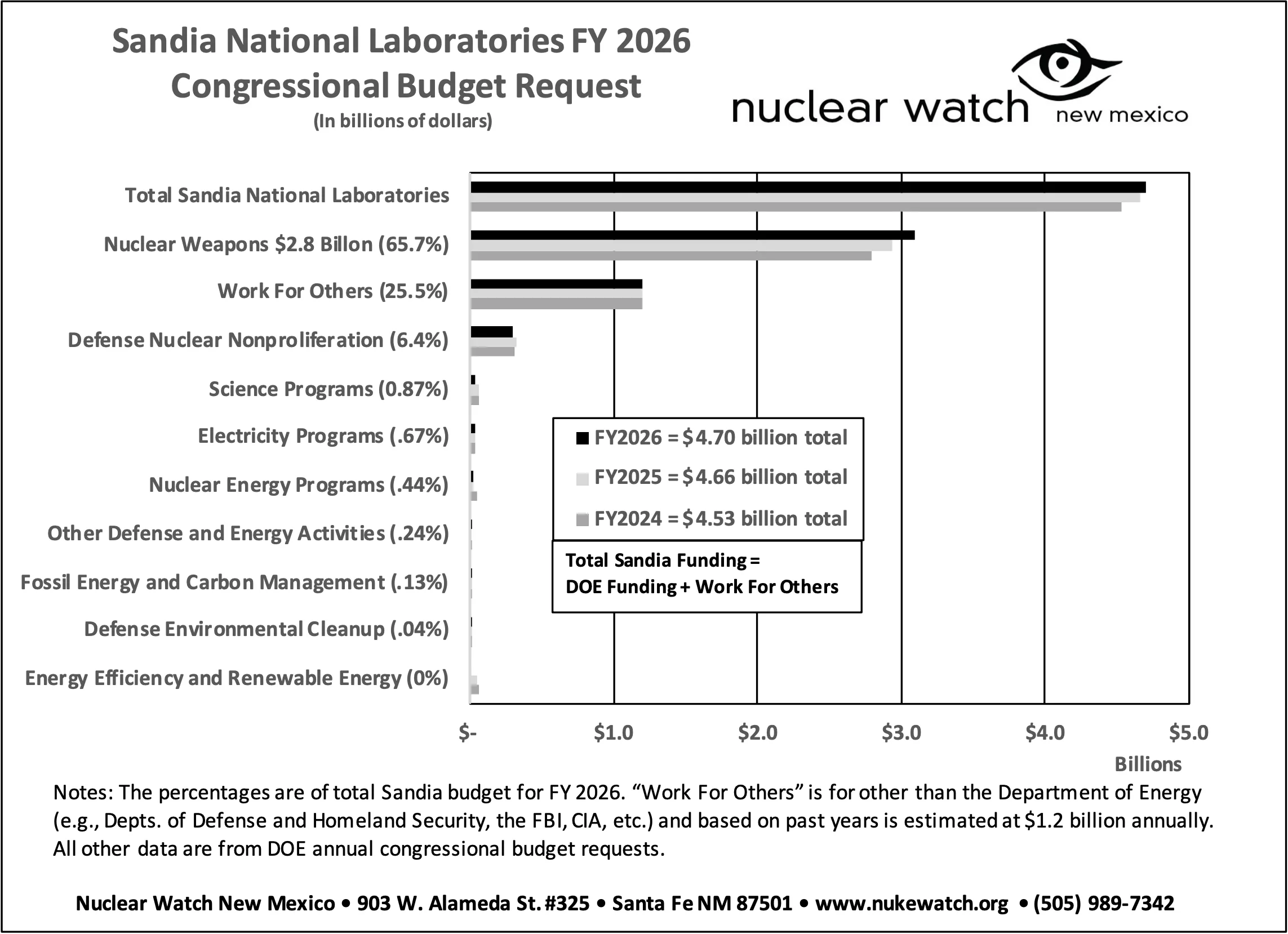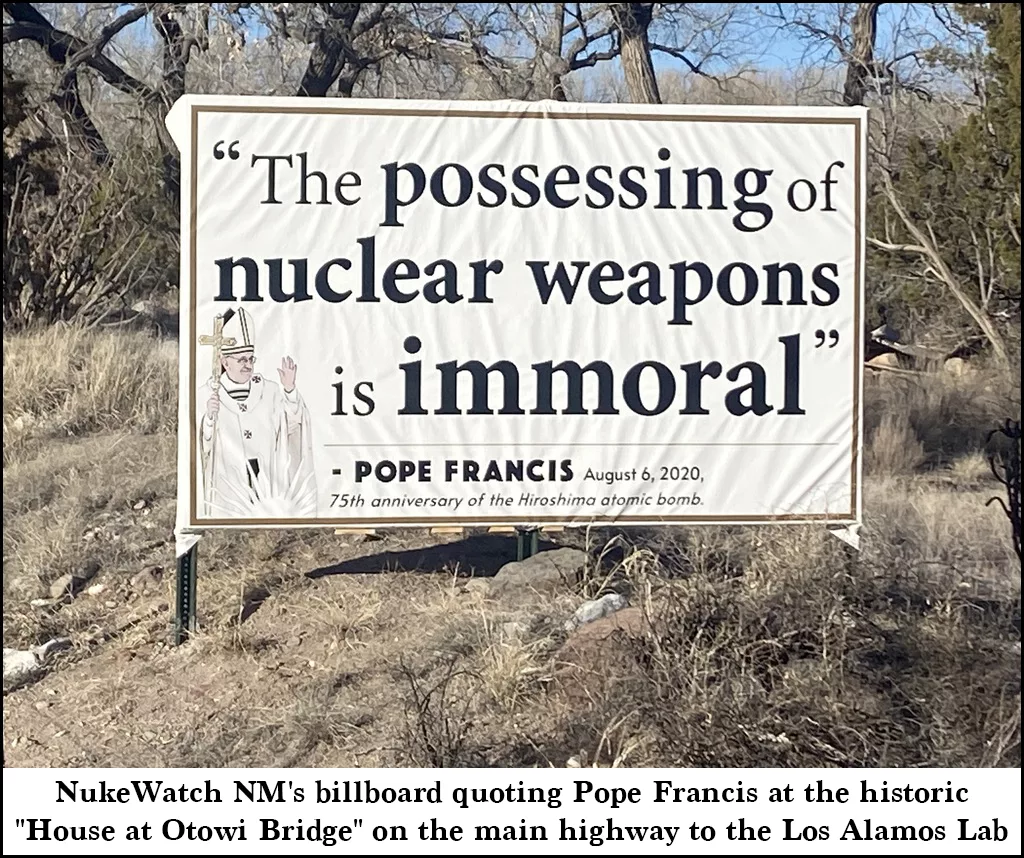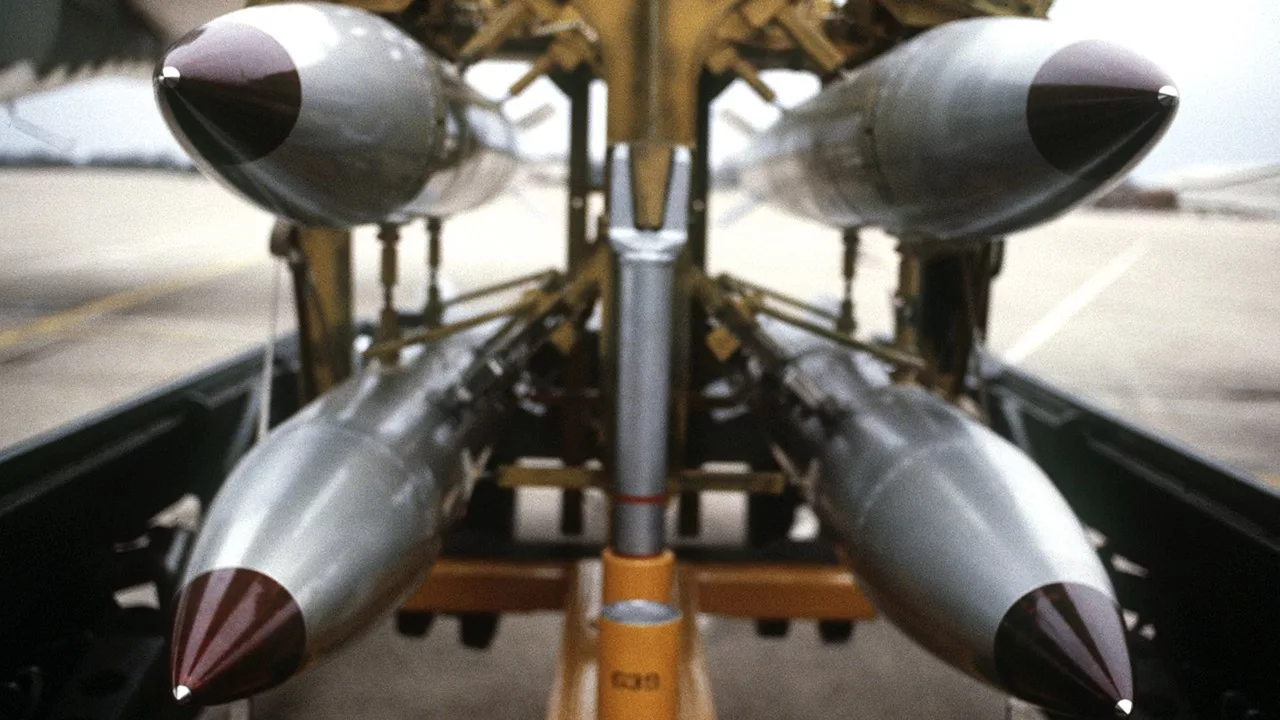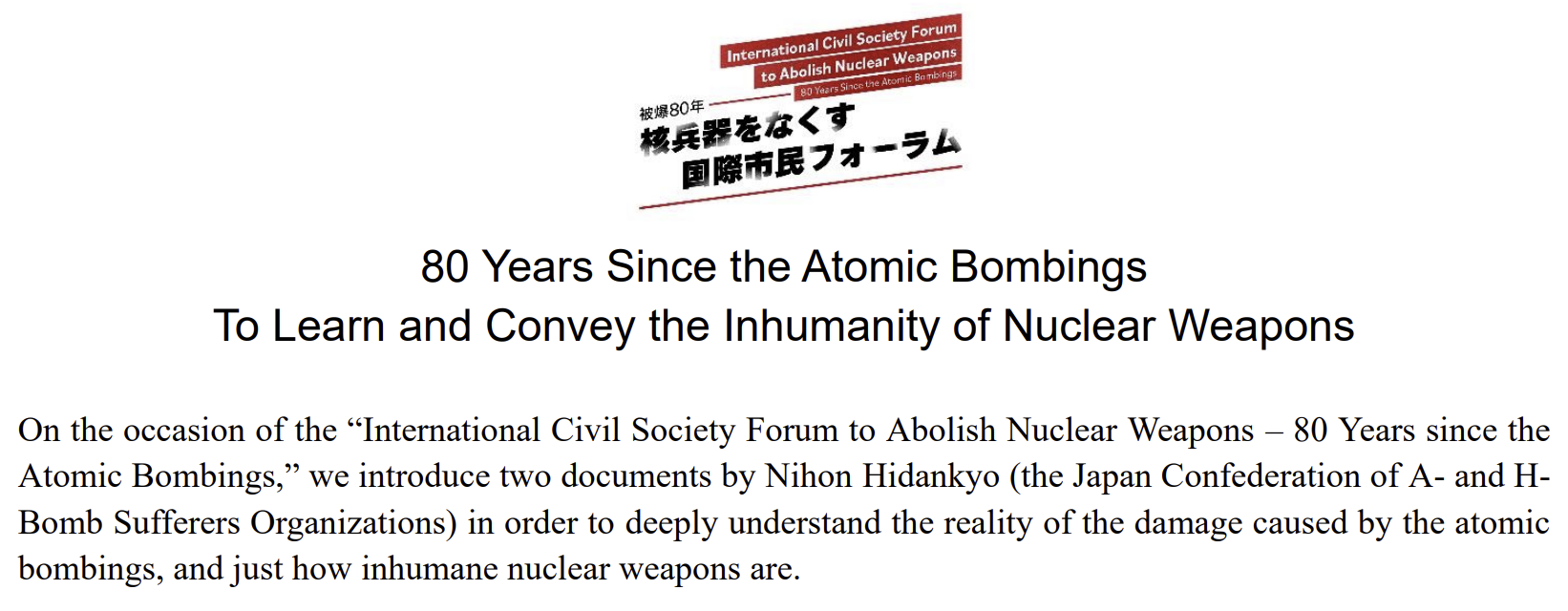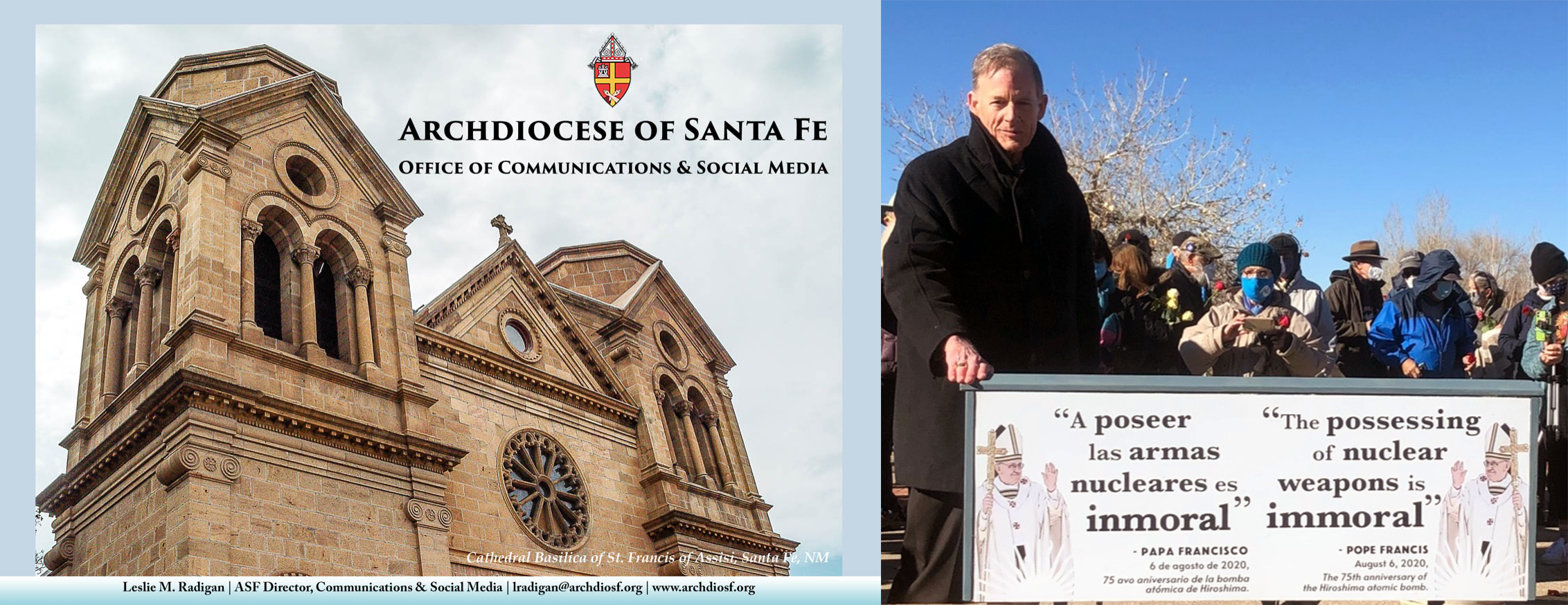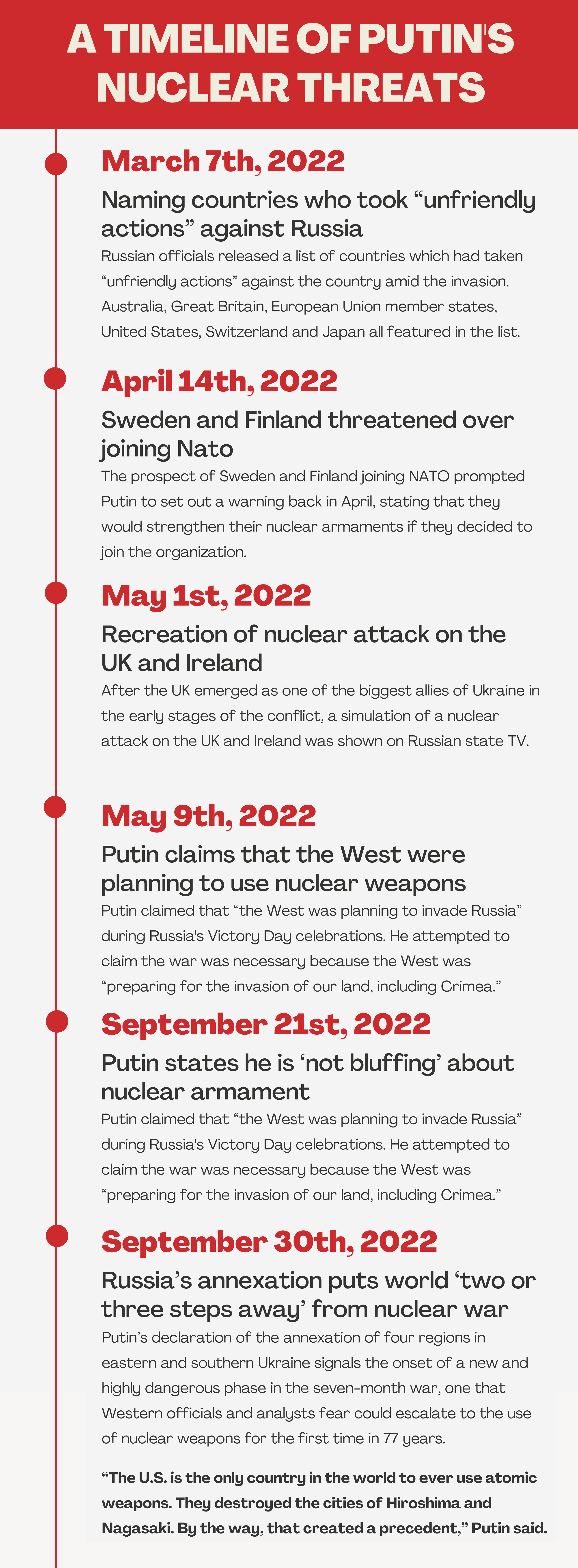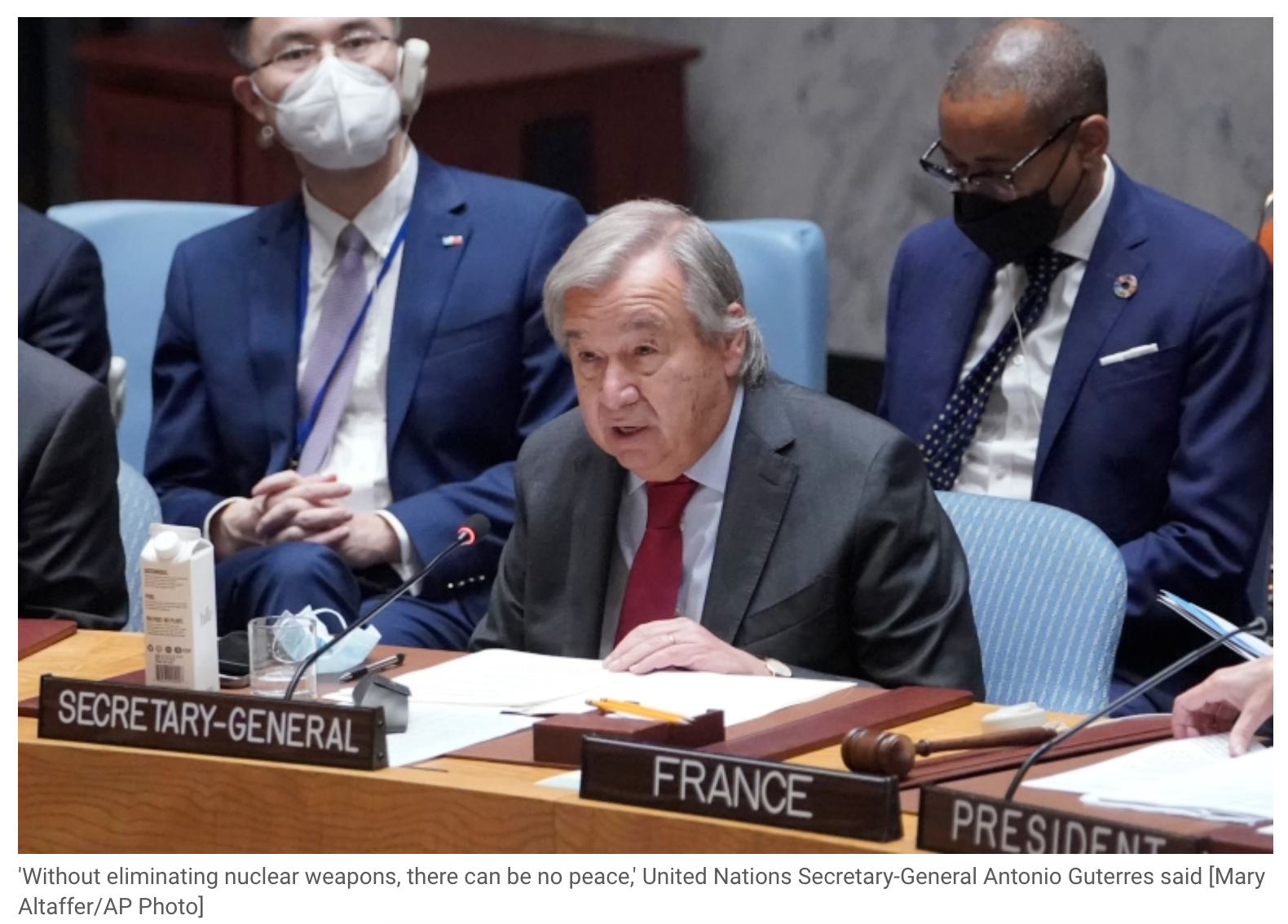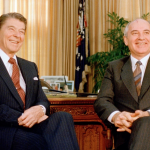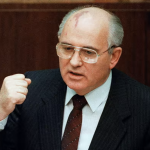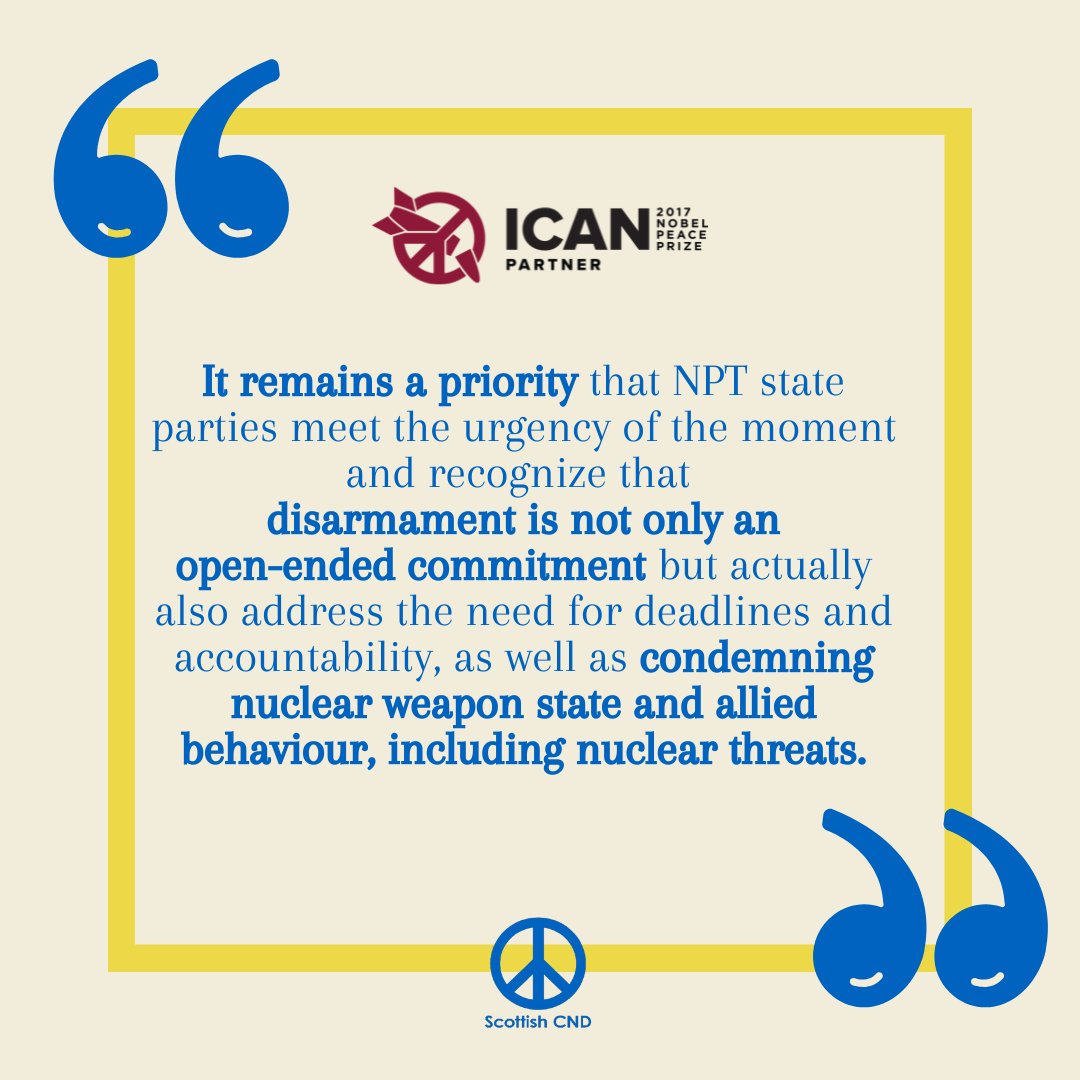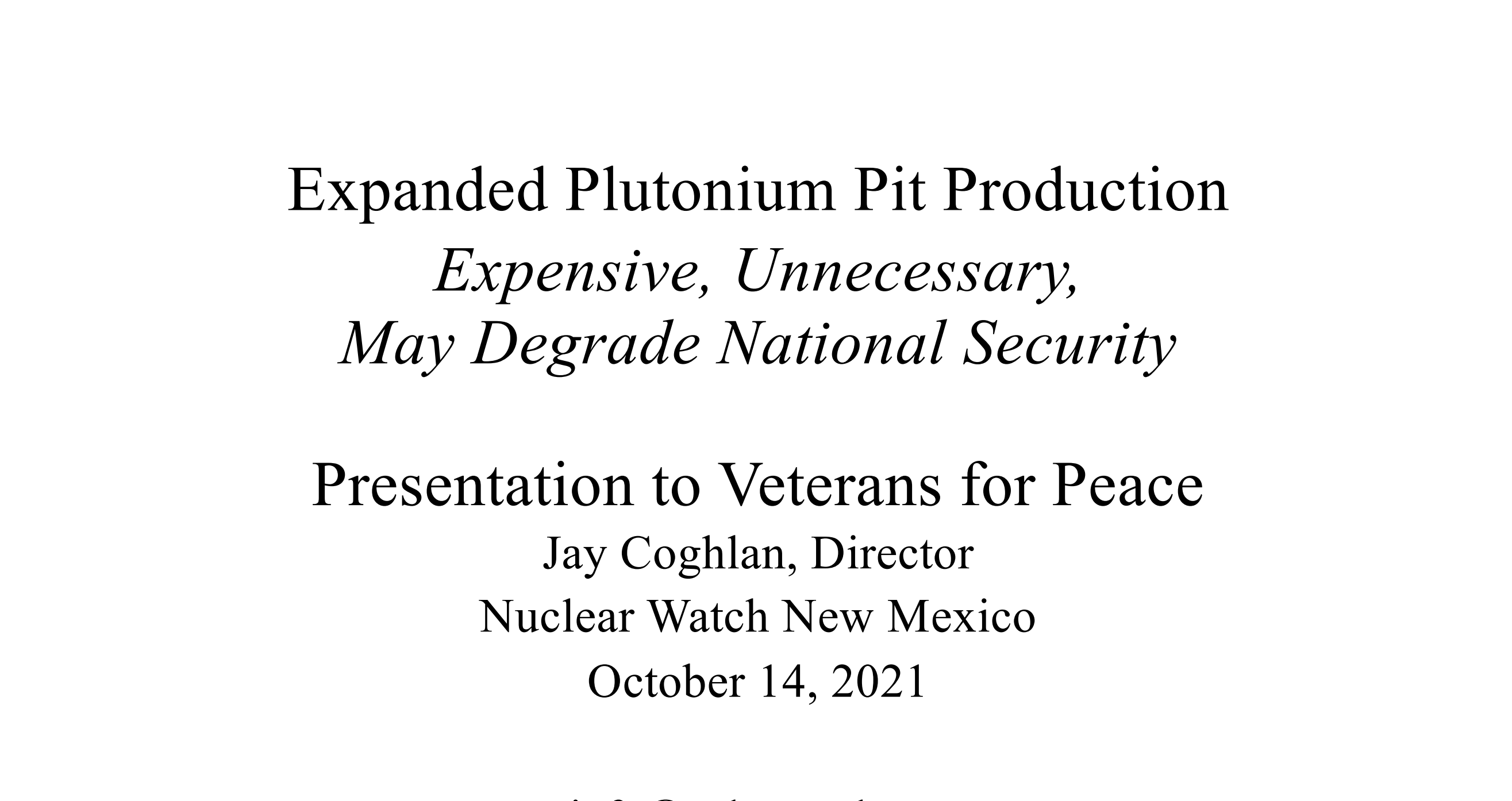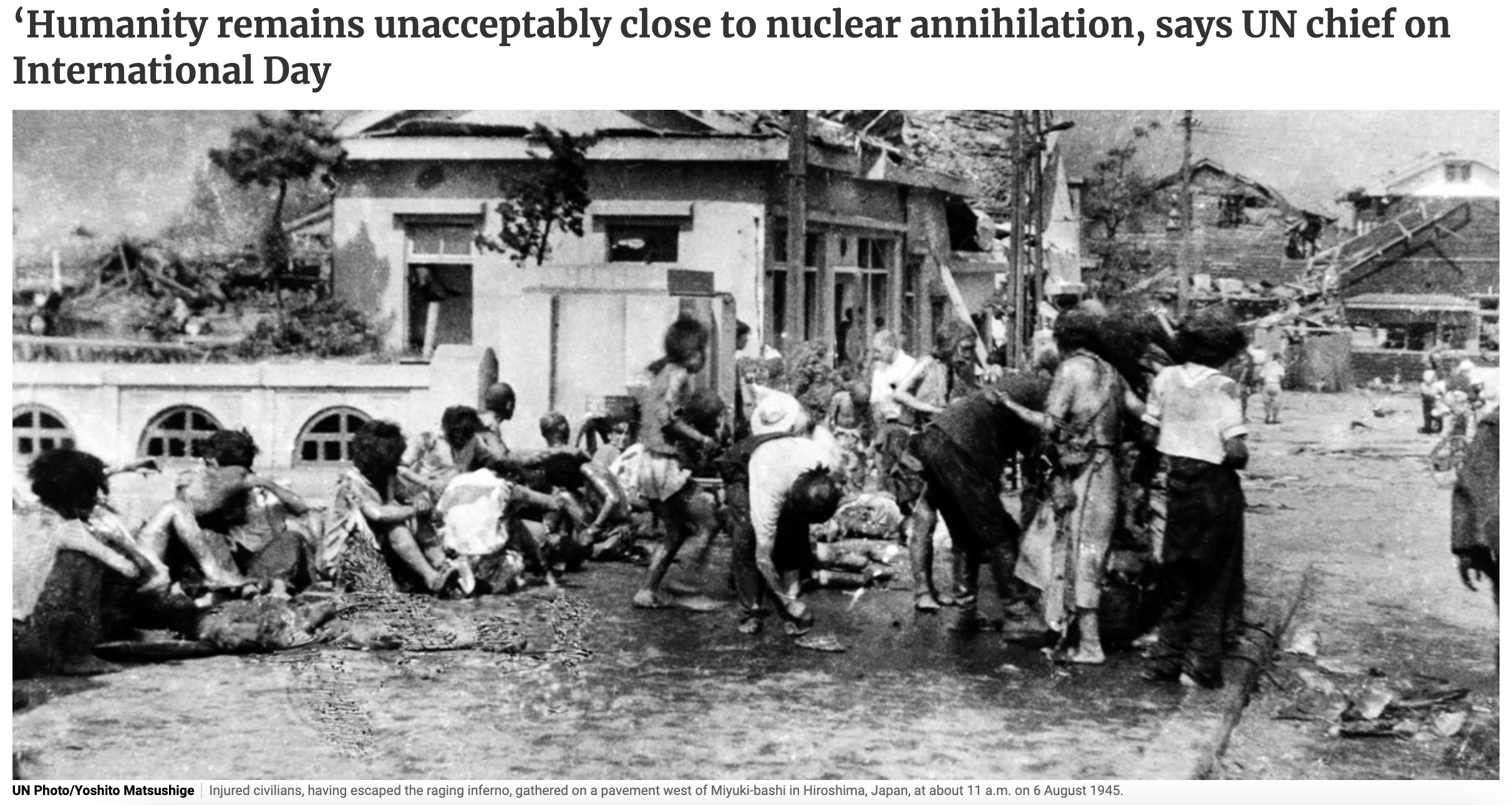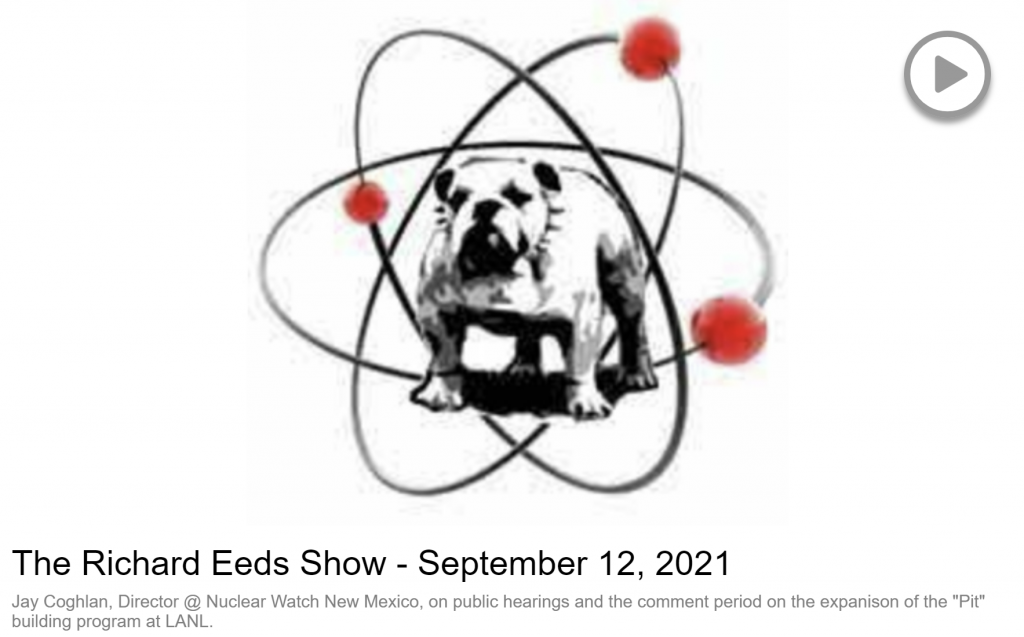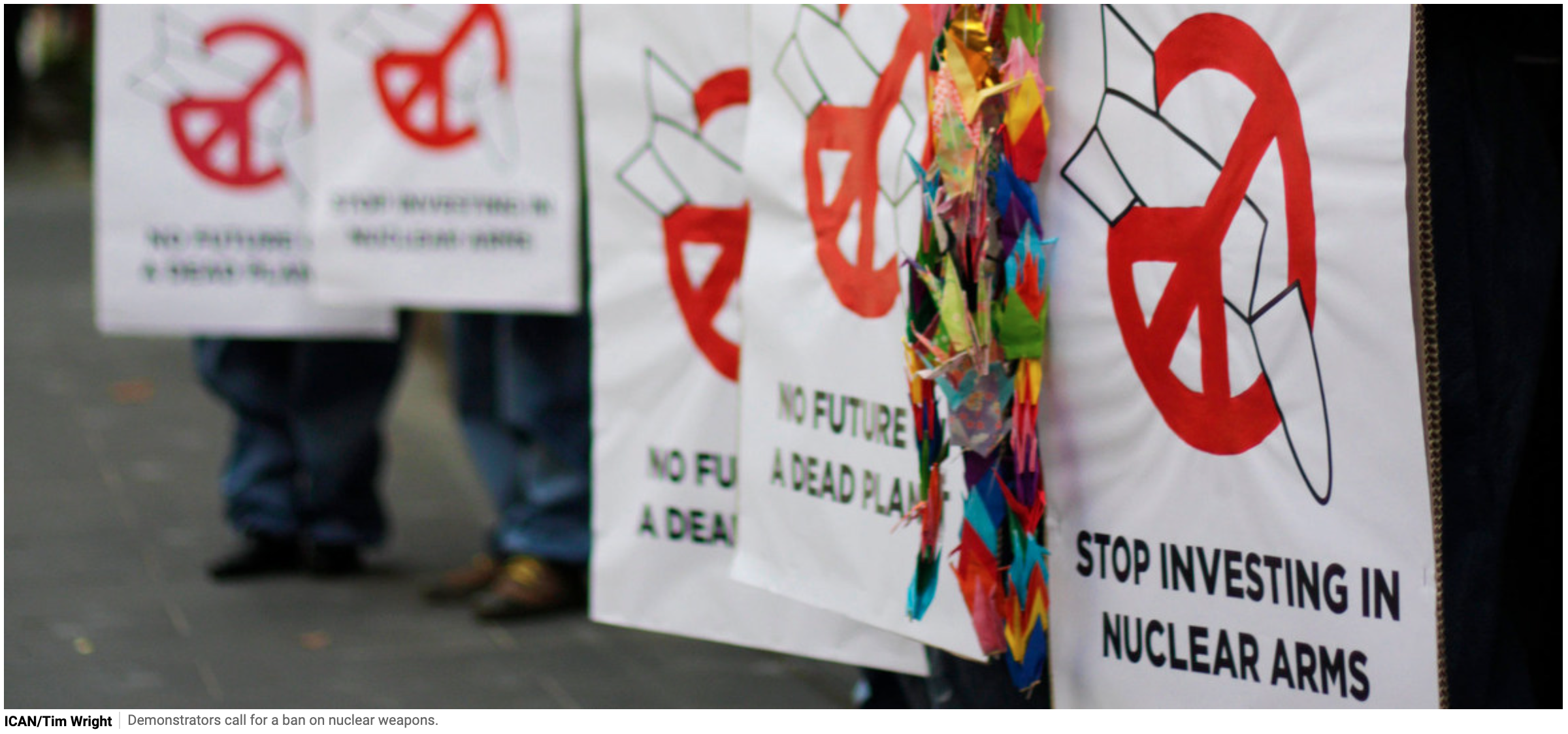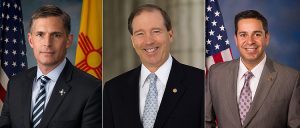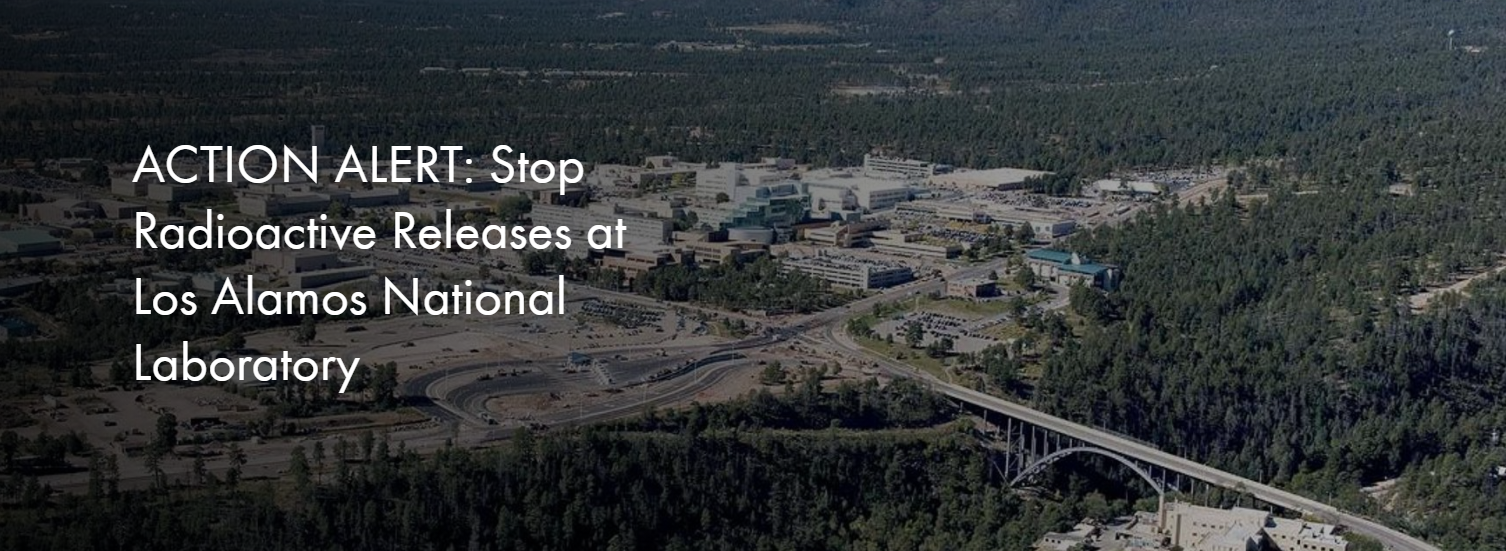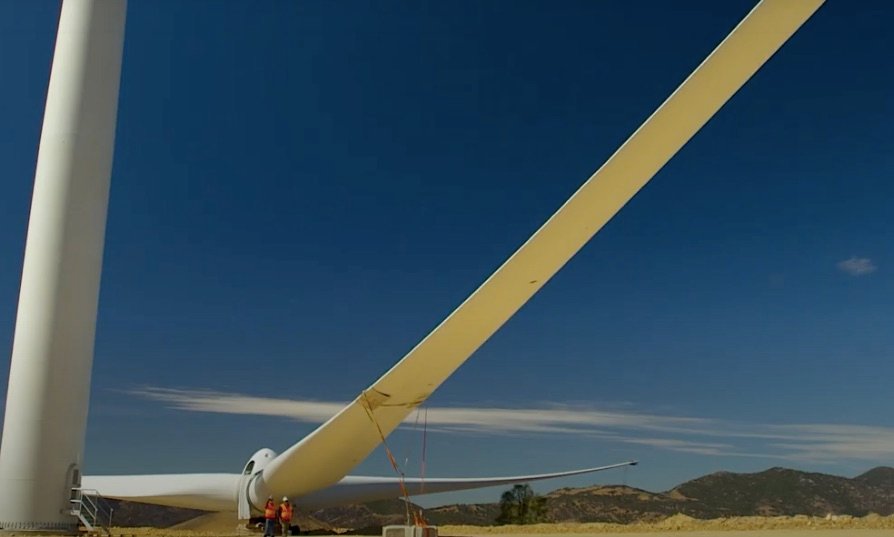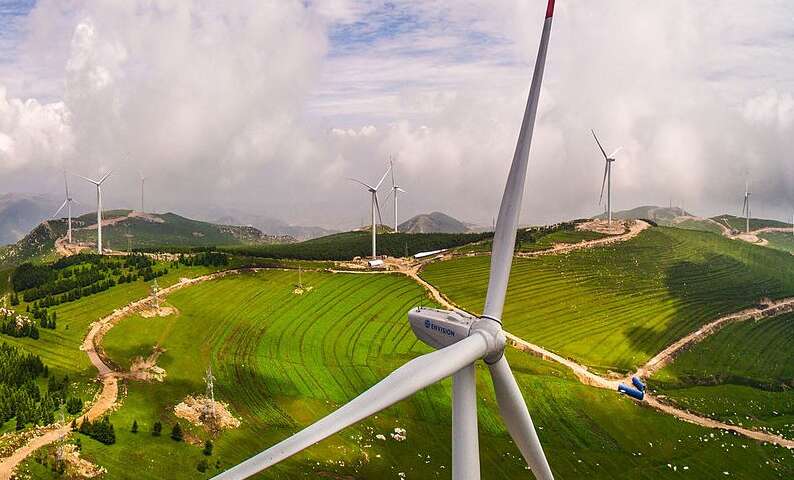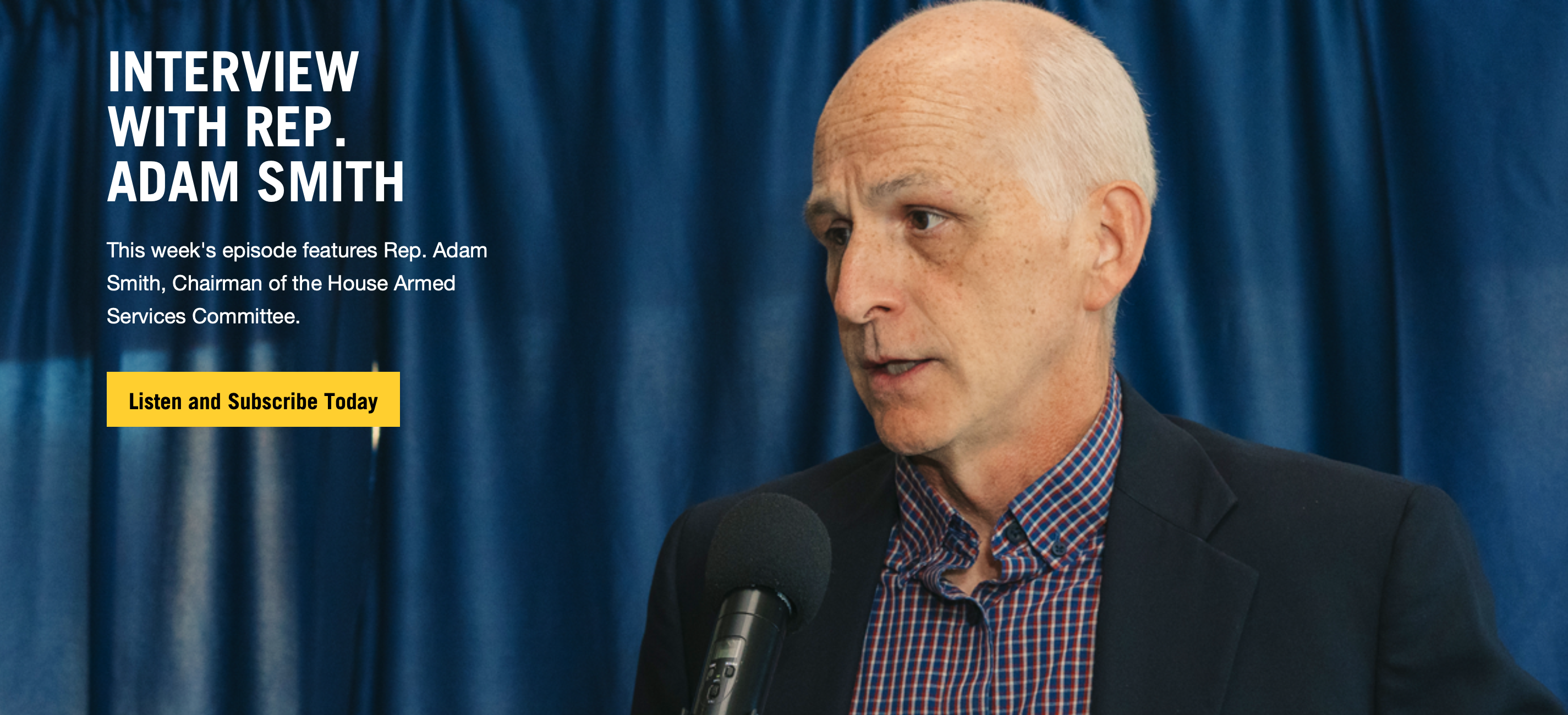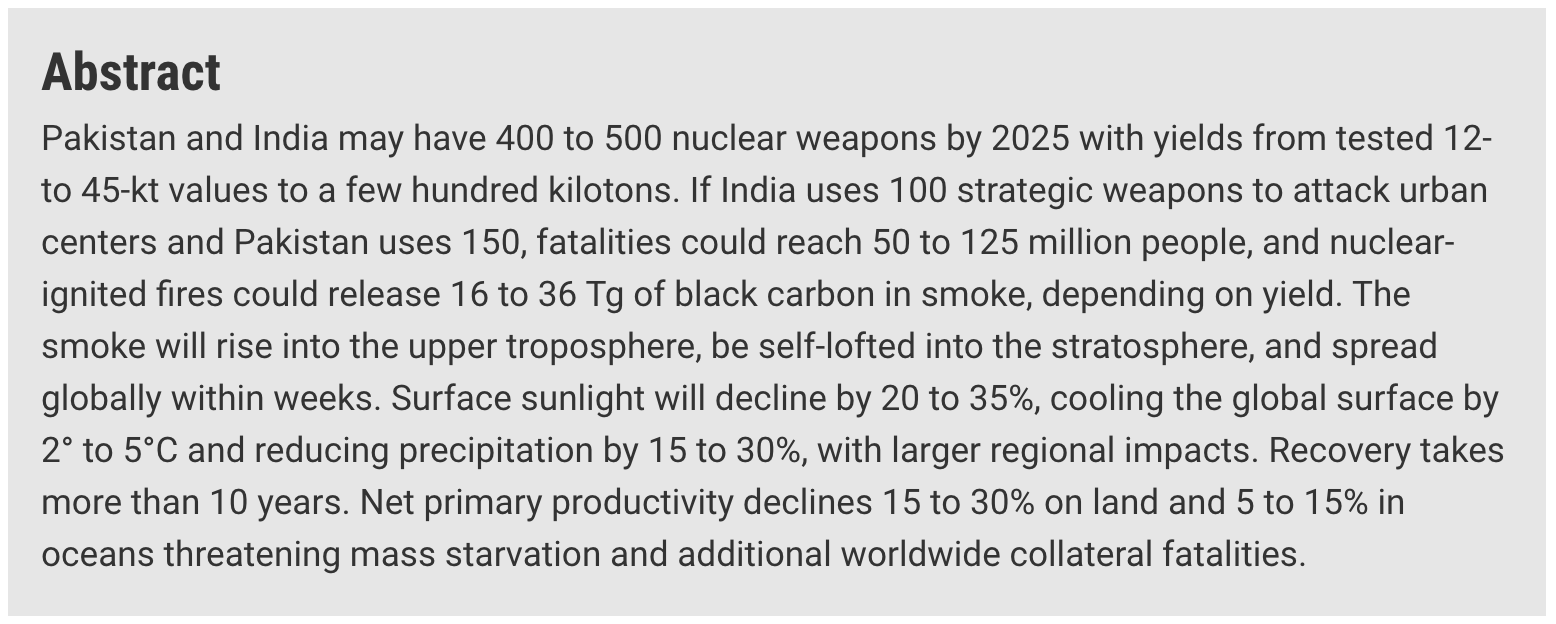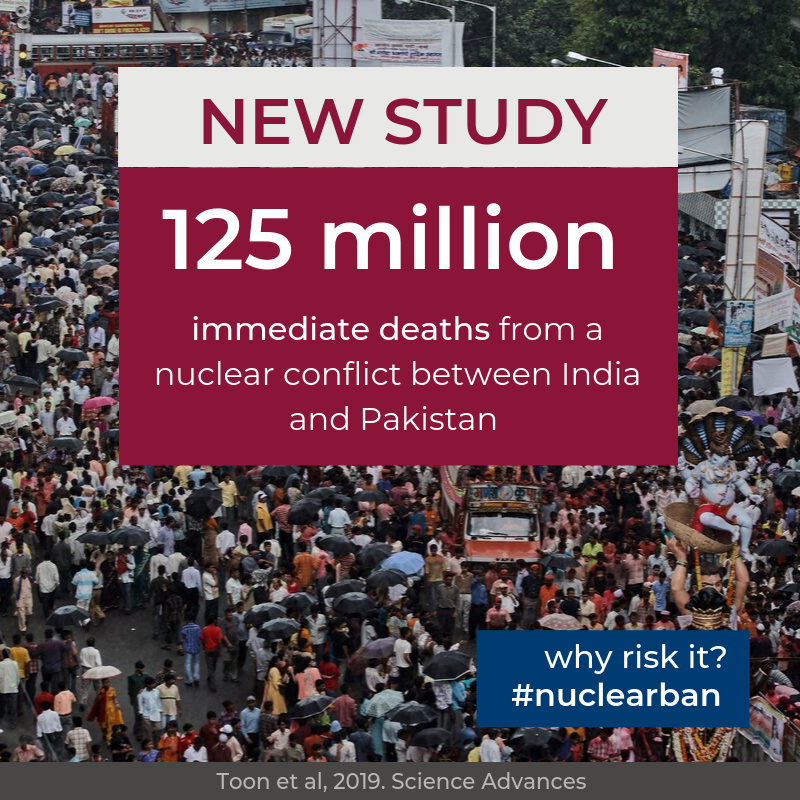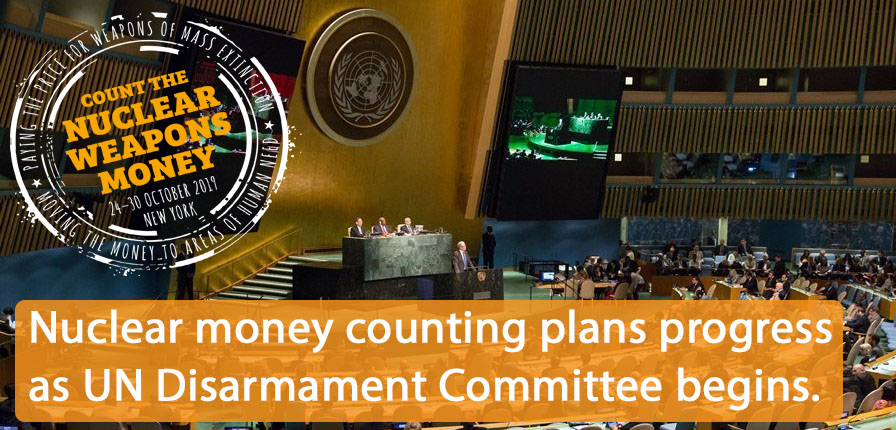2023 News Articles – All Posts
New Mexico reckons with its role in Japan’s atomic devastation on 80th anniversary of Hiroshima
At a Wednesday evening event organized by Nuclear Watch New Mexico, Archbishop John C. Wester of the Archdiocese of Santa Fe, long an outspoken advocate of nuclear disarmament, is set to celebrate Mass in Japan for victims with some other U.S. Catholic bishops and will participate in commemoration services. The event will be played by video at an event in Santa Fe.
By Cormac Dodd cdodd@sfnewmexican.com, The Santa Fe New Mexican | August 5, 2025 santafenewmexican.com
Wesley Burris remembers waking to a morning of potent, white light and panic as the planet’s first atomic bomb went off in a test in the Jornada del Muerto desert near his family’s Southern New Mexico home in July 1945.
He does not recall, however, hearing the news from Hiroshima and Nagasaki in Japan over the radio just weeks later. In fact, because the U.S. government did not tell his family what it was they saw that July, it was years before Burris realized how the Trinity Test he witnessed as a child served as a prelude to the world-altering bombings of Japan on Aug. 6 and Aug. 9, 1945.
Eighty years ago, the U.S. dropped a nuclear bomb on Hiroshima near the end of World War II, unleashing immediate death on a sweeping scale and rendering vast corridors in the southwestern Japanese city charred and fragmented, with buildings reduced to rubble with harrowing speed.
Santa Fe Archbishop Wester on RECA, Nuclear Weapons
80 years after nuclear bomb tested in N.M., victims will get reparations
NBC News NOW, July 16, 2025, nbcnewsnow.com
Trinity “downwinders” of New Mexico exposed to the first ever nuclear explosion are receiving recognition and compensation 80 years after the bomb was tested. NBC News’ Aaron Gilchrest spoke with several people who shared their sacrifice and suffering over the years.
An appreciation of Bob Alvarez, a fearless advocate for those harmed by the US nuclear weapons complex
By Michael Slater – The Bulletin of Atomic Scientists| July 10, 2025, thebulletin.org
SEE ALSO: THIS WONDERFUL TRIBUTE TO BOB ALVAREZ FROM BEYOND NUCLEAR & OTHERS: https://beyondnuclear.org/bob-alvarez-presente/
And view the Alliance for Nuclear Accountability’s Lifetime Achievement Awared given to Bob in 2022: https://ananuclear.org/bob-alvarez/
THE ATOMIC BOWL: Football at Ground Zero —and Nuclear Peril Today
First prize, Best Documentary Feature, International Uranium Film Festival, Rio de Janiero
Coming to PBS in July 2025. (53-minute and 27-minute versions).
There have been numerous films on The Bomb, even one or two about Nagasaki, but “The Atomic Bowl: Football at Ground Zero — and Nuclear Peril Today” is unique, and with many lessons and warnings for today–as nuclear dangers proliferate and civilian casualties in wars climb even higher.
This football showdown featured college and pro stars, on January 1, 1946, and in (of all places) Nagasaki, near ground zero for the second atomic bomb, which killed over 80,000 just a few weeks earlier. The film, narrated by Peter Coyote, is not only the first full first-hand account of the game, but a provocative and disturbing story of the decision to drop a second atomic bomb just three days after Hiroshima–and the dangerous message to today’s leaders. Nearly all of the victims of the “forgotten bomb” were women and children and other civilians.
This important film, which includes rare footage and dozens of never published photographs, then offers a convincing argument about the relevance of Nagasaki today as mass civilian casualties in wars surge and nuclear dangers by all estimates grow every year.
Its writer and director Greg Mitchell has been one of the world’s leading authorities on the atomic bombings for several decades, and his recent film, “Atomic Cover-up,” won several awards, including the top prize from the Organization of American Historians and was aired via PBS. His two other recent films, “The First Attack Ads” and the award-winning “Memorial Day Massacre,” also earned PBS distribution (as well as Emmy nods), and like “The Atomic Bowl” were produced by Academy Award nominee Lyn Goldfarb.
The Workers, the Waste, and the Warnings from Bomb Country
“From South Carolina to California, locals in nuclear weapons towns raise health, safety, and environmental concerns over renewed plutonium pit manufacturing.”
By: Taylor Barnes | June 12, 2025 inkstickmedia.com
The United States’ plans to restock its entire nuclear weapons arsenal, known in military parlance as nuclear “modernization,” hit a bump in the road in January. A scrappy coalition of grassroots watchdog groups and impacted communities from places like the Gullah/Geechee sea islands off the Georgia and South Carolina coasts and San Francisco Bay Area neighborhoods near a weapons laboratory sued the government agency that oversees the security of the US nuclear weapons complex.
The plaintiffs argued that the government was moving ahead with plans to produce new plutonium pits for warheads at plants in rural South Carolina and the Los Alamos laboratory in New Mexico without properly evaluating alternatives under the National Environmental Policy Act. A federal judge agreed, and the National Nuclear Security Administration (NNSA) settled with the grassroots groups, agreeing to perform a multi-year environmental analysis.
The extensive environmental impact study is a rare speed bump that everyday Americans have been able to place in the way of the 21st century’s new nuclear arms race — and one that forces the government to hear from locals in the specific communities across the country that produce parts for the weapons.
“A nuclear arms race can feel abstract and distant, but it very much isn’t,” Ravi Garla, a consultant for the Nuclear Threat Initiative, told Inkstick. Garla recently worked on a campaign that led to a unanimous vote in the Nevada state legislature to oppose any resumption of explosive nuclear tests at a desert site outside Las Vegas where the government carried out more than 900 tests during and after the Cold War.
Top photo: A billboard by an advocacy group opposed to nuclear weapons testing in Nevada (Courtesy of Nevadans Against Nuclear Weapons Testing)
TELEVISION EVENT Trailer
Television Event is a documentary that follows the dramatic (and sometimes humorous) making and impact of the film The Day After. The 1983 film played a pivotal role in shifting public consciousness around nuclear weapons and, ultimately, President Reagan’s policies. It’s a reminder on the power of art and storytelling to create meaningful change.
The documentary was also reviewed in The New York Times: https://www.nytimes.com/2025/05/30/movies/the-day-after-documentary-television-event.html
More:
In 2023 a book was publishedd about the making of “The Day After”, read the review in Arms Control Today: https://www.armscontrol.org/act/2024-03/book-reviews/apocalypse-television-how-day-after-helped-end-cold-war
As well as: “‘The Day After’: The Arms Control Association’s Forgotten Role.” <https://www.armscontrol.org/act/2019-03/features/day-after-arms-control-associations-forgotten-role> It is a reminder that a few people can, with some luck and good timing, put big things into motion.
Full Recording: Second Scoping Hearing for NNSA’s Programmatic Environmental Impact Statement on Plutonium Pit Production
Operation Crossroads: “The World’s First Nuclear Disaster”
“With Trump back in office, the recurring question of the need for nuclear weapons testing has resurfaced in the national security debate. Project 2025’s directive that the US return to ‘immediate test readiness’ raises further alarm, given the primacy of that document in Trump’s circle. The general uncertainty around current U.S. nuclear posture gives added weight to the historical importance of the atmospheric and underwater nuclear weapons tests conducted on the Bikini Atoll, recounted here by one of the leading advocates for public safety in the nuclear age. —Ed.”
By Robert Alvarez | Washington Spectator, National Security | May 29, 2025, washingtonspectator.com
Beginning in the late 1970’s, I was working for the Environmental Policy Institute around the time when atomic veterans started to descend on the nation’s capital. I would arrange meetings with Congressional offices, and the offices of both the Defense Nuclear Agency and Veterans Affairs, to enable the veterans to share their experiences and seek justice for being sent in harm’s way. About 250,000 soldiers, sailors, Marines, Coast Guard men, and airmen took part in atmospheric nuclear weapons tests from 1945 to 1963.
John Smitherman and Anthony Guarisco were 17- and 18-year-old sailors, respectively, in July of 1946, when they took part in “Operation Crossroads”—the first two nuclear weapons tests following World War II. These tests were conducted on the Bikini Atoll of the Marshall Islands and codenamed “Able” and “Baker.”
As a result of this extraordinary indifference to lethal danger, some 200 U.S. Navy ships were contaminated, and ships carrying radioactive fallout subsequently sailed to home ports in California. These ports are still being cleaned up today, nearly 80 years later. Glenn Seaborg, the chairman of the Atomic Energy Commission from 1961 to 1971, described the Baker test as “the world’s first nuclear disaster.”
Anthony and John were part of the U.S. Navy’s Pacific fleet involving 40,000 service men and 2,000 civilians. They along with others swam in the heavily contaminated Bikini Lagoon. When I met them in 1980, John was suffering from lymphatic cancer and Anthony from a severe form of spinal arthritis.
In March 1983, Anthony and his wife Mary showed up at my cluttered office and ceremoniously handed me a large stack of documents. They had just visited the UCLA library in Los Angeles and found boxes of forgotten, declassified documents belonging to Dr. Stafford Warren, the chief safety officer during both the Manhattan Project and the 1946 Crossroads tests.
Full Recording: First Scoping Hearing for NNSA’s Programmatic Environmental Impact Statement on Plutonium Pit Production
NEW Report on Plutonium Pit Production from the Union of Concerned Scientists
Today, UCS is releasing a comprehensive report on plutonium pit production. It includes a technical assessment of plutonium aging, a critical look at the weapons programs that new pits are slated for, and suggestions for alternatives, including pit re-use.
The final chapter of the study is on the human and environmental impacts of pit production and is intended as a tool for local advocacy groups to deepen their own work around issues such as the programmatic environmental impact survey that has just kicked off.
Links to the report:
https://www.ucs.org/resources/plutonium-pit-production
Spanish language executive summary:
https://es.ucs.org/recursos/la-produccion-de-nucleos-de-plutonio
NNSA issues plans to assess pits environmental impact
“This programmatic environmental impact statement that we fought long and hard for empowers citizens to tell policy makers what they think about decisions being made in their name,” Jay Coghlan, from environmentalist group Nuclear Watch New Mexico, said Thursday in a press release by the plaintiffs of the case. “Let them know what you think about the $2 trillion ‘modernization’ program to keep nuclear weapons forever while domestic programs are gutted to pay for tax cuts for the rich.”
By ExchangeMonitor | May 9, 2025 exchangemonitor.com
On the heels of a federal judge’s ruling last fall, the Department of Energy’s National Nuclear Security Administration formally announced plans Friday for a detailed review of environmental impacts of planned plutonium pit production.
DOE’s semi-autonomous National Nuclear Security Administration (NNSA) announced in the Federal Register it is kicking off a programmatic environmental impact statement EIS to ensure that large-scale pit production will comply with the National Environmental Policy Act (NEPA).
According to the Federal Register notice, NNSA will hold public meetings and public hearings as part of the process.
Two online public scoping meetings are now scheduled for May 27 and May 28. The May 27 session would commence at 5 p.m. Eastern Time while the May 28 one is scheduled to start at 7 p.m. Eastern. Both can be accessed online or by phone. Details can be found in the Federal Register notice.
A federal district judge ruled last September that DOE and NNSA did not adequately analyze the environmental effects of producing the radioactive cores that trigger nuclear weapons in two different states, but declined to put the pit program, including construction of the Savannah River Plutonium Processing Facility at Aiken, S.C.’s Savannah River Site on hold as a result. In January, the federal government and the plaintiffs, consisting of environmentalists, settled the lawsuit and agreed to leave Los Alamos National Laboratory as the sole pit factory until NNSA completes a nationwide, NEPA-compliant programmatic EIS.Continue reading
US nuclear firm ‘utterly crucial’ to national security expands East Tennessee operations
“Which company produces uranium fuel for U.S. Navy nuclear reactors and manages the only plant where the government disassembles atomic warheads? What about the company helping NASA to develop a nuclear rocket, all while building small modular reactors and developing a pilot plant to restart uranium enrichment for the military?”
By Daniel Dassow, Knoxville News Sentinel | May 5, 2025 newsbreak.com
It’s all the same answer: BWX Technologies , the $2.7 billion juggernaut better known as BWXT has embedded itself in every kind of nuclear project imaginable with a strong and growing presence in East Tennessee, where 1,100 employees at its Nuclear Fuel Services plant in Erwin “downblend” bomb-grade uranium. The facility also creates fuel for the nuclear reactors aboard U.S. Navy submarines and aircraft carriers.
The region is even more important to BWXT after it bought a specialized facility in Jonesborough and 97 acres in Oak Ridge for a centrifuge enrichment project the company says will create hundreds of jobs through millions of dollars in investments.
“We have availed ourselves as a key player in just about every interesting nuclear opportunity that you can think of,” BWXT President and CEO Rex Geveden told Knox News. “We’re all over it.”
BWXT is part of the team led by the Tennessee Valley Authority to build the first small modular nuclear reactors in the U.S. at the federal utility’s Clinch River Nuclear Site in Oak Ridge .
It will manufacture the reactor pressure vessel, the largest component of the 300-megawatt reactor designed by GE Hitachi Nuclear Energy , for small modular reactors in the U.S. and Canada.
Curb the Skyrocketing Cost of U.S. Nuclear Modernization
“Since Russia and the United States agreed 15 years ago to modest nuclear reductions under the New Strategic Arms Reduction Treaty (New START), they also have embarked on extraordinarily expensive campaigns to replace and modernize every component of their respective nuclear arsenals to maintain force levels and provide the option to build up.”
By Daryl G. Kimball, Arms Control Today | May 1, 2025 newsbreak.com

At the same time, their leaders have failed to resolve disputes about existing treaties or launch new negotiations to limit or further cut their deadly arsenals below the New START ceiling of 1,550 deployed nuclear warheads and 700 strategic missiles and bombers each.
In 2018, shortly after he withdrew the United States from the Intermediate-Range Nuclear Forces Treaty, U.S. President Donald Trump foolishly bragged about the nuclear stockpile that “until people come to their senses, we will build it up. It’s a threat to whoever you want, and it includes China, and it includes Russia, and it includes anybody else that wants to play that game.”
China has responded to U.S. nuclear and conventional military plans by pursuing a buildup of its historically “minimal” nuclear force to ensure that it retains an assured “second strike” capability. Russia has continued to develop new types of intermediate range missiles, as well as some new and exotic strategic systems designed to bypass U.S. missile defense capabilities.
Successive presidential administrations and congresses have failed to seriously consider alternatives that would have reduced costs and still maintained a devastating nuclear force.
Now, the cost of the U.S. nuclear modernization program is skyrocketing even further, siphoning resources from other more pressing human needs and national security priorities.
In April, the Congressional Budget Office issued its latest 10-year cost projection of the departments of Defense and Energy plans to operate, sustain, and modernize existing U.S. nuclear forces and purchase new forces: a total of $946 billion in the 2025-2034 period, or about $95 billion per year.
This new estimate is 25 percent, or $190 billion, greater than the last CBO estimate of $756 billion, which covered the 2023-2032 period. Incredibly, the $946 billion estimate does not include all of the likely cost growth of the new Sentinel intercontinental ballistic missile program, which the Pentagon acknowledged in July 2024 would cost 81 percent, or $63 billion, more than the program’s baseline estimate of $78 billion, generated in 2020.
University of New Mexico to host exhibit on nuclear history, technology, weapons
ALBUQUERQUE, N.M. (KRQE) — A provocative international exhibit will open soon at the University of New Mexico. “the bomb” is an immersive, multi-media installation exploring the history, technology, and threat of nuclear weapons.
By Nicole Sanders, KRQE | April 22, 2025 krqe.com
The installation includes an hour-long film projected on 45 screens conveying the hidden chaos and danger of the nuclear age. The experience is coming to UNM from April 30 to May 30. The full schedule at Zimmerman Library is available below:
- Wednesday, April 30
- Friday, May 2, 2025
- Friday, May 9, 2025
- Friday, May 16, 2025
- Friday, May 23, 2025
- Friday, May 30, 2025
Deterrence is the Threat: NukeWatch Presentation for Western New Mexico University – April 1, 2025
Calls to restart nuclear weapons tests stir dismay and debate among scientists
By Emily Conover, Science News | March 27, 2025 sciencenews.org
When the countdown hit zero on September 23, 1992, the desert surface puffed up into the air, as if a giant balloon had inflated it from below.
It wasn’t a balloon. Scientists had exploded a nuclear device hundreds of meters below the Nevada desert, equivalent to thousands of tons of TNT. The ensuing fireball reached pressures and temperatures well beyond those in Earth’s core. Within milliseconds of the detonation, shock waves rammed outward. The rock melted, vaporized and fractured, leaving behind a cavity oozing with liquid radioactive rock that puddled on the cavity’s floor.
As the temperature and pressure abated, rocks collapsed into the cavity. The desert surface slumped, forming a subsidence crater about 3 meters deep and wider than the length of a football field. Unknown to the scientists working on this test, named Divider, it would be the end of the line. Soon after, the United States halted nuclear testing.
Beginning with the first explosive test, known as Trinity, in 1945, more than 2,000 atomic blasts have rattled the globe. Today, that nuclear din has been largely silenced, thanks to the norms set by the Comprehensive Nuclear-Test-Ban Treaty, or CTBT, negotiated in the mid-1990s.
Only one nation — North Korea — has conducted a nuclear test this century. But researchers and policy makers are increasingly grappling with the possibility that the fragile quiet will soon be shattered.
Some in the United States have called for resuming testing, including a former national security adviser to President Donald Trump. Officials in the previous Trump administration considered testing, according to a 2020 Washington Post article. And there may be temptation in coming years. The United States is in the midst of a sweeping, decades-long overhaul of its aging nuclear arsenal…
Nuclear Nightmare: Meet America’s New B61-12 Gravity Bomb
What makes the B61-12 particularly impressive is the bomb’s ability to adjust its destructive yield depending on the operational conditions and demands.
By Stavros Atlamazoglou, National Interest | March 26, 2025 nationalinterest.org
Over the past months, the U.S. Air Force added another potent weapon to its arsenal: a new nuclear bomb, having recently completed production at Sandia National Laboratories in Albuquerque, New Mexico.
The B61-12 nuclear gravity bomb achieved full system production recently and is now fully operational. The nuclear bomb is one of the most versatile munitions of its type in the world, and a useful addition to the U.S. military’s nuclear deterrent capabilities.
The B61-12’s Unique Variable Yield Design
Sandia, one of the three main research and development laboratories for nuclear munitions, completed the production of the B61-12 nuclear gravity bomb. The nuclear munition is now fully operational.
What makes the B61-12 particularly impressive is the bomb’s ability to adjust its destructive yield depending on the operational conditions and demands. Put simply, the B61-12 is four bombs in one. The nuclear munition can be adjusted to four different yields—0.3, 1.5, 10, or 50 kilotons. The difference in yields means that the B61-12 has tactical, operational, and potentially even strategic utility.
Eight decades of nuclear threats are too much
Santa Fe New Mexican: My View John C. Wester
By John Wester, The Santa Fe New Mexican | March 15, 2025 santafenewmexican.com
I am John C. Wester, Archbishop of Santa Fe. I’m speaking on behalf of my archdiocese, and the archbishop of Seattle, the bishop of Hiroshima, and the archbishop of Nagasaki. We take guidance from our Holy Father, Pope Francis, who has declared the very possession of nuclear weapons to be immoral. We pray for his health.
Two years ago, in Nagasaki, on the 78th anniversary of its atomic bombing, we Catholic leaders formally created the Partnership for a World without Nuclear Weapons. Our four dioceses include the birthplace of nuclear weapons, the most deployed weapons in the United States, and the only two cities that to date have suffered atomic bombings. We lend our voices in staunch support of the Treaty on the Prohibition of Nuclear Weapons, at this Third Meeting of State Parties.
In July 2017, the Vatican was the first nation-state to sign and ratify the treaty. We note that the nuclear weapons powers have never honored their long-held obligations, under the 1970 Non-Proliferation Treaty, to enter into serious negotiations leading to global nuclear disarmament.
In contrast, the entry into force of the ban treaty was a great step toward the light of peace. The nuclear armed states have a moral obligation to hear the voices of the majority of the world, and to listen to those who are threatened by annihilation, at the whim of any one of their nine leaders.
The New York Times: DOGE Cuts Reach Key Nuclear Scientists, Bomb Engineers and Safety Experts
“Firings and buyouts hit the top-secret National Nuclear Security Administration amid a major effort to upgrade America’s nuclear arsenal. Critics say it shows the consequences of heedlessly cutting the federal work force.”
“The department has said that most of the fired employees handled administrative and clerical tasks that were not critical to the agency’s operation. But an analysis of the internal documents by The Times, coupled with interviews with 18 current and former agency officials, shows that is not true for the bulk of people who took the buyout,”
By Sharon LaFraniere, Minho Kim and Julie Tate, The New York Times | March 17, 2025 nytimes.com
…The Times reports that many had top-secret security clearance, giving them access to information on how nuclear weapons are made.
North Korea vows to ‘strengthen’ nuclear capabilities, rejecting G7 call for denuclearization
“The G7 called on Friday for North Korea to “abandon” its nuclear program.”
By Kevin Shalvey, ABC News | March 17, 2025 abcnews.go.com
LONDON — North Korea on Monday vowed to “steadily update and strengthen” its nuclear capabilities, a firm rejection of the G7’s call for Pyongyang to “abandon” its nuclear ambitions.
The country’s Foreign Ministry said that its “nuclear armed forces will exist forever as a powerful means of justice which defends the sovereignty of the state, territorial integrity and fundamental interests,” according to the Korean Central News Agency, a state-run media outlet.
How nuclear deterrence in Europe may change
“What does nuclear deterrence look like in Europe now that NATO is unsure whether the U.S. will be a committed partner? NPR speaks with Paul Cormarie, analyst with the Rand Corporation.”
By A Martínez, NPR | March 17, 2025 abcnews.go.com
Russia’s president, Vladimir Putin, says he supports a 30-day ceasefire with Ukraine in theory. But he adds that Ukraine would need to accept further conditions before a deal could be finalized. Now, in the interim, European leaders are discussing ways to discourage future Russian aggression. French President Emmanuel Macron has proposed using France’s nuclear capabilities as a deterrent to Russian threats. But what does nuclear deterrence look like in Europe if NATO is unsure if the U.S. will be a committed partner?
Hanford nuclear site subcontractor, owner to pay $1.1M for COVID loan fraud
“The money was intended to retain and maintain payroll for Hanford site workers assigned to the nuclear reservation in Eastern Washington and also a few Department of Veterans Affairs workers during the COVID-19 pandemic.”
“Within 48 hours of BNL receiving the Paycheck Protection Program loan at least $453,000 had been spent to pay off Stevenson’s personal and family debts, according to an indictment.
That included $100,000 transferred to Stevenson’s father and $48,600 to a family trust, according to court documents.
Much of the rest of the money was used to pay off credit card debt, according to the indictment.
The federal government later forgave the loan, which cleared it from having to be repaid.
BNL and Stevenson later applied for and received another Paycheck Protection Program loan of nearly $820,000.”
By Annette Cary, Tri-City Herald (Kennewick, Wash.) (TNS), The Columbian | March 12, 2025 columbian.com
Mar. 11—A former Hanford nuclear site subcontractor and its owner will pay a total settlement of just over $1.1 million to resolve accusations they defrauded the federal government through a COVID pandemic loan program.
On Wednesday, U.S. Judge Stanley Bastian in Yakima sentenced BNL Technical Services, owned by Wilson Pershing Stevenson III, to pay nearly $494,000 restitution to the federal government, as proposed in a settlement agreement.
That is in addition to $611,000 Stevenson, of Nashville, Tenn., already agreed to pay in a civil settlement to resolve his liability in the case.
Germany skips UN conference on banning nuclear weapons in New York
“Germany has decided not to take part in a UN conference in New York to review a landmark treaty on nuclear weapons prohibition.”
By dpa International | March 4, 2025 dpa-international.com
“The Treaty on the Prohibition of Nuclear Weapons dates back to a time before the Russian war of aggression against Ukraine,” the Foreign Office told dpa in Berlin on Tuesday. “The intention and ambition of the treaty no longer reflect the current reality in security policy.”
The treaty was signed in 2017 and came into force in 2021. There are currently 94 signatories and 73 states parties, according to the International Campaign to Abolish Nuclear Weapons (ICAN).
Germany does not possess nuclear weapons but is allied with three nuclear powers in NATO: the United States, France and the United Kingdom.
Berlin is not a signatory to the prohibition treaty, but it participated in previous conferences as observers.
Broken arrows: The hidden secret behind America’s missing nuclear weapons
“Dedicated Navy divers, demolition teams, and high-powered sonar spent weeks searching the ocean floor and came up empty.”
By Kaif Shaikh, Interesting Engineering | March 3, 2025 interestingengineering.com
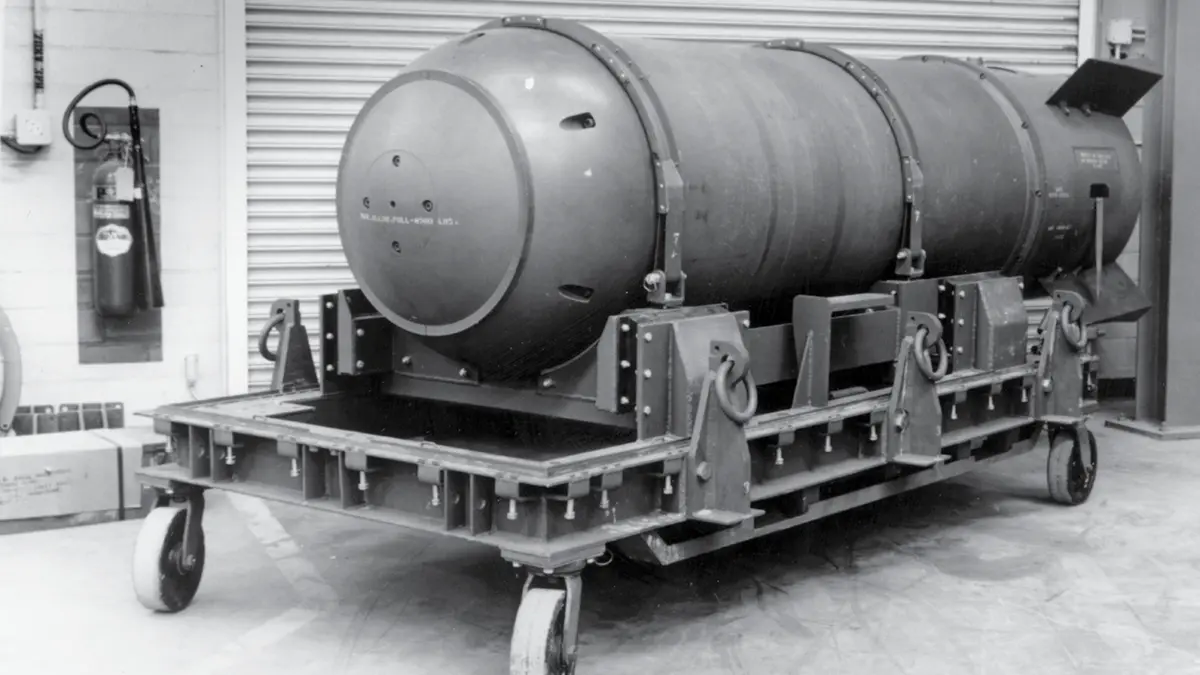
Throughout history, the idea of misplacing a nuclear weapon may sound like a plot twist in an espionage novel. The United States has experienced more than a handful of such incidents. Known as “Broken Arrows,” these events typically refer to any accidents involving nuclear weapons that do not pose an immediate risk of triggering a nuclear war.
For decades, details remained hidden behind top-secret clearances. However, unclassified records reveal that the U.S. military has had a surprising number of mishaps, with some bombs still unaccounted for to this day.
What are broken arrows?
The Department of Defense defines a “Broken Arrow” as any incident involving a U.S. nuclear weapon or warhead that results in accidental launching, firing, detonating, theft, or loss of the weapon. From 1950 to 1980, official sources cite 32 Broken Arrow incidents, but there may have been more, given the secrecy surrounding nuclear matters.
Christie Brinkley: Don’t let the US resume nuclear weapon tests that ended decades ago
“The United States and other nuclear powers are now moving closer to resuming nuclear weapons tests, decades after testing ended. This highly disturbing trend must be halted.”
By Christie Brinkley Special to The Kansas City Star Miami Herald | March 3, 2025 miamiherald.com
Since the atomic age, 2,056 nuclear weapons have been detonated, 528 of them above the ground. The United States and Soviet Union accounted for about 85% of these tests. The explosive power of atmospheric tests equaled 29,000 Hiroshima bombs. Airborne radioactive fallout circled the globe, re-entered the environment through precipitation, and entered human bodies through food and water.
Cold War bomb testing was part of a massive increase in the number of nuclear weapons, which peaked at more than 60,000. After nuclear war was barely avoided during the Cuban missile crisis, public pressure convinced leaders to ban all above-ground tests in 1963 — a treaty that has never been violated.
The test ban treaty was a huge achievement for peace, beginning eased tensions between nuclear nations. It also was a landmark for public health. A study by St. Louis residents and scientists found an enormous buildup of radioactive strontium-90 levels in baby teeth — 63 times higher in children born in 1963 compared to those born in 1950.
LISTEN LIVE TO U.S. SUPREME COURT ORAL ARGUMENTS ON THE ILLEGALITY OF LICENSING RADWASTE DUMPS IN TX AND NM
“The case pits the nuclear industry’s push for CISFs against the interests of fossil fuel companies which object to high-level radioactive waste dumped in their drilling/fracking areas, the state governments of Texas and New Mexico, which have passed laws prohibiting importation of nuclear waste to their states, and cities along the transport routes which object to it being shipped through their jurisdictions. Their amicus briefs in the case are posted here.”
For immediate release
MEDIA ALERT for Wednesday, March 5, 2025
WASHINGTON, D.C.,
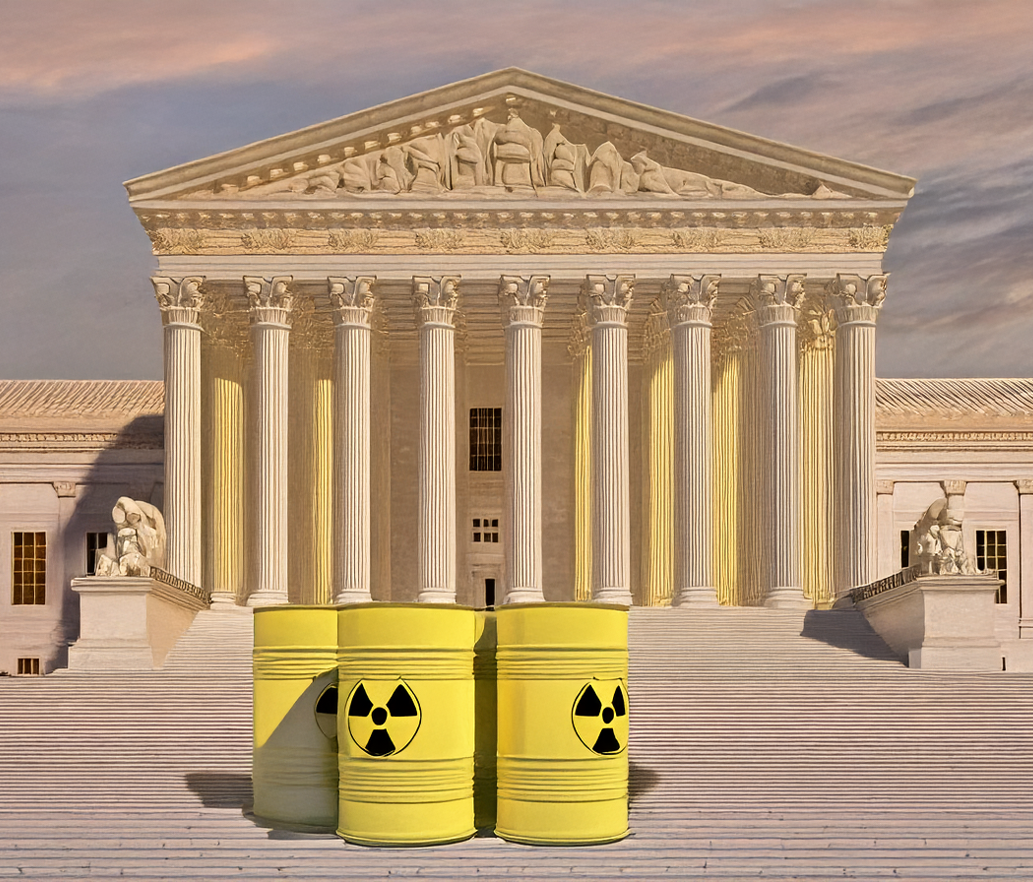 WHAT? Wednesday morning, March 5, the United States Supreme Court will hear oral arguments in Nuclear Regulatory Commission vs. Texas. At issue in the SCOTUS (Supreme Court of the U.S.) proceeding is whether the NRC exceeded its authority when it approved licenses for proposed “consolidated interim storage facilities” for high-level radioactive waste including highly irradiated “spent” fuel from nuclear power plants. Two CISFs are planned for western Texas and southeastern New Mexico. The Nuclear Waste Policy Act of 1982, as Amended specifically prohibits private “interim” storage of federal spent nuclear fuel, and disallows the Department of Energy from taking title to the waste (which would be necessary for DOE to transport it to CISFs), unless and until a permanent geologic repository is licensed, built and opened to receive the waste. The law intended to prevent private “interim” storage of federal radwaste, which is much less robust than permanent storage, and would double the risk of accident or attack during transport, since consolidated “interim” storage necessitates moving the waste twice, once to the CISF and again to a permanent repository. The NRC approved recent CISF license applications despite the law, saying it anticipated Congress would change it in the future. But the federal Fifth Circuit court ruled that the NRC didn’t have that authority. If the Supreme Court strikes that ruling down, it could open the floodgates for thousands of shipments of spent fuel from nuclear power plants across the US, through many states, to CISFs in Texas and New Mexico.
WHAT? Wednesday morning, March 5, the United States Supreme Court will hear oral arguments in Nuclear Regulatory Commission vs. Texas. At issue in the SCOTUS (Supreme Court of the U.S.) proceeding is whether the NRC exceeded its authority when it approved licenses for proposed “consolidated interim storage facilities” for high-level radioactive waste including highly irradiated “spent” fuel from nuclear power plants. Two CISFs are planned for western Texas and southeastern New Mexico. The Nuclear Waste Policy Act of 1982, as Amended specifically prohibits private “interim” storage of federal spent nuclear fuel, and disallows the Department of Energy from taking title to the waste (which would be necessary for DOE to transport it to CISFs), unless and until a permanent geologic repository is licensed, built and opened to receive the waste. The law intended to prevent private “interim” storage of federal radwaste, which is much less robust than permanent storage, and would double the risk of accident or attack during transport, since consolidated “interim” storage necessitates moving the waste twice, once to the CISF and again to a permanent repository. The NRC approved recent CISF license applications despite the law, saying it anticipated Congress would change it in the future. But the federal Fifth Circuit court ruled that the NRC didn’t have that authority. If the Supreme Court strikes that ruling down, it could open the floodgates for thousands of shipments of spent fuel from nuclear power plants across the US, through many states, to CISFs in Texas and New Mexico.
Expanded Plutonium “Pit” Bomb Production is Immoral – Spend Nuclear Weapons “Modernization” Money Ethically ELSEWHERE
Why the nation’s nuclear waste may eventually be headed to northwest Colorado
Nuclear waste is piling up at power plants around the country, and we have no idea where to put it. Many states are aggressively fighting plans for new storage facilities.
But northwest Colorado is quietly opening the door.
By In The NoCo, Scott Franz, Erin O’Toole, Brad Turner | February 22, 2025 kunc.org
KUNC’s investigative reporter Scott Franz recently traveled around rural Colorado talking with people about what nuclear waste storage could do for the local economy – and also interviewing folks who are dead set against that idea.
On this special edition of In The NoCo, we’ve combined all of Scott’s reporting from the past few months into a single episode. You can also see photos and check out more on this investigation.

Arms Control Association – Trump Regains Control Over Nuclear Policy: What’s Next?
It has been barely a month since Inauguration day, but it is apparent that Donald Trump is determined to reshape U.S. foreign policy, radically alter alliance relationships, and upend Washington’s approach toward key adversaries, like Russia, in ways that are not yet clear.
Arms Control Association | February 21, 2025 armscontrol.org
And here at home, Trump’s brash assertion of executive power is putting our nation’s democratic institutions and the rule of domestic law at risk, in part by altering or dismantling key government departments,agencies and functions, all without congressional approval.
All of this makes our mission to provide reliable information and sound policy solutions even more important and difficult.
The Arms Control Association has a clear and focused strategy to reduce the dangers posed by nuclear weapons and other WMD. Many of these priorities are outlined in this ACA-organized January 28 communication to all members of Congress that was endorsed by 16 of our partner organizations and leaders.
Like many others, however, we are still sorting out how to adjust to and contend with the post-Inauguration political dynamics.
But we must and we will, because critical, weapons-related security decisions lie ahead:
- So long as Russia’s assault on Ukraine continues, there is still a heightened risk of nuclear weapons use, and there are narrowing prospects for a deal to maintain limits on the U.S. and Russian nuclear arsenals after New START expires in one year.
- Although Trump has decried exorbitant military expenditures, the authors of Project 2025, the 920-page manifesto crafted by the Heritage Foundation and others, want the United States to spend even more than the current $756 billion ten-year price tag for nuclear modernization in order to increase the size and diversity of the U.S. arsenal. China and Russia are watching and will surely respond to any U.S. nuclear buildup.
- Project 2025 also calls for preparing to resume U.S. nuclear explosive testing for the first time since 1992. Should the United States do so, it would open the door to nuclear testing by other states, unravel the CTBT, and blow apart the global nonproliferation system at a time of increasing nuclear danger.
- Since Trump withdrew from the 2015 Iran nuclear deal, Tehran has expanded its capacity to produce weapons-grade nuclear material and reduced international inspectors’ access. Trump says he wants a nuclear deal; Iran’s president says he wants a nuclear deal. But time is short. Without a deal to scale back tensions and Iran’s nuclear capacity, we could see renewed international sanctions by October, Iranian withdrawal from the NPT, and/or an attempt by Israel to bomb Iran’s nuclear sites.
How exactly the second Trump administration and the new Congress will try to navigate all these nuclear-related challenges ahead is not yet clear — but if Project 2025 becomes the blueprint for U.S. nuclear weapons policy, we are in big trouble.
But, it may also be possible to steer us toward a safer course.
Trump wants to initiate denuclearization talks with Russia and China
On Thursday, President Donald Trump signaled that he wants to engage with Russia and China on denuclearization efforts.
By Erik English, BULLETIN OF ATOMIC SCIENTISTS | February 14, 2025 thebulletin.org
“There’s no reason for us to be building brand new nuclear weapons. We already have so many,” Trump said from the White House.
“You could destroy the world 50 times over, 100 times over. And here we are building new nuclear weapons, and they’re building nuclear weapons, and China’s building nuclear weapons.” The number of nuclear weapons the United States and Russia can have is established by New START, which expires in 2026. Without a new agreement, nuclear states could begin to build up their arsenals for the first time since the Cold War. “Hopefully, there’ll never be a time when we need those weapons,” Trump said. “That’s going to be a very sad day, that’s going to be probably oblivion.”
Share Your Experiences at Los Alamos National Laboratory
The New York Times would like to hear from you about workplace protocols and safety measures at LANL.
By Alicia Inez Guzmán | Alicia Inez Guzmán is reporting on the nuclear industry in New Mexico as part of The Times’s Local Investigations Fellowship – THE NEW YORK TIMES February 11, 2025 nytimes.com
More voices, better journalism. The questionnaire you are reading is just one tool we use to help ensure our work reflects the world we cover. By inviting readers to share their experiences, we get a wide range of views that often lead to a more deeply reported article. We make every effort to contact you before publishing any part of your submission, and your information is secure. Here’s more on how it works and why it’s good for us and you.
The Los Alamos National Laboratory (LANL) has recently embarked on the “new Manhattan Project” — a hiring spree and multibillion dollar expansion to build plutonium bomb cores for nuclear weapons.
The Times is writing about this new mission and how the lab is keeping workers safe, reporting accidents and environmental contamination and making needed upgrades to key facilities, including in Technical Area 55, the heart of bomb core production.
Have you or someone you know worked at TA-55 or another “hot site” and experienced a workplace accident or been exposed to plutonium, beryllium or another radioactive or toxic substance on the job? What safety measures were in place? Were there follow-up health assessments?
Please answer the questions using the form:
Gearing Up for the Public Hearings on the LANL Draft Sitewide Environmental Impact Statement: Pit Production at LANL
“Nuclear Watch New Mexico hosted a workshop on February 6 on the newly released Draft Sitewide Environmental Impact Statement (SWEIS) for Los Alamos National Laboratory (LANL) to present information and elicit discussion on this NEPA process that Jay Coghlan, executive director of Nuke Watch, referred to as a “rigged game” at the beginning of the workshop. What that means will become evident as I review the part of the workshop I attended.”
By Kay Matthews, La Jicarita | February 7, 2025 lajicarita.wordpress.com
Archbishop John Wester, an outspoken critic of nuclear weapons proliferation under the guise of nuclear deterrence instead of disarmament spoke briefly to open the discussion. Quoting Pope Francis, he said, “possessing nuclear weapons is immoral.” He then said, “Pit production is immoral.” His only qualification is that it’s the policy that’s immoral, not the people who promote it. We’ve failed to uphold already existing treaties and failed to implement new ones. He’ll be going to the United Nations in March for a meeting, Treaty on the Non-Proliferation of Nuclear Weapons, and to Japan in August to meet with his partners in the World Without Nuclear Weapons.
Coghlan explained that next week the Department of Energy (DOE) and the semi-autonomous National Nuclear Security Administration (NNSA) will hold public hearings, as required by NEPA, on the LANL SWEIS, in Santa Fe, Española, and Los Alamos. He cautioned that while we should all be “cynical” about the process, we need to go ahead and protest the fact that all three alternatives provided in the SWEIS expand pit production, just at different amounts. The process is rigged because the DOE and NNSA failed to update a 2008 Environmental Impact Statement before pit production began at LANL (the other nuclear facility, the Savannah River Site in South Carolina, is slated to produce 50 pits a year but is completely unprepared for pit production).
The guest speaker was Dylan Spaulding, Senior Scientist for the Union of Concerned Scientists…
In Memoriam: Ken Mayers
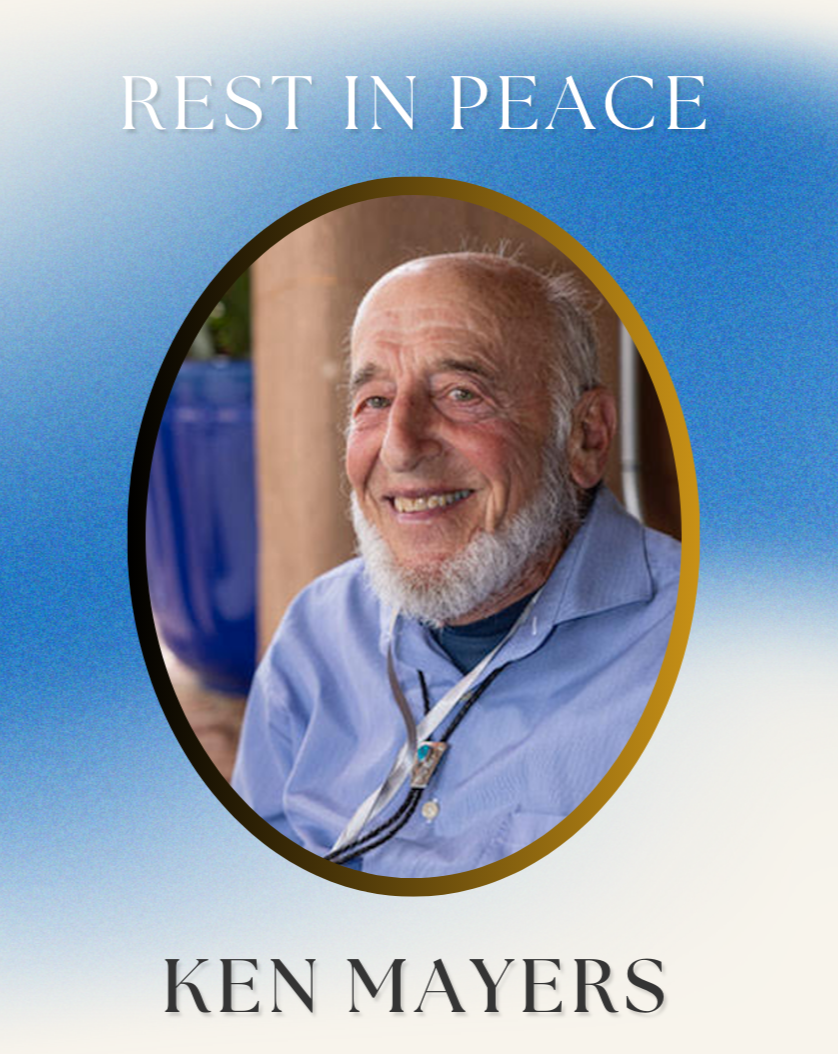 We here at NukeWatch will dearly miss Ken’s weekly presence at the corner vigil to protest Nuclear Weapons in Santa Fe.
We here at NukeWatch will dearly miss Ken’s weekly presence at the corner vigil to protest Nuclear Weapons in Santa Fe.
Locally, Ken was co-founder of the Santa Fe Chapter of Veterans for Peace and an active member of Santa Feans for Justice in Palestine. Ken worked with the local chapter of US Combatants for Peace and the Justice Council of the Unitarian Universalist Congregation in Santa Fe where he was also an enthusiastic baritone and co-founder of the NM Peace Choir.
A Celebration of Ken’s life will be held Friday, April 4 beginning at 12 noon at the corner of Sandoval and West Alameda, (Santa Fe’s weekly vigil to protest Nuclear Weapons), followed by lunch and a hybrid service at the UU Congregation, 107 West Barcelona Street, Santa Fe, NM.
For those wanting to pay tribute to Ken, please consider planting a tree through A Living Tribute (https://shop.alivingtribute.org/) or make a donation in his memory to the Santa Fe Joan Duffy Chapter of Veterans for Peace https://www.vfp-santafe.org/
Ken was a lifelong, passionate defender of peace. Read more:
Los Alamos’ plutonium pit production of 30 annually for Sentinel may have to wait beyond 2026
As the Department of Energy’s National Nuclear Security Administration awaits its marching orders from the President Donald Trump (R) administration, the Los Alamos National Laboratory is now saying it will get to an annual plutonium pit production goal of 30 “ASAP.”
Exchange Monitor | January 31, 2025 counterpunch.com
Such pits are the triggers for thermonuclear weapons…
Step inside the secret lab where America tests its nukes
“”The risk is significant,” says Hans Kristensen, director of the Nuclear Information Project at the Federation of American Scientists. The talk of testing comes at a time when nuclear weapons are resurgent: Russia is designing nuclear weapons to attack satellites and obliterate seaports; China is dramatically expanding its nuclear arsenal; and the U.S. is undergoing a major modernization of its nuclear warheads. After years of declining nuclear stockpiles, the world looks poised to begin increasing the number and types of nuclear weapons being deployed.”
By Geoff Brumfiel, NPR | January 29, 2025 npr.org

A half-mile from here, on the morning of May 8, 1953, an Air Force bomber dropped a Mk-6D nuclear bomb from a height of 19,000 feet above the desert floor. It exploded with a yield of 27 kilotons of TNT — creating a shockwave that warped the bridge. The test, code-named “Encore,” was one of several conducted here to see what, if anything, in the civilian world could survive a nuclear blast (the answer is, apparently, not much).
Continue reading
Exchange Monitor: Compromise reached on pit production suit environmental review
“The National Nuclear Security Administration and environmental plaintiffs settled a lawsuit that could put a pause on plutonium pit production efforts at Savannah River Site if approved.”
By Exchange Monitor | January 29, 2025 exchangemonitor.com
The agreement, made public Jan. 16, would leave Los Alamos National Laboratory as the National Nuclear Security Administration’s (NNSA) sole pit factory until an environmental impact statement is completed as part of the National Environmental Protection Act (NEPA). The process is expected to take at least two-and-a-half years, according to the document.
Until a record of decision is issued from the environmental review, NNSA is enjoined from installing classified equipment or introducing nuclear material at the Savannah River plant, according to a press release from the citizen groups. Actual pit production at Savannah River is not expected before the 2030s, according to NNSA.
The plaintiffs alleged in the lawsuit from 2021 that NNSA and DOE would violate NEPA by producing plutonium pits at Los Alamos and Savannah River Site without conducting a proper environmental review. A federal judge agreed with the plaintiffs in September, but instigated months of back and forth between both parties by forcing them to agree to a solution themselves.
The settlement requires NNSA to produce a new programmatic environmental impact statement within two-and-a-half years. Until that is complete in a process that would include public hearings nationwide and public comment on the draft of the statement, NNSA would not be able to process nuclear material at Savannah River’s plutonium facility.
The plaintiffs in the suit include environmental watch group Savannah River Site Watch of South Carolina; Tom Clements, director of Savannah River Site Watch; The Gullah Geechee Sea Island Coalition, a group representing the interests of some descendants of enslaved Africans dwelling on the lower Atlantic coast; Nuclear Watch New Mexico of Santa Fe, N.M.; and the Tri-Valley Communities Against a Radioactive Environment, of Livermore, Calif.
2022 Select Highlighted Press Items
Nuclear Modernization is the ’Absolute Minimum,’ STRATCOM Commander Says | March 8, 2022
US tested hypersonic missile in mid-March but kept it quiet to avoid escalating tensions with Russia | April 4, 2022
Putin’s Nuclear Threats Are a Wake-Up Call for the World | March 15, 2022
Intelligence report determines that Russia's WMD threats will grow as losses mount in Ukraine | March 19, 2022
China and the United States: It’s a Cold War, but don’t panic | March 10, 2022
Russian military doctrine calls a limited nuclear strike “de-escalation.” Here’s why. | March 8, 2022
North Korea says it will strike with nuclear weapons if South attacks | April 4, 2022
Flying Under The Radar: A Missile Accident in South Asia | April 4, 2022
2022 News Articles
‘Nuclear accident’ warnings amid Russia missile strikes
By Paraic O’Brien | October 6, 2022 channel4news.com
Russia has faced weeks of military defeats in Ukraine, but today brought a reminder its military is still able to cause substantial destruction.
Overnight, and again this morning, the city of Zaporizhzhia suffered a series of missile attacks, including a direct strike on a residential apartment building.
The strikes raised concerns for the nearby nuclear power plant, leading to a warning from the International Atomic Energy Agency that an accident there is “a very clear possibility”.
NY TIMES: I’ve Studied 13 Days of the Cuban Missile Crisis. This Is What I See When I Look at Putin.
By Michael Dobbs, The New York Times | October 5, 2022 nytimes.com
Two nuclear-armed states on a collision course with no obvious exit ramp. An erratic Russian leader using apocalyptic language — “if you want us to all meet in hell, it’s up to you.” Showdowns at the United Nations, with each side accusing the other of essentially gambling with Armageddon. For six …
Los Alamos National Laboratory’s pit production a year behind schedule
“Jay Coghlan, executive director of Nuclear Watch New Mexico, said the lab has a history of delays and cost overruns that predates the pandemic.
“I suspect LANL and [the federal government] are using COVID as a convenient excuse for what’s going to happen anyway,” Coghlan said. “I’m certainly not saying there was no delay for COVID, but I doubt this much.”
Coghlan said the revelation is significant because it’s the first official confirmation the Los Alamos lab is running behind schedule with its planned pit production.”
BY SCOTT WYLAND, THE SANTA FE NEW MEXICAN | October 5, 2022 santafenewmexican.com
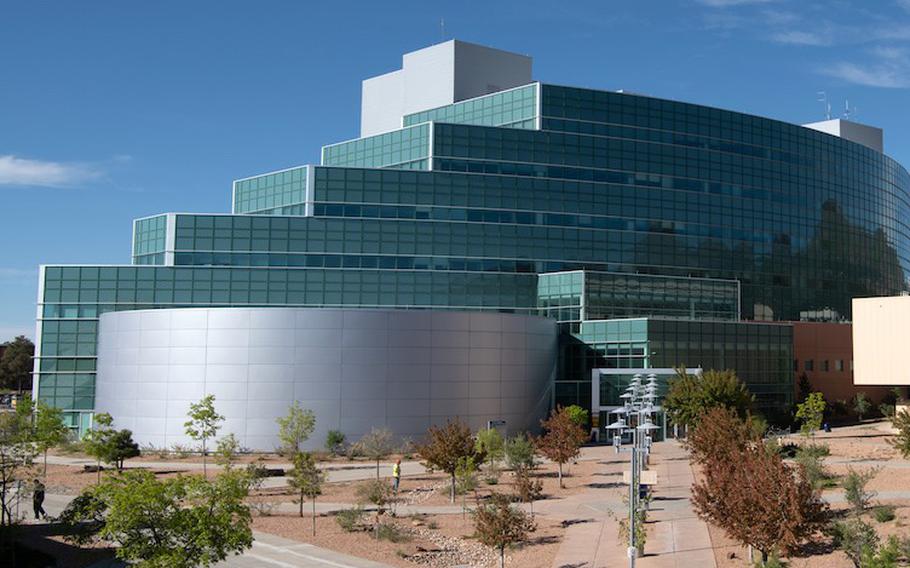
(Tribune News Service) — Los Alamos National Laboratory’s effort to produce 30 nuclear bomb cores a year by 2026 was stalled for 13 months because of the coronavirus pandemic, calling into question whether it can make the much-touted target.
An anti-nuclear activist obtained a redacted management plan for the lab’s plutonium operations through a Freedom of Information Act Request, which describes how the production deadline is more likely to be missed because of preparatory work being delayed during a hard-hitting stretch of the pandemic.
STATEMENT: Archbishop Wester on Feast Day of St. Francis, Pray for Peace in Ukraine, Abolition of Nuclear Weapons
Today, October 4 is the feast day of St. Francis, the tireless promoter of peace and patron saint of the Archdiocese of Santa Fe.
Pope Francis chose his name in honor of St. Francis of Assisi, and three days ago, he declared:
“The course of the war in Ukraine has become so serious, devastating, and threatening as to cause great concern… [W]hat about the fact that humanity is once again faced with the atomic threat? It is absurd… It increases the risk of nuclear escalation, giving rise to fears of uncontrollable and catastrophic consequences worldwide.”
This October is the 60th anniversary of the Cuban Missile Crisis, about which then-Defense Secretary Robert McNamara said humanity survived only by luck. Sixty years later, we are facing the most serious nuclear threats since then.
Pope Francis has called for the abolition of nuclear weapons, declaring they can no longer be justified even by the deterrence strategy of Mutually Assured Destruction.
Biden Thinks Non-Nuclear Threats Will Stop Putin. His Military Doesn’t
“We’re in uncharted territory,” says a senior intelligence officer. “Threatening to respond forcefully and creating catastrophic consequences for Russia [without] suggesting nuclear war: Is that strong enough to deter Putin? And is it really clear? I’m not so sure.”
BY WILLIAM M. ARKIN, NEWSWEEK | September 30, 2022 newsweek.com
The United States would “respond forcefully” to any Russian nuclear strike, President Biden said—but there’s a divide between his administration and some of his military advisers over the role of American nuclear weapons and the most effective way to deter Vladimir Putin, knowledgeable sources tell Newsweek.
“It’s the closest we’ve been to the use of nuclear weapons in over 50 years,” says one civilian working at the Omaha, Nebraska-based Strategic Command. “But I’m not so sure that we are communicating the right thing to deter Putin.”
The Age of Predatory Nuclear-Weapon States Has Arrived
Putin’s nuclear threat marks the start of a new era.
POLITICO | Opinion by Stephen Young, Union of Concerned Scientists | September 30, 2022 politico.com
Russia’s invasion of Ukraine makes at least one thing clear: It’s time for us to update how we think about nuclear weapons. For the first time in the nuclear era, one country used loudly issued nuclear threats — repeated just last week — to deter other countries from intervening in a large-scale conventional war of aggression. We have entered the age of “predatory nuclear-weapon states.”
For political analysts and military officials, this is not an unexpected phenomenon. On the contrary, the concept falls under the so-called stability-instability paradox. Because the threat of nuclear war is so terrifying and the risk of annihilation so real, lower-level conflict actually becomes more feasible. One nuclear-armed country can undertake major conventional military action, expecting that its nuclear capability will prevent outside intervention. That is what’s happening in Ukraine.
BREAKING: Putin illegally annexes 4 occupied regions, escalating war as Ukraine applies to join NATO
“Kyiv has vowed to keep fighting to retake its occupied land, and on Friday appeared on the verge of handing Russia’s military another significant setback.”
NBC NEWS | September 30, 2022 nbcnews.com
The Russian leader repeated his threats of nuclear war to defend his fragile hold over the annexed territory, a dramatic escalation of the seven-month conflict that has seen Moscow respond to heavy losses by calling up hundreds of thousands of reservists and intensifying its confrontation with the West.
The speech was met with an immediate response by Kyiv and its allies.
As well as announcing the annexation, Putin has partially mobilized his military — prompting domestic blowback and an exodus of Russians fleeing the draft — and ramped up his nuclear threats against Ukraine and the West. The moves are seen as a wider escalation after a series of punishing battlefield defeats at the hands of a lightning counteroffensive by Kyiv.
UN chief calls for end to ‘era of nuclear blackmail’
Guterres renews call for the abolition of nuclear weapons as concerns grow over Russia’s threat to use them in Ukraine.
ALJAZEERA | September 26, 2022 aljazeera.com
United Nations Secretary-General Antonio Guterres has renewed his call for the global abolition of nuclear weapons as concerns grow over Russia’s threat to use them in the Ukraine war.
“Decades after the fall of the Berlin Wall, we can hear once again the rattling of nuclear sabres,” Guterres told a special UN General Assembly session on nuclear disarmament on Monday.
Nuke waste managers work to improve safety after incidents at repository near Carlsbad
Crews at Idaho National Laboratory and the Waste Isolation Pilot Plant nuclear waste repository near Carlsbad met last week to improve safety standards shared between the two facilities after a string of problematic waste shipments from the lab triggered a state investigation.
Adrian Hedden, Carlsbad Current-Argus | September 22, 2022 yahoo.com
So far this year, WIPP personnel were alerted to issues with three shipments of transuranic (TRU) nuclear waste from the Idaho lab, leading to suspensions of waste shipments from the biggest shipper of waste to WIPP.
The first incident was reported on April 9, per a letter from the New Mexico Environment Department which regulates the U.S. Department of Energy’s permit to operate WIPP, and involved a liquid substance found on a waste drum that initially tested positive for radioactivity.
This led to an evacuation of the waste handling building, and a temporary halt on shipments of that kind from Idaho National Laboratory while the waste was sent back to Idaho.
Global food insecurity and famine from reduced crop, marine fishery and livestock production due to climate disruption from nuclear war soot injection
“Atmospheric soot loadings from nuclear weapon detonation would cause disruptions to the Earth’s climate, limiting terrestrial and aquatic food production. Here, we use climate, crop and fishery models to estimate the impacts arising from six scenarios of stratospheric soot injection, predicting the total food calories available in each nation post-war after stored food is consumed. In quantifying impacts away from target areas, we demonstrate that soot injections larger than 5 Tg would lead to mass food shortages, and livestock and aquatic food production would be unable to compensate for reduced crop output, in almost all countries. Adaptation measures such as food waste reduction would have limited impact on increasing available calories.
We estimate more than 2 billion people could die from nuclear war between India and Pakistan, and more than 5 billion could die from a war between the United States and Russia—underlining the importance of global cooperation in preventing nuclear war.”
NATURE | August 2022 nature.com

FULL ARTICLE – NATURE
Watchdog sues nuclear agency over LANL evaluations
“Coghlan said an example of why the full assessment is necessary is a note on last year’s report for the Los Alamos lab saying it had struggled with some production activities and experienced several challenges carrying out the plutonium mission, and “mission execution was impacted by lapses in safety performance.”
By Scott Wyland swyland@sfnewmexican.com The Santa Fe New Mexican | September 17, 2022 santafenewmexican.com
A New Mexico watchdog group is suing the federal agency that oversees the nation’s nuclear weapons programs for issuing only summaries of its yearly report cards on national laboratories and withholding what the group contends is vital information on deficiencies.
The lawsuit seeks to compel the National Nuclear Security Administration to post in its public reading room the complete report cards for the eight national laboratories involved in nuclear weapons — ones it has withheld in the past and all future assessments.
Allowing the public to see, in particular, the full report on Los Alamos National Laboratory’s shortcomings is increasingly important as the lab gears up to make 30 plutonium bomb cores a year with an escalating federal budget, Jay Coghlan, executive director of Nuclear Watch New Mexico, said in a statement.
The National Nuclear Security Administration’s yearly report cards assess the performances of contracted lab operators and award bonuses to the organizations based on their grades in a process that is not classified, Coghlan argued.
Continue reading
Exchange Monitor Round-Up: Anti-nukers sue for full performance evals
By Exchange Monitor | September 15, 2022 exchangemonitor.com
In a new lawsuit, the anti-nuclear group Nuclear Watch New Mexico, Santa Fe, demanded that the National Nuclear Security Administration (NNSA) turn over “full and complete Performance Evaluation Reports” for the contractors managing the agency’s nuclear-weapon…
‘Scoping’ The New LANL Site-Wide Environmental Impact Statement
![]() BY JAY COGHLAN
BY JAY COGHLAN
Executive Director, Nuclear Watch New Mexico
‘Scoping’ The New LANL Site-Wide Environmental Impact Statement
“Scoping” means determining the issues that should be included in public analyses required by the National Environmental Policy Act (NEPA) of proposed major actions by the federal government. According to the Department of Energy ‘s own NEPA implementation regulations, DOE must prepare a new or supplemental site-wide environmental impact statement (SWEIS) for its major sites when there are “significant new circumstances or information relevant to environmental concerns.” The last site-wide EIS for the Los Alamos National Laboratory (LANL) was completed in 2008 and is badly outdated. Moreover, since 2018 the National Nuclear Security Administration (NNSA), DOE’s semi-autonomous nuclear weapons agency, has been aggressively expanding the production of plutonium “pit” bomb cores for nuclear weapons at the Lab.
Lawmakers demand reparations for New Mexicans imperiled by nuclear bomb testing
“It’s very emotional to reflect on all we’ve lost as a result of being exposed to radiation,” said consortium founder Tina Cordova, herself a survivor of thyroid cancer who said members of her family also suffered from myriad forms of the disease.
By Adrian Hedden Carlsbad Current-Argus | September 10, 2022 currentargus.com

When the U.S.’ first nuclear bomb was detonated in south-central New Mexico, it was believed to set off a chain of cancers and health problems suffered by the surrounding communities for generations.
People who grew up near the Trinity Test Site, near the remote communities of Carrizozo or Tularosa, were denied federal relief dollars afforded to other “downwinders” impacted by nuclear testing around the country.
Both towns were within 50 miles of the blast site, and advocates say they were exposed to radiation from the bomb testing.
Agency to hold public comment on Los Alamos National Lab sitewide review
“Los Alamos lab’s plutonium modernization funding would climb to $1.56 billion from this year’s $1 billion, a more than 50 percent increase.
Jay Coghlan, executive director of Nuclear Watch New Mexico, expressed concerns about the agency indicating it saw no need to assess expanded pit production itself in the review.
“NNSA’s dubious argument is that it performed the legally required NEPA analysis for expanded plutonium pit production” in past assessments, Coghlan wrote.”
By Scott Wyland, The Santa Fe New Mexican | September 12, 2022 santafenewmexican.com
The federal agency that oversees nuclear weapons will hold two hearings this week to give the public a chance to comment about the first full sitewide environmental review of Los Alamos National Laboratory since 2008.
The National Nuclear Security Administration is conducting the sitewide review of the lab under the National Environmental Protection Act — breaking from its past resistance to doing fresh analysis of possible impacts as the lab gears up to annually produce 30 plutonium bomb pits by 2026.
Fighting rages near Russian-held nuclear plant in Ukraine
An official says the besieged Zaporizhzhia nuclear facility may be closed as residents near the plant are urged to evacuate for their own safety.
ALJAZEERA | September 9, 2022 aljazeera.com
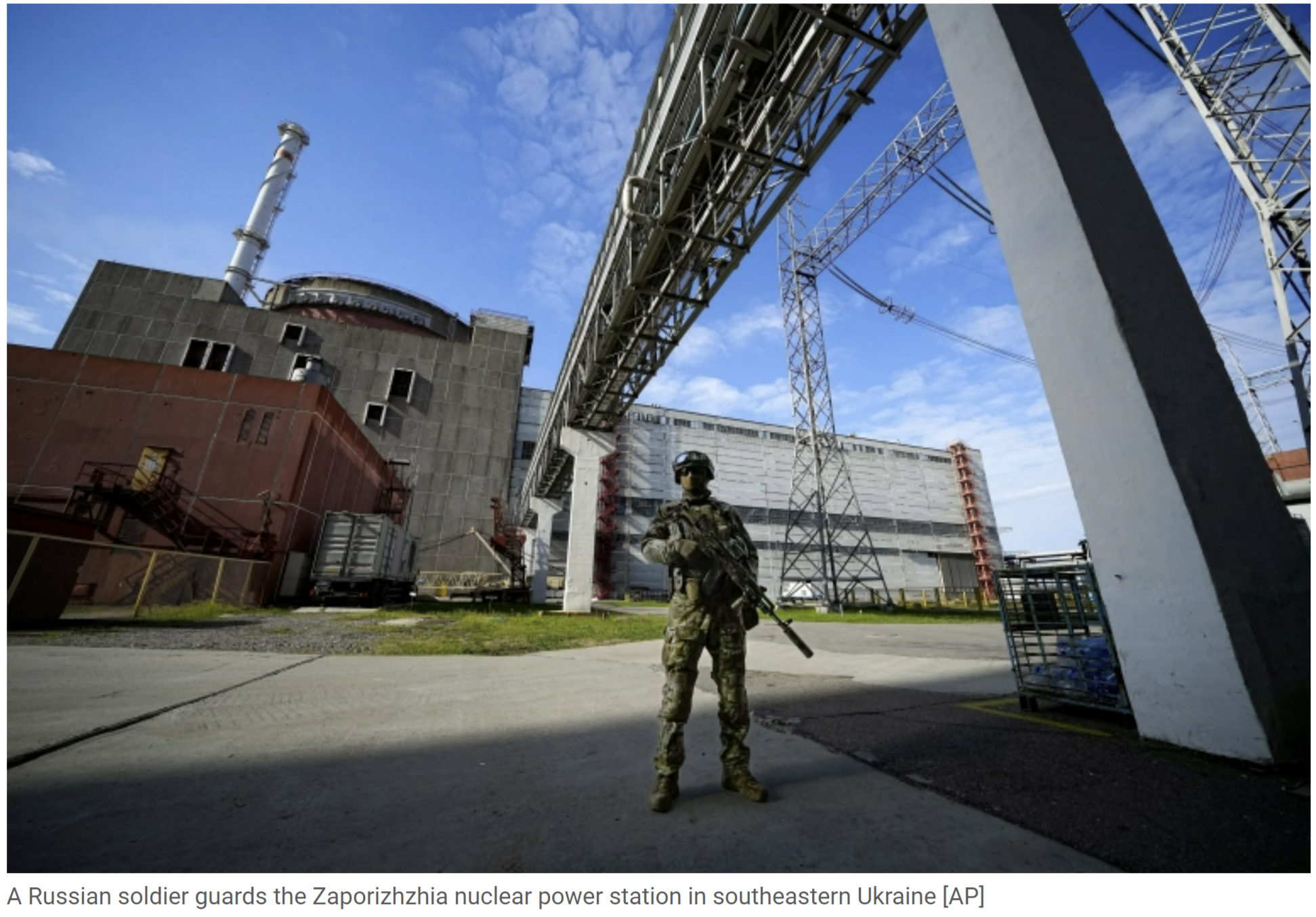 Heavy fighting erupted in areas near the Russian-occupied Zaporizhzhia nuclear power station in Ukraine after Kyiv warned it might have to shut down the plant to avoid a radiation disaster.
Heavy fighting erupted in areas near the Russian-occupied Zaporizhzhia nuclear power station in Ukraine after Kyiv warned it might have to shut down the plant to avoid a radiation disaster.
The General Staff of the Ukrainian Armed Forces said in its daily update on Thursday that some villages near the plant were bombed over the past 24 hours by “tanks, mortars, barrel and jet artillery”.
Overnight, Russian forces fired rockets and heavy artillery into the nearby town of Nikopol four times, the area’s regional governor, Valentyn Reznichenko, wrote on Telegram, damaging at least 11 houses and other buildings.
On Wednesday, an official said the nuclear plant may have to be shut down and called on residents in areas near the embattled facility to evacuate for their own safety.
SANTA FE NEW MEXICAN, MY VIEW JAY COGHLAN: LANL growth fueling new nuclear arms race
“Locally, while the lab grabs tens of billions of taxpayers’ dollars for new, counterproductive nuclear weapons production, it plans to “cap and cover” and leave buried some 200,000 cubic yards of toxic and radioactive wastes that will permanently threaten our precious water resources.”
My View Jay Coghlan – The Santa Fe New Mexican | September 10, 2022 santafenewmexican.com
The New Mexican‘s recent editorial on Los Alamos National Laboratory noted “LANL’s astounding growth” (“LANL’s growth creates pressure on safety,” Our View, Aug. 31). Cancer is defined as uncontrollable cellular growth invading other parts of the body. That is fitting here as the lab metastasizes into the city of Santa Fe (in English, “Holy Faith”). The potentially terminal disease is a second nuclear arms race. Ex-Defense Secretary Robert McNamara said we survived the first arms race only by luck.
Where is the leadership, where is the vision? While busy legislating short-term nuclear pork benefiting the already privileged, our congressional delegation leads us toward Armageddon. This second arms race is more dangerous than the first because of multiple nuclear adversaries, new cyber and hypersonic weapons, and artificial intelligence. All of this destabilizes the old Cold War architecture of mutually assured destruction (which never really went away). But “MAD” is truly insane to begin with, involving total, civilization-destroying war.
“Details of foreign country’s nuclear capabilities among documents FBI seized from Mar-a-Lago: report” “Nuclear secrets reportedly found at Mar-a-Lago are ‘gamechanger’, experts say – as it happened”
THE GUARDIAN: Report appears to confirm security officials’ worst fears about the nature of the material Trump refused to hand back
THE GUARDIAN, FOX NEWS | September 7, 2022 theguardian.com, foxnews.com
Federal agents seized the document during their search of Mar-a-Lago, the former president’s Palm Beach mansion in Florida, last month, the Washington Post reported. It appears to confirm officials’ worst fears about the nature of the intelligence he should have returned to the National Archives.
Shelling at Ukrainian nuclear plant highlights danger ahead of UN report – Reuters
U.N. seeks security zone near damaged Zaporozhzhia nuclear plant
By Pavel Polityuk and Francois Murphy, Reuters | September 6, 2022 reuters.com
Federal agents seized the document during their search of Mar-a-Lago, the former president’s Palm Beach mansion in Florida, last
KYIV/VIENNA, Sept 6 (Reuters) – Ukrainian forces shot down five Russian cruise missiles on Tuesday, most of them in the south, President Volodymyr Zelenskiy said, but he made no mention of a new military success in the east hinted at by officials earlier.
“This morning alone, five of six Russian X-101 missiles were downed,” Zelenskiy said in an evening address. “This is a costly loss for Russia, and it saves many Ukrainian lives. Four of these missiles were downed by the “South” district of the air command.”
Reuters was not able to independently verify Zelenskiy’s statement and there was no immediate response from Russia.
Though Ukrainian officials did not give specific details, several posts on social media from military bloggers and witnesses reported fighting around Balakliia, an eastern town of 27,000 people that lies between Kharkiv and Russian-held Izyum, a city with a major railway hub used by Moscow to supply its forces. One tweet by a Zelenskiy adviser spoke of “great news” coming from the president on the operation in Kharkiv region.
One Hundred and Fifteen NGOs and Individuals Ask for LANL SWEIS Comment Extension; LANL Virtual Scoping Meetings on September 13th and 14
August 31, 2022
This week 63 non-governmental organizations and 52 individuals requested that the U.S. Department of Energy (DOE) grant a two-month extension of time to provide informed public comments about the scope of the Site-Wide Environmental Impact Statement for Continued Operations of Los Alamos National Laboratory (LANL SWEIS). On August 19th, DOE announced in its Notice of Intent to Prepare a Site-Wide Environmental Impact Statement for the Los Alamos National Laboratory a 45-day comment period. Currently, comments are due on Monday, October 3rd, 2022. https://www.energy.gov/nnsa/nnsa-nepa-reading-room
 In their August 30th letter, the groups and individuals asked that the DOE Secretary Granholm and her staff extend the comment period to Monday, December 5, 2022. No response has yet been received. LANL SWEIS 2022 Scoping Extension Request 8-25-22
In their August 30th letter, the groups and individuals asked that the DOE Secretary Granholm and her staff extend the comment period to Monday, December 5, 2022. No response has yet been received. LANL SWEIS 2022 Scoping Extension Request 8-25-22
The NGOs and individuals justified their extension request by noting, among other items, that the last LANL SWEIS was finalized in 2008 – 14 years ago. Generally DOE conducts a SWEIS every 10 years. DOE proposes that this LANL SWEIS will cover “approximately the next 15 years” of operations, or to approximately 2038 and beyond.
Extension Requested For Scoping Comments Deadline For LANL Site-Wide Environmental Impact Statement
Dozens of environmental groups, non-government organizations and individuals have signed a request to the Department of Energy for a two-month extension of the Oct. 3 comment deadline for scoping comments on a Site-Wide Environmental Impact Statement for continued operations of Los Alamos National Laboratory.
BY MAIRE O’NEILL, Los Alamos Reporter | August 31, 2022 losalamosreporter.com
A letter sent Tuesday states that the current comment period is simply not enough time for the public to make meaningful comments on the scope of a proposal as large, complex and technical as the LANL SWEIS. It is addressed to Sec. of Energy Jennifer Granholm, Under Secretary for Nuclear Security Jill Hruby, DOE/NNSA Los Alamos Field Office Manager Ted Wyka and NNSA’s NEPA Compliance Officer at LANL Kristen Dors. The top two signatories are Joni Arends of Concerned Citizens for Nuclear Safety and Scott Kovac of Nuclear Watch New Mexico.
“The scope of the LANL SWEIS is of great national importance because it examines the environmental impacts associated with expanded plutonium pit production and cleanup at LANL,” the letter reads. “The 2008 LANL SWEIS is a formidable document, with 1942 pages, not counting the 144-page Summary and the 1207-page Comment Response Document. That’s a total of 3293 pages. This gives an idea of the amount of information analyses that are involved in preparing informed public scoping comments and why more time is needed.”
Former Soviet leader Mikhail Gorbachev, who helped end the Cold War, has died
Former Soviet leader Mikhail Gorbachev, who played a pivotal role in the end of the Cold War, has died at the age of 91 in Moscow.
August 30, 2022
Mr. Gorbachev's first five years in power were marked by significant, even extraordinary, accomplishments:
- He presided over an arms agreement with the United States that eliminated for the first time an entire class of nuclear weapons, and began the withdrawal of most Soviet tactical nuclear weapons from Eastern Europe.
- He withdrew Soviet forces from Afghanistan, a tacit admission that the invasion in 1979 and the nine-year occupation had been a failure.
- While he equivocated at first, he eventually exposed the nuclear power-plant disaster at Chernobyl to public scrutiny, a display of candor unheard-of in the Soviet Union.
- He sanctioned multiparty elections in Soviet cities, a democratic reform that in many places drove stunned Communist leaders out of office.
- He oversaw an attack on corruption in the upper reaches of the Communist Party, a purge that removed hundreds of bureaucrats from their posts.
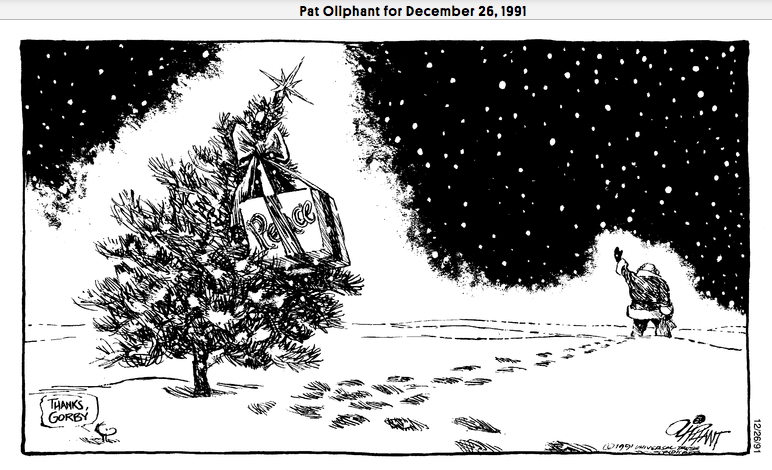
Mikhail Gorbachev, who has died aged 91, was the most important world figure of the last quarter of the 20th century. Almost singlehandedly he brought an end to 40 years of east-west confrontation in Europe and liberated the world from the danger of nuclear conflagration.
The man who oversaw the end of the Cold War and then the end of the Soviet Union has died.
‘We’re losing our people’: COVID ravaged Indigenous tribes in New Mexico. Did uranium mining set the stage?
Today, hundreds of mines lie abandoned across New Mexico’s Indigenous lands. So do scores of eroding radioactive landfills meant to bury uranium mine waste.
By Eli Cahan, Capital & Main | August 26, 2022 usatoday.com
As a young girl, Arlene Juanico would rush to gather the laundry before the explosions started.
When the alarms sounded, Juanico would hustle to grab the clean garments off the clothesline before she was enveloped by dust clouds. But Juanico’s little legs usually couldn’t get her back to shelter in time.
That’s when the yellow-flecked dust – emerging from detonations in the sacred mesa the Laguna tribe knows as Squirrel Mountain – would catch up to her. That’s when it would enter Juanico’s throat, burrowing deep into her lungs.
It’s the same dust she would confront when, as an adult, she worked for the Anaconda Copper Co.
And it’s the dust that would persist in her lungs, kidneys and bones. There, hidden in the dark recesses of her chest, the particles lay until one day decades later a CT scan would show Juanico and people like her why they hadn’t been able to take a full breath in decades. They’d get a similar diagnosis – idiopathic pulmonary fibrosis – one mangled lung at a time.

As such, the dangers of one of the largest uranium mines in American history didn’t abate when the dust clouds dissipated.
NPT Review Conference fails to address current security environment
“In a year when a nuclear-armed state invaded a non-nuclear armed state, a meeting of nearly all countries in the world failed to condemn Russia’s threats to use nuclear weapons in the context of its invasion, and failed to take any steps that would advance nuclear disarmament.”
After four weeks of meetings, the 10th Nuclear Non-Proliferation Treaty Review Conference has failed. Despite the final draft outcome document being significantly weakened throughout the negotiations, Russia refused to accept the final version and the conference ended without an agreement.
ICAN (The International Campaign to Abolish Nuclear Weapons) | August 27, 2022 icanw.org
The Bizarre Mystery of the Only Armed Nuke America Ever Lost
The lost nuke has never been found—only the pilot’s helmet was recovered, and the government kept it secret for years.
BY MATTHEW GAULT | VICE NEWS | August 29, 2022 vice.com
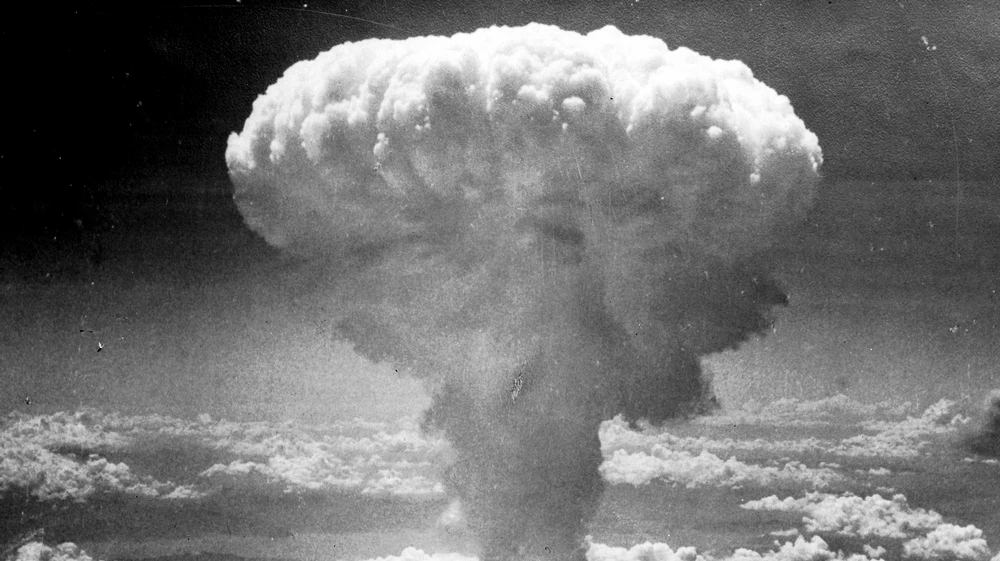
…On December 5, 1965, U.S. Navy Lt. Douglas Webster was supposed take an A-4E Skyhawk loaded with a nuclear bomb into the sky. On the USS Ticonderoga aircraft carrier, stationed in the Philippine Sea about 70 miles from Okinawa, Japan, the crew loaded the weapon onto the vehicle and Webster got into the cockpit. The crew then pushed the plane to an elevator that would bring it up to the flight deck.
The plan was for Webster to fly around, then land back on the aircraft carrier where the crew would unload the weapon. Webster never made it into the air. The Skyhawk rolled out of the elevator and the crew began to frantically wave at Webster, calling on him to hit the breaks. “According to testimony during the post-incident Board of Inquiry investigation, the pilot seemed oblivious to the whistles and was looking down,” Chief Petty Officer Delbert Mitchell, who was on the crew that loaded the bomb onto the Skyhawk, told the U.S. Naval Institute in 2019.
Navy crew desperately tried to stop the Skyhawk, but they only managed to pivot it in place as it rolled inevitably to the side of the carrier. It hit the netting on the side of the elevator, broke through it, and fell into the ocean. The nuke was armed. “We never saw Lieutenant Webster after he climbed into the cockpit or knew what efforts he might have attempted to get out of the Skyhawk, but we were stunned to witness a plane, pilot, and nuclear weapon fall into the ocean,” Mitchell said.
Mitchell and the rest of the ship looked into the ocean and watched as the Skyhawk sank into the ocean, its landing gear sticking straight up into the air. Efforts to save Webster and recover the nuclear bomb started immediately. The Navy called in other ships to aid with the search but discovered no sign of the missing nuke or plane—they only ever found Webster’s helmet.
The Navy did not talk about the incident for decades. It reported the incident to Congress a year later when the Joint Committee on Atomic Energy was studying the shocking number of Broken Arrows, but the general public wouldn’t learn that America had lost an active nuke off the coast of Japan until 1989.
The US military is still missing 6 nuclear weapons that were lost decades ago
“After Robert McNamara took the post of Secretary of Defense later that year, he pointed to that incident and another nuke loss over Texas as evidence of how close the U.S. has come to accidental detonations, despite “spending millions of dollars to reduce this problem to a minimum.”
“By the slightest margin of chance, literally the failure of two wires to cross, a nuclear explosion was averted,” McNamara was quoted as saying in an article by The Guardian.”
The U.S. military had 32 nuclear accidents during the Cold War, and several nuclear weapons remain unaccounted for.
BY DAVID ROZA | TASK AND PURPOSE | August 25, 2022 taskandpurpose.com
From car keys to glasses to rifles, everyone misplaces something important from time to time. But when you’re the U.S. government, sometimes that important thing is a superweapon that is designed to destroy cities and kill millions of people.
Over the decades, the U.S. military has had 32 nuclear accidents, also called “Broken Arrow” incidents. These incidents include accidental launches, radioactive contamination, loss of a nuclear weapon or other unexpected events involving nuclear weapons. Luckily, of those 32 accidents, there were only six U.S. nuclear weapons that could not be located or recovered, and of those six weapons, only one was capable of a nuclear detonation when it was lost.
While even one missing nuclear weapon sounds scary, it’s worth noting that the Soviet Union lost far more during the Cold War, often due to submarines sinking with a dozen or more nuclear missiles on board.
“Compared to the Soviet Union, the U.S. record is pretty impressive, given how many nuclear weapons it has operated and transported everywhere over the years,” Hans Kristensen, director of the Nuclear Information Project for the Federation of American Scientists, told Task & Purpose.
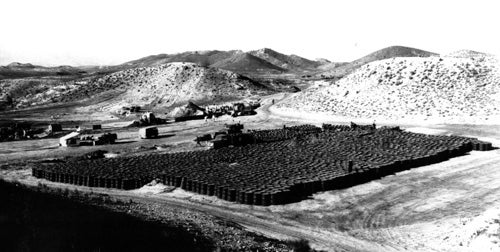
In fact, U.S. government agencies often go to great lengths to secure lost weapons. One such incident occurred on Jan. 17, 1966, when a B-52 and a KC-135 refueling tanker collided over southern Spain and scattered four B-28 thermonuclear bombs around the fishing village of Palomares. The conventional explosives for two of the bombs exploded, but the nuclear components did not detonate because they were not armed. The U.S. military sent troops to pick up the undetonated one that fell on land, clean up the radioactive pieces scattered by the two which detonated, and find the fourth which landed in the sea. The U.S. government even dispatched a submarine to find the one in the Mediterranean Sea. Called ‘Alvin,’ the small deep-ocean sub was high-tech for its time, but the crew nearly died when the sub was almost entangled in the parachute that was still attached to the bomb on the ocean floor. Meanwhile, the service members who helped find the landward bombs and clean up the wreckage also developed cancers which they say are linked to that mission 56 years ago.
Considering the extent to which the U.S. looks for lost nukes like it did in Palomares, the stories behind the five instances where recovery crews could not locate or recover weapons are extraordinary. Below is a list of those five accidents, one of which resulted in two missing nuclear weapons. Keep in mind that in all but one, the lost nuclear weapons did not include the pit or capsule that contains the components for triggering a nuclear detonation. That means we can all sleep a little easier knowing those weapons cannot blow up a city. However, the U.S. government still classifies those pit-less devices as nuclear weapons: sophisticated, expensive machines that at the time were closely-guarded tools of mass destruction. And there are many more out there from other governments like the Soviet Union which may never be found.
Nuclear waste shipments to repository near Carlsbad lagging behind goals for 2022
“So far in FY 2022, most of WIPP’s shipments came from Idaho National Laboratory to fulfill statutory agreements between the DOE and the State of Idaho.”
By Adrian Hedden, Carlsbad Current-Argus | August 26, 2022 currentargus.com
Nuclear waste managers in New Mexico are about 90 shipments of waste short of their goal at the Waste Isolation Pilot Plant for fiscal year 2022 which ends in about a month.
Records show WIPP accepted 206 shipments so far for FY 2022, which runs from Oct. 1, 2021 to Sept. 30, 2022.
During an Aug. 4 meeting before lawmakers, WIPP officials said the facility was targeting 299 shipments this year.
Transuranic (TRU) waste is shipped to WIPP near Carlsbad for permanent disposal in an underground salt deposit about 2,000 feet below the surface.
It comes from U.S. Department of Energy facilities throughout the nation, and is made up of clothing materials and equipment irradiated during nuclear activities.
Watchdog groups call review at US nuclear lab ‘sham’ process
“This is too little too late, a sham process designed to circumvent citizen enforcement of the National Environmental Policy Act,” said Jay Coghlan, executive director of Nuclear Watch New Mexico. “The key sentence in NNSA’s announcement is that absent any new decisions in the site-wide environmental impact statement, the agency will continue to implement decisions it previously made behind closed doors.”
By SUSAN MONTOYA BRYAN | August 19, 2022 apnews.com
ALBUQUERQUE, N.M. (AP) — The U.S. government is planning to review the environmental effects of operations at one of the nation’s prominent nuclear weapons laboratories, but its notice issued Friday leaves out federal goals to ramp up production of plutonium cores used in the nation’s nuclear arsenal.
The National Nuclear Security Administration said the review — being done to comply with the National Environmental Policy Act — will look at the potential environmental effects of alternatives for operations at Los Alamos National Laboratory for the next 15 years.
That work includes preventing the spread and use of nuclear weapons worldwide and other projects related to national security and global stability, the notice said.
Watchdog groups contend that regardless of the review, the NNSA will march ahead with its production plans for plutonium cores at Los Alamos.
Federal agency to conduct sitewide review of Los Alamos National Laboratory
“This is in direct contradiction to the National Environmental Policy Act’s requirement that federal agencies take a ‘hard look’ at proposed actions before implementation,” Jay Coghlan, executive director of Nuclear Watch New Mexico, said in a statement.
So much happened after 2008 that called for a new, thorough impact study years ago, including the plutonium facility’s “checkered nuclear safety history” that led to its major operations shutting down for more than three years, Coghlan said.
A new sitewide analysis now, Coghlan said, will merely “rubber stamp the billions of taxpayers’ dollars being sunk into a predetermined decision to expand plutonium pit production at LANL.”
By Scott Wyland swyland@sfnewmexican.com The Santa Fe New Mexican | August 19, 2022 santafenewmexican.com
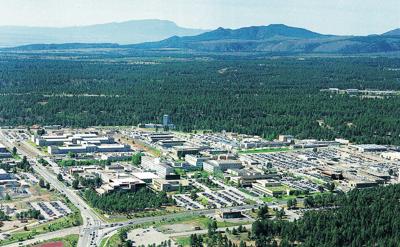
The federal agency that oversees nuclear weapons will conduct a sitewide environmental review at Los Alamos National Laboratory, breaking from its past resistance to performing fresh analysis of potential impacts as the lab gears up to make 30 nuclear warhead triggers a year.
The National Nuclear Security Administration announced in the Federal Register on Friday it would do a sitewide analysis of the lab under the National Environmental Protection Act and would take public comment until Oct. 3.
It’s the first time the agency, a branch of the U.S. Department of Energy, has done a new sitewide environmental impact statement in 14 years.
ATOMIC MASS In Santa Fe, an Archbishop calls for nuclear disarmament through faith alone.
“Jay [Coghlan] of Nukewatch, invited by Wester to answer an audience question about Ukraine having lost deterrence when it returned Soviet nuclear weapons to Moscow, emphasized that Ukraine never had the controls to actually detonate nuclear weapons stored on its territory. Coughlin then echoed Beamont’s statement, saying ‘we can flip the argument, say that Russia is shielded from consequences because it has nuclear weapons. Deterrence has been flipped on its head.’”
BY: KELSEY D. ATHERTON, INK STICK MEDIA | August 10, 2022 inkstickmedia.com
At least 100 parishioners must have been in attendance at the special mass at the Cathedral Basilica of Saint Francis of Assisi on Aug. 9, 2022. The Tuesday afternoon service at the historically significant church did not fall under the usual schedule. Following an afternoon rich in monsoon thunderstorms, the clouds cleared, allowing regulars and visitors alike to file in to hear what, exactly, the Archbishop of the Santa Fe Archdiocese had to say about the work of peace.
“In the way that 109 East Palace was the gateway to nuclear oblivion, I hope that the Basilica of St. Francis can be the gateway to global nuclear disarmament,” John C. Wester, Archbishop of Santa Fe, told the assembled crowd.
The address is instantly familiar to those fluent in nuclear history and opaque outside of it. During the Manhattan Project, the US effort to develop and build an Atomic Bomb in Los Alamos, 109 East Palace was the place to arrive before being covertly whisked away to the lab.
WHEN IT COMES TO SALVATION FROM NUCLEAR OBLIVION, FAITH IN THE RIGHTEOUSNESS OF THE TASK ALONE IS NOT ENOUGH. THERE MUST BE WORK THAT MAKES IT REAL.
It was the work of Los Alamos that made Aug. 9 the occasion for a mass dedicated to nuclear disarmament. On Aug. 9, 1945, the US dropped Fat Man, the second and so far last nuclear weapon used in war. The bomb fell on Nagasaki, a Japanese city hastily added to the targeting list. While the bombardier claims the clouds parted for visual confirmation of the target, it is at least equally plausible the crew decided to drop the bomb by radar targeting and fly back to base, instead of ditching it in the ocean or crashing on the way back.
Archbishop Wester apologizes for harms caused by nuclear weapons industry
“I challenge us at the most personal level to ask ourselves, ‘How do we live each day? Do we live each day consistent with the core values of faith, love and compassion … for one another?” – Archbishop Wester
Catholic News Service | August 10, 2022 catholicnews.com
New Mexico archbishop whose archdiocese is home to two major federal nuclear weapons research facilities and an Air Force base apologized for the atomic bombings of Japan and to Indigenous New Mexicans, uranium miners and scientists suffering from ill health related to the nuclear weapons industry.
Archbishop John C. Wester of Santa Fe said the time has come for the world to fervently work to undertake the long process to achieve nuclear disarmament.
He made the comments in a homily during a Mass Aug. 9 marking the 77th anniversary of the bombing of Nagasaki, Japan.Continue reading
On this solemn anniversary, another look at a nuclear future
“Continuing to develop weapons that don’t just kill but have the potential to decimate the planet is a seemingly accepted part of modern life.
Yet on this anniversary of the bombing of Nagasaki, it is useful to consider whether humanity can find a different path forward.”
OUR VIEW | The Santa Fe New Mexican | August 8, 2022 santafenewmexican.com
August is a particularly dark month in human history.
On Aug. 6 and Aug. 9, 1945, humanity revealed it had the ability to destroy itself; the United States chose to drop atomic bombs first on Hiroshima and then on Nagasaki to force Japan to surrender and end World War II. The destruction was horrific, with tens of thousands of people killed, buildings leveled and thousands more dying of lingering radiation sickness in the years that followed.
New Mexico played an outsized role in the bomb’s deployment. It was developed by the Manhattan Project scientists in the then-secret city of Los Alamos and tested at White Sands. Today, Los Alamos National Laboratory continues its mission of solving national security challenges, with the current emphasis gearing up to manufacture the plutonium pits at the core of nuclear weapons.
By 2026, LANL is supposed to be ready to make 30 pits a year, with another 50 pits annually coming from the Savannah River Site in South Carolina by 2030.
The weight of a butterfly
“Of the 64 kilograms of uranium in the Hiroshima bomb, less than one kilogram underwent fission, and the entire energy of the explosion came from just over half a gram of matter that was converted to energy.
That is about the weight of a butterfly.”
By Emily Strasser, Bulletin of the Atomic Scientists | August 6, 2022 thebulletin.org
The design for the first atomic bomb was frighteningly simple: One lump of a special kind of uranium, the projectile, was fired at a very high speed into another lump of that same rare uranium, the target. When the two collided, they began a nuclear chain reaction, and it was only a tiny fraction of a second before the bomb exploded, forever splitting history between the time before the atomic bomb and the time after.
At 17 seconds past 8:15 a.m. on August 6, 1945, the Enola Gay released the bomb from a height of 31,600 feet above the target, a T-shaped bridge in the center of Hiroshima, Japan.
The morning was cloudless, as the weather plane sent to scout for the Enola Gay had reported in the hour before. If the weather had been poor, the plane would have set its course to one of the two alternate targets. As the bomb fell, a schoolboy closed his eyes and began to count as his friends hid along the way to school.
Nuclear threat higher now than in Cold War, British official warns
“’We are entering a dangerous new age,’ [Lovegrove] added, citing the spread of advanced weapons and cyberwarfare.”
BY Ellen Francis © WASHINGTON POST | July 28, 2022 washingtonpost.com
Britain’s national security adviser has warned that a breakdown in dialogue among rival powers is raising the risk of nuclear war, with fewer safeguards now than during the Cold War.
As such, he said, Britain strongly supports President Biden’s talking with Beijing.
The Economist on “The NPT at 50+”: Will the Ukraine war ring the knell for nuclear arms control?
“America offers to resume nuclear talks with Russia, and calls for China to join. But the outlook is dark”
© THE ECONOMIST | July 31, 2022 economist.com
Editor’s note (August 1st 2022): President Joe Biden today offered to “expeditiously negotiate” a new nuclear arms-control deal with Russia to replace the New START treaty, which expires in 2026. Mr Biden also put pressure on China to discuss limits on its growing nuclear arsenal. It is not clear whether either power will take up his call, but it allows America to cast itself as a responsible power at the start of a big nuclear conference in New York.
Russian Defense Ministry officials show off the 9M729 cruise missile at the military Patriot Park outside Moscow on January 23, 2019.CreditVasily Maximov/Agence France-Presse — Getty ImagesIn the sea of hostility between America and Russia, an island of co-operation endures: the rival powers routinely share information about their long-range nuclear weapons, from the movement of warheads in and out of maintenance to telemetry from ballistic-missile launches. This is both striking and reassuring in the sixth month of war in Ukraine, as Russia periodically threatens to use nuclear weapons and America warns of “severe consequences” if it does.
Environment Department Unhappy With Pace Of DOE Characterization, Cleanup Of LANL Chromium Plume
“’We felt that the cleanup was not moving as quickly as it should be moving and then we entered into litigation with DOE. It was moved from state court to federal court. The current LANL cleanup end date for DOE is 2036, which is in the Consent Order, and we don’t feel that they’re going to be able to make that timeline based on the progress they’re making at this time,’ Catechis said.”
BY MAIRE O’NEILL | July 27, 2022 losalamosreporter.com
New Mexico Environment Department Resource Protection Division Director Chris Catechis is not mincing his words when he discusses NMED’s position on the hexavalent chromium plume discovered in 2005 which is part of the legacy waste clean-up mission at Los Alamos National Laboratory.
At a recent meeting of the Legislative Interim Committee on Radioactive & Hazardous Waste, both Catechis and Rep. Christine Chandler of Los Alamos raised concerns that Department of Energy Environmental Management program at LANL is not taking an aggressive enough approach to characterization of the chromium plume.
Catechis explained the 2016 Consent Order between DOE and NMED dealing with legacy waste from LANL left since the Manhattan Project era. The 2016 Consent Order, which is an update from the original 2005 Consent Order, NMED and DOE officials meet each year to set up a series of milestones, campaigns and targets for the coming federal fiscal year that starts Oct. 1. Catechis said an example of those is the Chromium Interim Measure that deals with the characterization of the chromium plume.
From Russia to Ohio…to the Cancer Ward
“According to the Departments of State and Energy, there was a deliberate decision by the U.S. government that U.S. interests would be served by allowing a portion of the highly enriched uranium to be blended into low enriched uranium and to be rapidly removed from Russia while the details of the transparency measures were being worked out,” the GAO report states.”
BY Ken Silva | July 12, 2022 libertarianinstitute.com
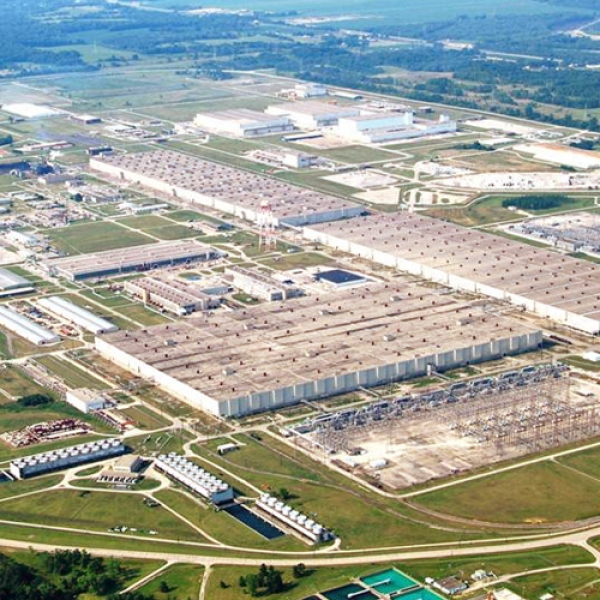
Residents of Piketon, Ohio have long suspected that the area’s sky-high cancer rate stems from the nearby Portsmouth Gaseous Diffusion Plant (PORTS), which served as a uranium enrichment facility for nuclear bombs throughout the Cold War.
Recent reporting from Local 12 WKRC-TV anchor Duane Pohlman sheds light on why the area’s cancer epidemic—more than 500 cases per 100,000, or about 10 percent above state average, according to the Ohio Cancer Atlas—has persisted decades after PORTS stopped helping Uncle Sam build nukes.
Pohlman revealed in May that the PORTS may have been the recipient of polluted uranium from Russia in the 1990s due to a Bill Clinton-era program called “Swords to Ploughshares,” which entailed the United States converting Soviet Union nuclear warheads to uranium that could be used to power U.S. nuclear reactors. Pohlman’s reporting suggests that some of that material was laced with plutonium.
MORE LAB EXPANSION: MAKING WAY FOR NEW PLUTONIUM PIT PRODUCTION ACTIVITY? NNSA/DOE Update: “Los Alamos Field Office Clears Way to Lease Warehouse, Storage Space within 150 miles of Laboratory”
“Multiple properties could be needed to meet LANL needs…Items that would be warehoused or stored include items that are needed for LANL operations,”
BY Carol A. Clark , Los Alamos Daily Post | July 22, 2022 ladailypost.com

The Department of Energy National Nuclear Security Administration’s Los Alamos Field Office (DOE/NNSA) has issued a Categorical Exclusion to lease properties to provide warehouse and storage space for Los Alamos National Laboratory (LANL) equipment within a 150-mile radius of LANL, which could include properties in several locations of northern New Mexico and southern portions of Colorado.
Nuclear strategy and ending the war in Ukraine
“Removing U.S. nuclear weapons from Europe and Turkey would not weaken NATO militarily, since nuclear weapons have little or no actual usefulness on the battlefield. If they are truly weapons of last resort, there is no need to deploy them so close to Russia’s border. ”
A bold idea: NATO offers to withdraw nukes from Europe (militarily useless, ineffective deterrents as we’ve just seen, & recklessly dangerous) in return for ending the invasion. Putin gets a “win” which costs us nothing worth having. https://t.co/P5txyLEcMs
— Steven Pinker (@sapinker) July 25, 2022
BY OSCAR ARIAS AND JONATHAN GRANOFF, The Hill | July 25, 2022 thehill.com
It is time for bolder efforts to make peace in Ukraine.
War, like fire, can spread out of control, and as President Putin keeps reminding us, this particular conflagration has the potential to start a nuclear war.
At a recent joint news conference with the President of Belarus, Putin announced that Russia would transfer Iskander M missiles to Belarus. Those missiles can carry nuclear warheads, and the move is apparently intended to mirror nuclear sharing arrangements the United States has with five NATO allies — Belgium, the Netherlands, Germany, Italy, and Turkey.
U.S. nuclear weapons were introduced into Europe in the 1950s as a stopgap measure to defend NATO democracies whose conventional forces were weak. The number of nuclear weapons in those five countries peaked around 7,300 warheads in the 1960s, then dwindled to about 150 today, reflecting NATO’s growing conventional strength and its diminishing estimation of the military usefulness of nuclear weapons. But even 150 nuclear weapons could be more than sufficient to touch off a dangerous confrontation with Russia.
Nuclear News Archives – 2021
To Avoid Armageddon, Don’t Modernize Missiles—Eliminate Them
Land-based nuclear weapons are world-ending accident waiting to happen, and completely superfluous to a reliable deterrent.
“Getting trapped in an argument about the cheapest way to keep ICBMs operational in their silos is ultimately no-win. The history of nuclear weapons in this country tells us that people will spare no expense if they believe that spending the money will really make them and their loved ones safer—we must show them that ICBMs actually do the opposite.“
By Daniel Ellsberg and Norman Solomon thenation.com October 22, 2021
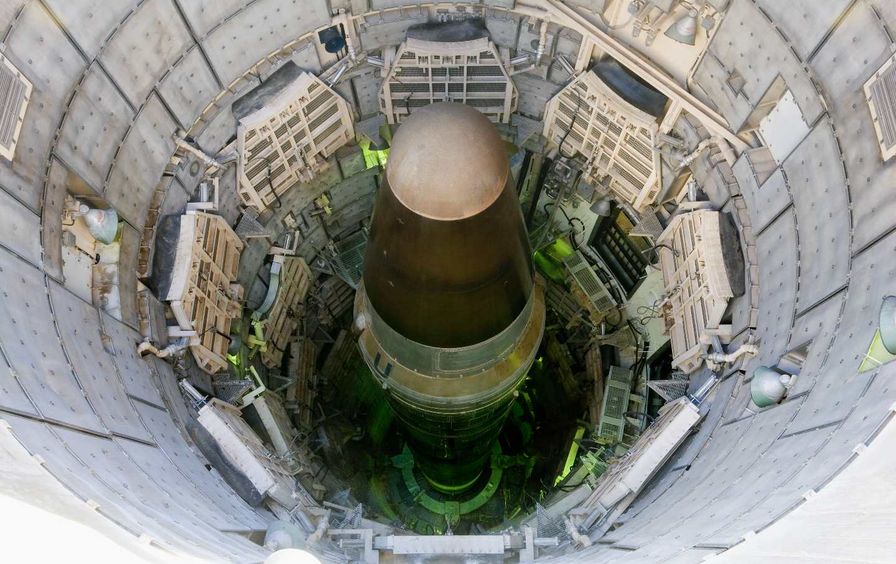
The single best option for reducing the risk of nuclear war is hidden in plain sight. News outlets don’t mention it. Pundits ignore it. Even progressive and peace-oriented members of Congress tiptoe around it. And yet, for many years, experts have been calling for this act of sanity that could save humanity: Shutting down all of the nation’s intercontinental ballistic missiles.
Four hundred ICBMs dot the rural landscapes of Colorado, Montana, Nebraska, North Dakota, and Wyoming. Loaded in silos, these missiles are uniquely—and dangerously—on hair-trigger alert. Unlike the nuclear weapons on submarines or bombers, the land-based missiles are vulnerable to attack and could present the commander in chief with a sudden use-them-or-lose-them choice. “If our sensors indicate that enemy missiles are en route to the United States, the president would have to consider launching ICBMs before the enemy missiles could destroy them. Once they are launched, they cannot be recalled,” former Defense Secretary William Perry warns. “The president would have less than 30 minutes to make that terrible decision.”
The danger that a false alarm on either side—of the sort that has occurred repeatedly on both sides—would lead to a preemptive attack derives almost entirely from the existence on both sides of land-based missile forces, each vulnerable to attack by the other; each, therefore, is kept on a high state of alert, ready to launch within minutes of warning. The easiest and fastest way for the US to reduce that risk—and, indeed, the overall danger of nuclear war—is to dismantle entirely its Minuteman III missile force. Gen.
James E. Cartwright, a former vice chair of the Joint Chiefs of Staff, who had been commander of the Strategic Command, teamed up with former Minuteman launch officer Bruce G. Blair to write in a 2016 op-ed piece: “By scrapping the vulnerable land-based missile force, any need for launching on warning disappears.”
Continue reading
Activists in Santa Fe concerned about plutonium shipping plan
“Santa Fe residents would see shipments of plutonium trucked through the city’s southern edge if federal agencies carry out plans announced nearly a year ago.”
By Scott Wyland • The Santa Fe New Mexican santafenewmexican.com
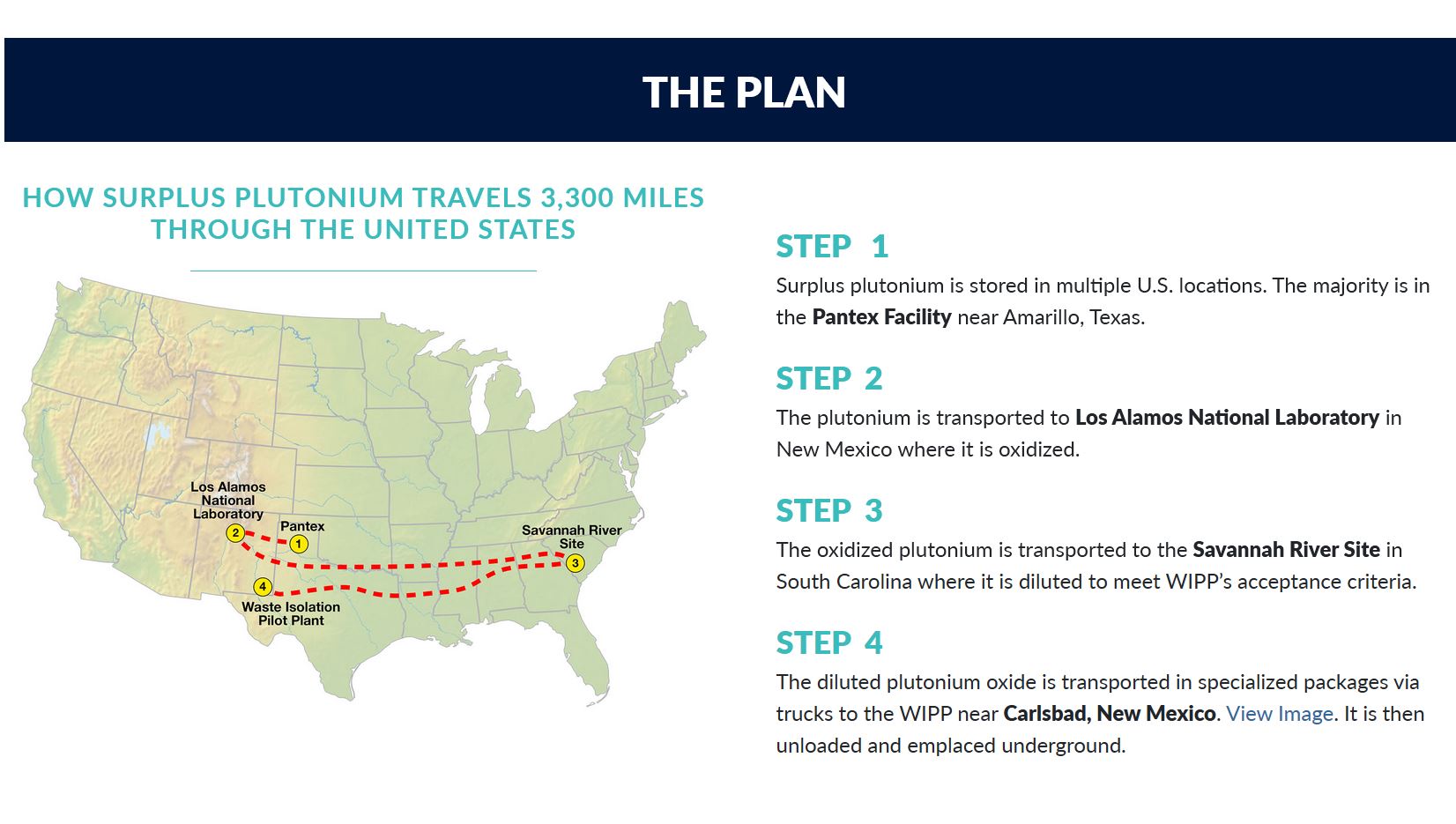 Santa Fe residents would see shipments of plutonium trucked through the city’s southern edge if federal agencies carry out plans announced nearly a year ago.
Santa Fe residents would see shipments of plutonium trucked through the city’s southern edge if federal agencies carry out plans announced nearly a year ago.
The prospect worries activists, local officials and some residents because plutonium is far more radioactive than the waste — contaminated gloves, equipment, clothing, soil and other materials — shipped from Los Alamos National Laboratory to the Waste Isolation Pilot Plant, an underground disposal site near Carlsbad.
The U.S. Department of Energy issued a notice of intent in December to begin the process for an environmental impact statement as one of the first steps toward diluting and disposing of plutonium left from the Cold War.
The notice hints that “downblending” the plutonium would be necessary to reduce radioactivity enough for the waste to be accepted at WIPP, which only takes low-level nuclear waste.
When the US Air Force Accidentally Dropped an Atomic Bomb on South Carolina
On March 11, 1958, the Gregg family was going about their business when a malfunction in a B-47 flying overhead caused the atomic bomb on board to drop on to their S.C. backyard.
By Allison McNearney | thedailybeast.com
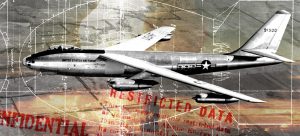 Given the history of nuclear proliferation throughout the 20th century, it seems like a miracle that only two atomic bombs were ever deployed against the human population. And, it turns out, it really was a very lucky break.
Given the history of nuclear proliferation throughout the 20th century, it seems like a miracle that only two atomic bombs were ever deployed against the human population. And, it turns out, it really was a very lucky break.
There is one part of atomic history that hasn’t made the history books. Throughout the Cold War, the U.S. dropped several atomic bombs on unsuspecting people below, bombs that were multiple times more powerful than those dropped on Hiroshima and Nagasaki at the end of World War II. Rather than being acts of extreme aggression, these “broken arrows” as they became known, were pure accidents, explosive “oopsies” committed by the U.S. military against mostly U.S. citizens. In what has been hailed as either luck or very proficient engineering of safety devices, none of the nuclear components on the falling bombs actually detonated.
Santa Fe County Nuclear Waste Emergency Response Town Hall October 19th
In response to community concerns about the proposed increased shipments of more dangerous forms of plutonium along New Mexico State Road 599, Santa Fe County District 2 Commissioner Anna Hansen will host a Nuclear Waste Emergency Response Town Hall on Tuesday, October 19th from 6 to 7:30 pm. Town Hall Nuclear Waste Flyer 10-19-21 The Department of Energy (DOE) has made elaborate plans to transport plutonium nuclear weapons triggers to Los Alamos National Laboratory (LANL) for processing. 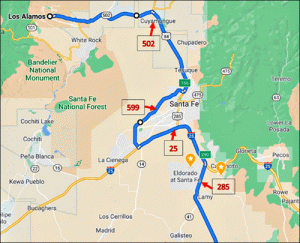 The triggers are currently stored at the Pantex facility, north of Amarillo, Texas. Questions and comments from the public are encouraged during the Town Hall. Town Hall Nuclear Waste Meeting Agenda 10-19-21
The triggers are currently stored at the Pantex facility, north of Amarillo, Texas. Questions and comments from the public are encouraged during the Town Hall. Town Hall Nuclear Waste Meeting Agenda 10-19-21
The proposed route is approximately 3,300 miles. Interstate 40 at Clines Corners would be the primary route to U.S. Route 285. The shipments would then head north to Interstate 25, past the Eldorado communities, before connecting with the 599 Bypass around Santa Fe. Much of the bypass is located within Commissioner Hansen’s district. From the bypass, the shipments would travel north on 285 to Pojoaque, then west on 502 to LANL. After processing, the shipments would follow the reverse route to Interstate 40 and east to the Savannah River Site in South Carolina for further processing. The shipments would once more head west to the Waste Isolation Pilot Plant (WIPP), near Carlsbad, New Mexico. Up to 47 metric tons of what is called “surplus” plutonium could be shipped, processed and disposed at WIPP.
 In response to constituent concerns, Santa Fe County Commissioners Hank Hughes and Anna Hamilton held a similar Town Hall at the Arroyo Hondo Fire Station in August. https://www.sfreporter.com/news/2021/08/10/waste-on-wheels/
In response to constituent concerns, Santa Fe County Commissioners Hank Hughes and Anna Hamilton held a similar Town Hall at the Arroyo Hondo Fire Station in August. https://www.sfreporter.com/news/2021/08/10/waste-on-wheels/
During the October 19th Town Hall, Cynthia Weehler, citizen activist and former chemistry teacher, will present highlights of the DOE’s proposal to expand the WIPP repository, including the transportation of additional weapons-grade plutonium throughout Santa Fe County. www.kob.com/new-mexico-news , www.santafenewmexican.com/opinion/my_view/speak-out-on-the-future-of-wipp/
Santa Fe County Fire Chief Jackie L. Lindsey will give a presentation about Santa Fe County’s emergency preparedness and response in the unlikely event of a toxic and radioactive waste incident. https://www.santafecountynm.gov/fire/fire_chief_and_command_staff
New Mexico State Representative Tara Lujan will also be in attendance. https://nmlegis.gov/Members/Legislator?SponCode=HLUTA
The Town Hall is being held at the Nancy Rodriguez Community Center, at One Prairie Dog Loop, in Santa Fe, which is off County Road 62 between the Agua Fria Fire Station and La Familia Medical Center.
For more information, please contact Anna Hansen, Santa Fe County Commissioner, at 505-986-6329, or ahansen@santafecountynm.gov. https://www.santafecountynm.gov/county_commissioners/anna_hansen
Radioactive Waste Fell On Some LA-Area Neighborhoods During 2018 Woolsey Fire, New Study Shows
The majority of samples found just “background” or normally occurring levels of radioactivity. But 11 samples showed significantly elevated levels of radioactive materials.
By Joel Grover and Josh Davis • abclosangeles.com
High levels of radioactive particles landed in neighborhoods from Thousand Oaks to Simi Valley during the massive 2018 Woolsey fire, which started at the contaminated Santa Susana Field Lab, according to a peer-reviewed study just published by a team of scientists known for studying environmental disasters.
What’s stunning about the findings is that they run contrary to what California’s Department of Toxic Substances Control (DTSC) said to calm public fears in the hours after the Woolsey Fire, “We do not believe the fire has caused any releases of hazardous materials… associated with contamination at the [SSFL] site.”
“The DTSC lied. They said that contamination from hadn’t migrated away from Santa Susana and the study proves that it has,” said Jeni Knack, part of a group of volunteers who helped collect samples analyzed in the study.
Knack participated in the sample collection because she had a background doing data collection on archaeological sites, and because she’s the mom of a 6-year old who lives in Simi Valley, just five miles from Santa Susana.
“I was afraid that radioactive and chemical contamination were being carried by wind and smoke during the fire,” Knack told NBC4.
Radioactive Waste Could Be Killing Residents in Missouri Community, Say Federal Scientists
For decades, North St. Louis residents have lived in fallout from the Manhattan Project. Now, federal scientists are finally linking today’s cancers to the nation’s nuclear warfare legacy.
By AUSTIN PRICE • earthisland.org
n Bridgeton, on the northern edge of St. Louis County, Missouri, a fire burns underground in a vast landfill, creeping closer and closer to a pile of radioactive waste from the World War II era that was dumped there back in the 1970s. This “subsurface smoldering event,” as these odorous, high-temperature chemical reactions are called, at the West Lake Landfill has burned continuously for almost a decade now, keeping nearby residents all too aware of the Superfund site in their backyard.

For years, many of these residents have filed lawsuits against Cotter Corporation and Mallinckrodt, the companies responsible for dumping the radioactive nuclear waste in the unlined landfill (a former limestone quarry) as well as in open piles on a field near what’s now the Lambert-St. Louis International Airport. These residents say that this waste has contaminated their homes. Many have sparred in open forums with officials from the Environmental Protection Agency. Others have met personally with EPA Administrator Andrew Wheeler. All want answers to an unending list of questions.
As Dawn Chapman, co-founder of the grassroots advocacy group Just Moms STL and a mother of three who lives 2 miles from landfill, told me, “The battles at this site never end.”
Meanwhile, the fire burns. Closer and closer to the radioactive waste, like a ticking time bomb. But for many North County residents, that bomb has already gone off, and it’s fallen to members of the community to pressure local and federal officials to help pick up the pieces. Now, federal scientists at the Agency for Toxic Substances and Disease Registry are finally starting to admit the mistakes of the nation’s toxic past.
Navy nuclear engineer and his wife charged with trying to share submarine secrets with a foreign country
By Devlin Barrett and Martin Weil | washingtonpost.com
The court papers say that in December 2020, an FBI official received a package that had been sent to the foreign country containing U.S. Navy documents, a letter and instructions for how to conduct encrypted communications with the person offering the information.
Abdul Qadeer Khan, Father of Pakistan’s Nuclear Program, Dies at 85
Starting from scratch in 1976, he acquired the technology and knowledge that allowed Pakistan to detonate its first nuclear device in 1998.
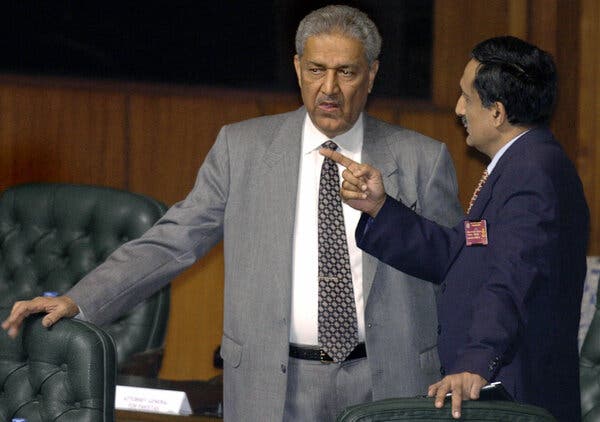
Abdul Qadeer Khan, a metallurgist who became known to Western intelligence services as the father of Pakistan’s nuclear bomb and a worldwide dealer in weapons technology, died Sunday at a hospital in Islamabad, Pakistan. He was believed to be 85 years old.
Dr. Khan’s death was reported by Pakistan’s interior minister, Sheikh Rasheed Ahmad. The apparent cause was complications from Covid-19, he said.
Dr. Khan was the man who made Pakistan a nuclear power. For at least 25 years, starting from scratch in 1976, he built, bought, bartered and stole the makings of weapons of mass destruction.
To millions of Pakistanis, he was a national hero, the man who developed a nuclear program to match the country’s rival, India. To the C.I.A., he was one of the more dangerous men on earth.
Pakistan’s prime minister, Imran Khan, on Sunday said that he was “deeply saddened” by Dr. Khan’s death, praising him for “his critical contribution in making us a nuclear weapon state.”
“This has provided us security against an aggressive, much larger nuclear neighbor,” Mr. Khan tweeted, referring to India. “For the people of Pakistan he was a national icon.”
International Day for the Total Elimination of Nuclear Weapons at Ghedi Base in Italy
View photos below of the initiative near the Italian base of Ghedi, which hosts US nuclear warheads, on the occasion of the International Day for the Total Elimination of Nuclear Weapons.



How do humans make sense of the bomb?
This stunning photo essay by Robert Del Tredici details the history of the atomic bomb through portraits of monuments, culture, and humans who co-exist with the bomb, from survivors to activists to nuclear scientists in At Work in the Fields of the Bomb.
Photography and introduction by Robert Del Tredici. Captions by Robert Del Tredici and Gordon Edwards. | October 9, 2021 | The Bulletin thebulletin.org
From the moment the atomic bomb was invented, humanity has struggled to make sense of it. It is a weapon of war, an enforcer of peace, a talisman of sovereignty, a fountainhead of undying radioactivity, and a fateful burden for humans into the far future. Yet the bomb’s physical presence—its deep grit and material magnitude of its mass production—has remained culturally invisible.
I wanted to take on this invisibility. I found out that the American bomb’s home ground had 12 factories, each making different materials and parts. I learned that each factory had a public relations officer. And I found out that the airspace above each plant was unrestricted.
But before engaging with the US nuclear weapons complex, I went to Hiroshima. I needed to find the human meaning of the bomb. One Hiroshima survivor told me, “If you weren’t there when it happened, you can have no idea what it was like.” Another told me, “Nuclear weapons and human beings cannot coexist.” I told them I wanted to photograph all of the American bomb-factories. An elderly survivor came over to me, put her hand on my arm and said, “Yes, you must do this.” Five years later, I completed my book of photographs and field notes, At Work in the Fields of the Bomb.

Model of the Uranium Atom
American Museum of Science and Energy, Los Alamos, New Mexico
June 11, 1982
Of all the naturally occurring materials found on Earth, uranium is the only element whose atoms can be split in a process that releases energy and neutrons in a chain reaction. The neutrons go on to split more atoms, which release more energy and more neutrons, until an exponential increase in energy ignites an atomic fireball. In the photo, two boys play at shouldering the model of the atom, which is too big for them to handle.
The atomic bomb was conceived within living memory, and unless abolition ends it, the bomb will be passed on to our grandchildren’s grandchildren—a burden weightier than Atlas could have imagined.
Nuclear talks with US to resume ‘soon,’ Iranian foreign minister says
The US left the JCPOA in 2018, citing continued malign behavior by Iran in the region, and implementing a “maximum pressure” sanctions regime, but Biden seeks a return to the policy.
“Until Iran returns to the negotiating table, the other parties must also make new decisions and show their will and intention for the success of the talks and fulfilling their commitments,” he added.
Ex-CEO who oversaw doomed nuclear project sentenced
An executive who lied to regulators about two South Carolina nuclear plants that never generated a watt of power has been sentenced to two years in prison
By JEFFREY COLLINS Associated Press abcnews.go.com October 7, 2021
COLUMBIA, S.C. — A utility executive who repeatedly lied to keep investors pumping money into South Carolina’s $9 billion nuclear reactor debacle will spend two years in prison for fraud, a federal judge decided on Thursday.
Former SCANA Corp. CEO Kevin Marsh agreed with prosecutors that he should serve the sentence and the judge approved the deal, making him the first executive put behind bars for misleading the public on the project, which failed without ever generating a watt of power.
Biden administration reveals number of nuclear weapons in US stockpile
“The Biden administration’s decision to declassify updated information on the number of nuclear warheads in the U.S. nuclear weapons arsenal is a welcome step that reverses an unwise decision by the Trump administration to classify this information,” the Arms Control Association said in a statement Wednesday.
“It also puts pressure on other nuclear armed states that maintain excessive secrecy about their arsenals.”
By Chandelis Duster and Nicole Gaouette, CNN, benningtonbanner.com October 7, 2021
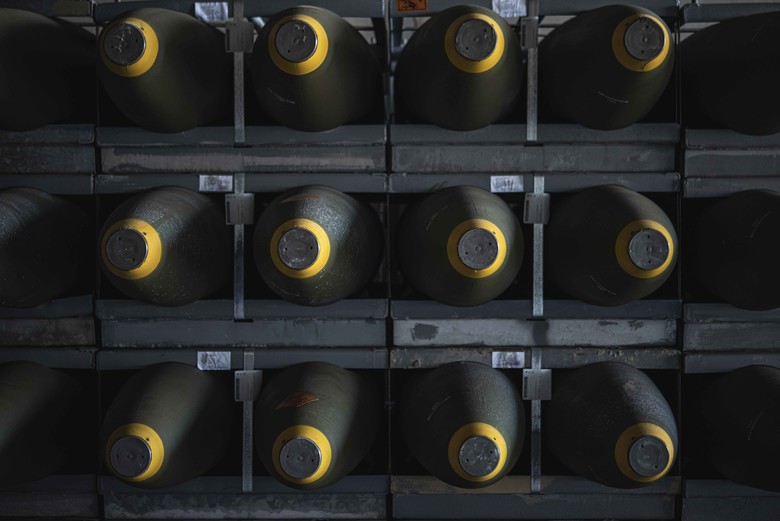
(CNN) In a reversal from the Trump administration, the State Department revealed the number of nuclear weapons in the US stockpile for the first time in four years on Tuesday.
“Increasing the transparency of states’ nuclear stockpiles is important to nonproliferation and disarmament efforts, including commitments under the Nuclear Non-Proliferation Treaty, and efforts to address all types of nuclear weapons, including deployed and non-deployed, and strategic and non-strategic,” the State Department said.
Nuclear submarines will not deter China from conflict with Taiwan, but Australia has an alternative arsenal
As a committed supporter of international institutions and the world’s 13th largest economy, Australia has real clout
“As the gap between China’s military and Australia’s widens, it is unlikely that Australia’s capability – even with a fleet of nuclear submarines, supplied by its Aukus partners – will determine the balance of military power in the Indo-Pacific.”
By Jonathan Pearlman October 6, 2021 The Guardian theguardian.com
For an emerging superpower prone to petulant outbursts and coercive retaliation, China’s initial response to the recent announcement of the new three-way security pact between Australia, the United States and Britain seemed surprisingly tepid.
Hours after the trio unveiled their “forever partnership”, known as Aukus, China formally requested that it be allowed to join an 11-member Asia-Pacific trade grouping, the Comprehensive and Progressive Agreement for Trans-Pacific Partnership (CPTPP).
This was an odd move by China, whose application requires the consent of the grouping’s members, which include Australia. In recent years, China has responded to previous perceived slights from Canberra by imposing economic sanctions worth $20bn and freezing ministerial contacts.
Nuclear-Weapon-Free States Demand Immediate End to Deterrence Policies, Start of Dismantling Atomic Arsenals, as First Committee Continues General Debate
Calling for swift remedies to mend a fractured non-proliferation landscape, nuclear-weapon-free States demanded an immediate end to deterrence policies and the start of dismantling atomic arsenals, as the First Committee (Disarmament and International Security) moved into the third day of its general debate.
UNITED NATIONS MEETINGS COVERAGE GENERAL ASSEMBLY FIRST COMMITTEE SEVENTY-SIXTH SESSION, 4TH MEETING (PM)
As thousands of atomic bombs located around the world pose grave risks to humanity, delegates implored nuclear-weapon States to steer the planet onto a path of peace. Some suggested such ways to do so, with delegates agreeing that dismantling nuclear arsenals must start now, in line with the Treaty on the Non-Proliferation of Nuclear Weapons and under safeguards established by the International Atomic Energy Agency (IAEA). Many urged all nations with atomic arsenals to sign, ratify and fully implement existing conventions, including the Treaty on the Prohibition of Nuclear Weapons, which entered into force in January, and some decried the quarter of a century delay in entering into force the Comprehensive Nuclear-Test-Ban Treaty. To rectify this, many called for nuclear-weapon States to sign and ratify it so that atomic bomb testing can become part of the past.
One Man Shouldn’t Control the Nuclear Button
Congress should require consultation, so generals wouldn’t have to break the rules to save the world.
The critics are missing the point. The overriding issue is not whether Gen. Milley was correct in his assessment, or whether he was authorized to take the reported actions, but what the consequences could have been if his concern had been warranted. It is not hyperbole to say that the consequences could have been a profound tragedy and, in the worst case, the end of civilization.
The Stealthy F-35 Fighter Jet Is One Step Closer to Carrying Nuclear Weapons
“A pair of F-35s from Nellis Air Force Base in Nevada released dummy nuclear bombs at a nearby test range this month, moving the advanced stealth fighter closer to carrying the world’s most powerful weapons into combat, the Air Force said.”
By Stephen Losey • military.com
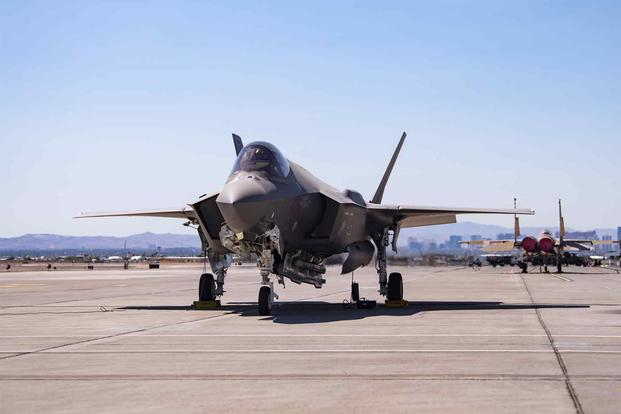
The flights on Sept. 21 marked the “graduation” test exercise necessary for the Air Force variant of the F-35 to move ahead with what’s called the nuclear design certification process, according to the service’s press release.
It’s still not clear when the F-35A will receive its full nuclear certification allowing it to move from training ranges and dummy bombs to real-world battlefields. But when that happens, the Air Force will have a second stealth aircraft in its fleet that can carry nukes.
“The B-2 [Spirit] bomber was the prominent nuclear-capable stealth aircraft,” Lt. Col. Daniel Jackson, division chief for strategic deterrence and nuclear integration at Air Combat Command, said in the press release.
F-15E Strike Eagle and F-16C and D Fighting Falcon fighters do not have stealth capability but can carry nuclear weapons. The B-21 Raider heavy bomber will also have the capability and is expected to join the Air Force’s fleet in the mid-2020s, according to the latest estimates.
Opinion: Too many ‘downwinders’ are still suffering
“We are sponsoring a bill that would make sure the government’s responsibility to those who were harmed by nuclear testing does not get swept under the rug.”
By Burgess Owens and Chris Stewart deseret.com
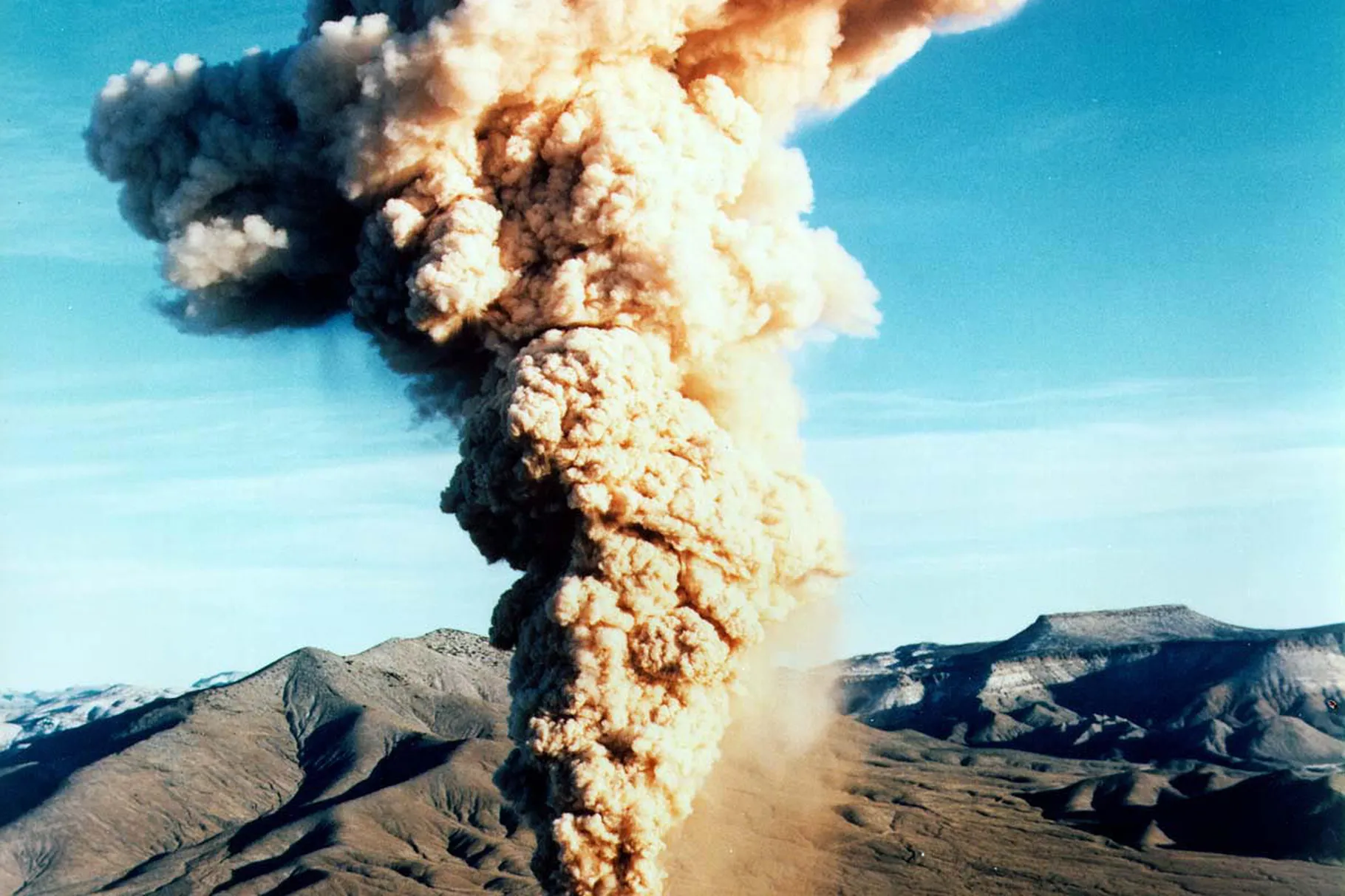
Any objective study of American history brings us to the realization that there are many Americans who quietly made, and continue to make, great sacrifices for our national security. Many of these women and men willingly give of themselves to ensure that our country remains free.
Tragically, under the banner of national security the United States government exposed Americans to radioactive uranium ore and radioactive dust — subjecting them to lung cancer and other respiratory illnesses.
On July 16, we marked the 76th anniversary of the detonation of the first nuclear weapon — code-named Trinity — in the desert of New Mexico’s Tularosa Basin. Three weeks after the Trinity detonation, the United States exploded the Little Boy bomb over Hiroshima and, three days later, the Fat Man bomb over Nagasaki. Six days later, Japan surrendered. In the aftermath of World War II, a nuclear arms race began that reached its zenith with over 60,000 nuclear weapons worldwide in 1986.
Many lives were lost or severely altered by the nuclear weapons program. Thankfully, the world stockpile of nuclear weapons has steadily declined since 1986 and will, hopefully, continue to do so in the future. Yet, the effects of detonating over 1,100 nuclear weapons since the Trinity test in 1945 continue to mar the lives of Americans to this day.
Through atmospheric weapons tests, as well as mining, transporting and milling of uranium ore, many Americans have been slowly killed by radiation exposure. Thousands of Utahns were infected by radiation exposure simply by living “downwind” of the federal government’s nuclear weapons testing sites. Additional Utahn miners were affected as they worked the uranium necessary for these weapons. These “downwinders” and miners and their families friends, and communities often suffered excruciating illness, loss and devastation.
In response to this malfeasance, Congress rightly enacted (and later amended in 2000) the Radiation Exposure Compensation Act (RECA) in 1990. This legislation was a good first step in making recompense to those who mined and hauled uranium ore and those who processed the ore at a mill. The RECA legislation also addresses those exposed to radiation downwind from nuclear test sites.
It has been more than 20 years since any meaningful reform to RECA has been made for those whose lives have been taken or irreversibly altered by our foray into the arms race. Several classifications of workers such as core drillers and ground workers have been denied justice by being excluded completely from the process.
Some diseases that should have been compensable have been excluded. Numerous geographical locations exposed to downwind radiation have been left out. Uranium miners continued to mine after the United States stopped buying uranium for its nuclear weapons programs in 1971. These so-called post-1971 workers were excluded from accessing benefits since the original RECA legislation had an arbitrary cutoff date of Dec. 31, 1971 — even though the federal government continued to regulate uranium mines long after 1971. To make matters worse, RECA is scheduled to sunset in July 2022 — potentially leaving all classifications of exposure victims without redress.
We are honored to represent some of these “downwinders” and their family members and want them to know their suffering — and the sacrifices they made for our nation — are not forgotten.
That is why we are pleased to be the lead Republican members of the House of Representatives on the “RECA Amendments Act of 2021,” legislation that will reauthorize RECA for those still suffering the consequences of nuclear testing.
The tragic consequences of the nuclear arms race cannot be swept under the rug of history. We urge our colleagues in Congress to support the “RECA Amendments Act of 2021.” Our country must act now to address the injustices of those who have been forgotten by their own government.
Rep. Burgess Owens represents Utah’s 4th Congressional District. Rep. Chris Stewart represents Utah’s 2nd Congressional District.
Four Takeaways from the 2021 World Nuclear Industry Status Report
“Although net nuclear capacity rose last year, the 0.4-gigawatt increase was minuscule in comparison with the gains made by renewable energy. ‘Nuclear is irrelevant in today’s electricity capacity newbuild market,’ the industry report concludes.”
By Dawn Stover | October 1, 2021 The Bulletin thebulletin.org
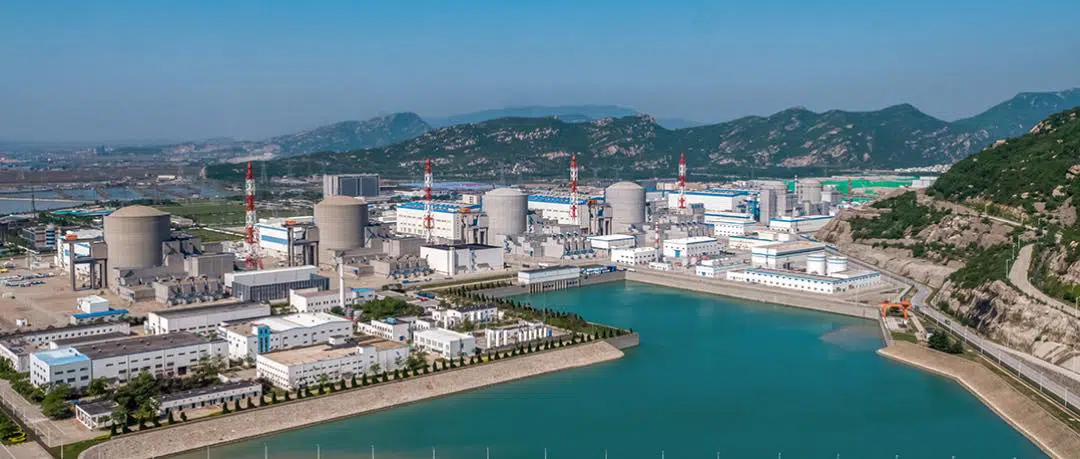
Although there are 23 fewer nuclear reactors in the world today than at the 2002 peak of 438, the past year saw a small uptick in the number of reactors operating worldwide and a corresponding increase in the global fleet’s net operating capacity.
That’s one data point in the World Nuclear Industry Status Report 2021, the latest in a series of annual industry reports compiled by an international team of independent experts led by Mycle Schneider, a consultant based in Paris. The 409-page report, released this week, is packed with information about global and country-specific trends, but several findings stand out, and they don’t bode well for the nuclear energy industry.
First, although nuclear capacity is up, nuclear electricity production is down.
As of mid-2021, there were 415 nuclear reactors operating in 33 countries, seven reactors more than a year earlier. Their total capacity was 1.9 percent higher than a year earlier. But in 2020, the worldwide nuclear fleet generated 3.9 percent less electricity than in the previous year. That was the first decrease in output since 2012, when many reactors remained shut down in the wake of the Fukushima nuclear disaster.
Without China, where most of the new construction is happening, the decrease in production would look even bigger. In 2020, China for the first time produced more nuclear electricity than France, which relies heavily on nuclear energy. Only the United States produced more.
NRDC: Legislation Offers Path Forward on Nuclear Waste
“This legislation could end years of debate and acrimony and help determine a path forward for disposing of nuclear waste. Placing nuclear waste under bedrock environmental laws could ensure strong repository standards, while giving states the power to approve what is sequestered within their borders.”
– Kit Kennedy, managing director for the Climate and Clean Energy program at NRDC (Natural Resources Defense Council)
WASHINGTON – Sen. Ed Markey (D-Mass.) and Rep. Mike Levin (D-Calif.) introduced legislation today that could end a 60-year impasse over our nation’s nuclear waste.
The bill would establish a task force to consider removing exemptions for radioactive waste and spent nuclear fuel from our bedrock environmental laws. Doing so would allow for geologic repositories for nuclear waste that have strong environmental protections and the consent of state leaders and local residents.
Senator Markey and Rep Levin Introduce Legislation to Determine a Viable Consent Based Path Forward for Nuclear Waste
Currently, the United States has no permanent geologic repository for disposal of high-level nuclear waste
“The current system of spent nuclear fuel storage is not sustainable, particularly for sites that no longer have operating reactors and could be redeveloped for other beneficial uses, such as the San Onofre Nuclear Generating Station,” said Representative Levin.
PRESS RELEASE September 28, 2021 markey.senate.gov
Washington (September 28, 2021) – Senator Edward J. Markey (D-Mass.), Chair of the Clean Air, Climate, and Nuclear Safety Subcommittee of the Senate Environment and Public Works Committee, and Congressman Mike Levin (CA-49) today introduced the Nuclear Waste Task Force Act, legislation to establish a new task force to consider the implications of amending the Atomic Energy Act of 1954 to remove exemptions from environmental laws for nuclear waste. Eliminating this loophole could help enable consent-based siting of long-term storage solutions for nuclear waste. The task force would also be responsible for providing a clear explanation of what constitutes “consent-based siting.”
“Enabling consent-based storage is the key to developing real, practical solutions for the long-term storage of nuclear waste. This nuclear waste task force will play a critical role in determining how to make that happen.”
Survivors Of The Trinity Nuclear Test Weren’t Warned — Then Were Lied To After
NPR’s Leila Fadel talks with Lesley Blume about the struggle of the survivors of the Trinity nuclear test in 1945 — one locals didn’t know was coming and caused serious health issues.
“The compensation act – RECA as it’s called – is about to expire next July…What’s happening right now is that several members of Congress from New Mexico and from other Western states are trying to extend RECA, and they’re making a bid to have the Trinity downwinders included under this legislation at last, among other exposed communities.”
NPR News Heard on All Things Considered
An aerial view of the aftermath of the first atomic explosion at the Trinity test site in New Mexico in 1945. The device exploded with a power equivalent to 21,000 tons of TNT. Credit Associated PressLEILA FADEL, HOST:
This was most of America’s introduction to nuclear power.
(SOUNDBITE OF ARCHIVED RECORDING)
HARRY TRUMAN: A short time ago, an American airplane dropped one bomb on Hiroshima and destroyed its usefulness to the enemy.
FADEL: President Harry Truman’s announcement in August of 1945 heralded a terrifying new weapon.
(SOUNDBITE OF ARCHIVED RECORDING)
TRUMAN: It is an atomic bomb. It is a harnessing of the basic power of the universe. The force from which the sun draws its power has been loosed against those who brought war to the Far East.
FADEL: But the Atomic Age actually began the month before At the Alamogordo Bombing and Gunnery Range in New Mexico. The first nuclear test, codenamed Trinity, was a closely guarded secret. Locals, some as close as 12 miles away, had no idea it was coming. Lesley Blume wrote about them for National Geographic.
Welcome back.
LESLEY BLUME: Thank you so much.
FADEL: So, first, tell us what happened during that first test, codenamed Trinity.
BLUME: It was a huge success, but it also – the bomb was a lot more powerful than they had expected, three to five times as powerful. And, you know, initially they thought that the cloud was only going to go up about 12,000 or 13,000 feet. Well, guess what. It went up between 50,000 and 70,000 feet. It created sort of an estimated fallout zone about 100 miles long and 30 miles wide…
“Now is the time to eliminate nuclear weapons from our world, and usher in a new era of dialogue, trust and peace”, declared UN Secretary-General António Guterres on Sunday, marking the International Day for the Total Elimination of Nuclear Weapons.
Addressing the threat of nuclear weapons, said Mr, Guterres, has been central to the work of the United Nations since its inception; the first General Assembly resolution in 1946 sought “the elimination from national armaments of atomic weapons and of all other major weapons adaptable to mass destruction.”
The UN chief pointed out that, although the total number of nuclear weapons has been decreasing for decades, some 14,000 are stockpiled around the world, which is facing the highest level of nuclear risk in almost four decades: “States are qualitatively improving their arsenals, and we are seeing worrying signs of a new arms race.” Humanity, continued the UN chief, remains unacceptably close to nuclear annihilation.
Veterans Group Urges President Biden to Adopt No First Use Policy
To mark the International Day for the Total Elimination of Nuclear Weapons, September 26, Veterans For Peace is publishing an Open Letter to President Biden: Just Say NO to Nuclear War!

ST. LOUIS, MO –
Veterans For Peace, with over 140 chapters in the United States and affiliates abroad, is calling on President Biden to step back from the brink of nuclear war by declaring and implementing a policy of No First Use and by taking nuclear weapons off hair-trigger alert. The full letter will be published on the VFP website and offered to mainstream newspapers and alternative news sites: Click here to view.
While timed to coincide with the UN-declared International Day for the Total Elimination of Nuclear Weapons, a major motivation for the letter is the Nuclear Posture Review, currently underway.
The letter therefore states, “As veterans who have fought in multiple U.S. wars, we are concerned about the very real danger of a nuclear war that would kill millions of people and could possibly even destroy human civilization. Therefore we are asking to have input into the Nuclear Posture Review that your administration has recently initiated.”
A Little Radiation Is Not Good For You
“…between 1977 and 1990, scientists tripled their estimate of the damage inflicted by a given dose of radiation. A 1992 study published in the American Journal of Industrial Medicine found that nuclear weapons production workers exposed to small doses were four to eight times more likely to contract cancer than previously estimated…even the very lowest background levels of radiation exposure are harmful to health and have statistically significant negative effects on DNA.”
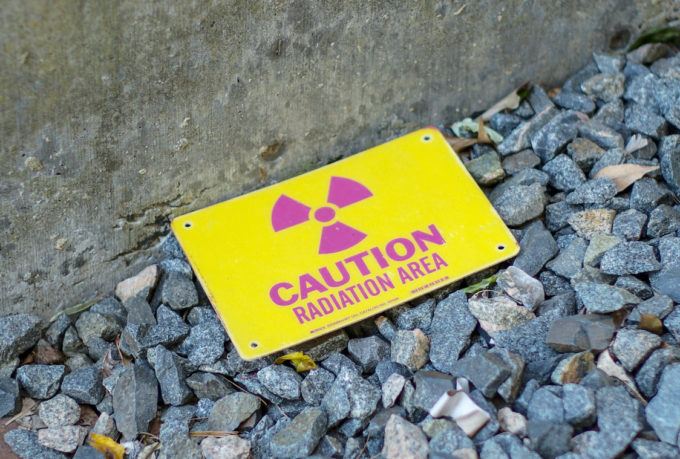
In a rare pushback against the radioactive pollution industry, the Nuclear Regulatory Commission — well known as a rubber stamp for the nuclear lobby — has flatly rejected an attempt to further weaken the agency’s radiation exposure regulations.
After six years of deliberation, the NRC’s three commissioners, two Democrats and one Republican, voted unanimously to reject formal petitions submitted in February 2015 urging the agency to adopt a cost-cutting scheme known as “hormesis” which claims that “a little radiation is good for you.” The September 16 decision by the NRC says this “threshold theory posits that “there is some threshold dose below which there is either no radiation-related health detriment or a radiation-related health benefit that outweighs any detriment.”
The order then rebukes this concept, finding the petitioners “fail to present an adequate basis supporting the request,” and “Convincing evidence has not yet demonstrated the existence of a threshold below which there would be no … effects from exposure to low radiation doses.”
The basis for hormesis had been explicitly rejected ten years earlier, the NRC pointed out, by the National Academy of Sciences in its 2005 report “Biologic Effects of Ionizing Radiation, 7th Ed” or BEIR-VII. The National Research Council summed up its book-length BEIR-7 report saying, “the smallest dose has the potential to cause a small increase in risk to humans.”
Biden’s nuclear agenda in trouble as Pentagon hawks attack
“The decision to fire Leonor suggests to me that the first draft of NPR is going to be a continuation of the line of thinking we saw in the Trump administration’s NPR…They have put themselves on the course that is a first draft that is 180 degrees to what Biden said on the campaign trail.” – Jeffrey Lewis, a professor and nuclear weapons expert at the Middlebury Institute for International Studies and host of the podcast Arms Control Wonk.
By BRYAN BENDER and LARA SELIGMAN | September 23, 2021 politico.com
One of President Joe Biden’s leading allies in his decadeslong attempt to reduce nuclear weapons has lost a battle with the Pentagon’s hawks.
The ouster of Leonor Tomero, who questioned the status quo on nuclear weapons, signals the Biden administration’s ambitious agenda to overhaul America’s nuclear policy might be in trouble.
Early in his administration, Biden installed national security officials intent on negotiating new arms control treaties and curtailing nuclear weapons spending. One of them was Tomero, a leading voice for nuclear restraint on Capitol Hill and in the think tank community, who was appointed to oversee the Nuclear Posture Review that will set the administration’s atomic weapons policy and strategy.
But officials with more traditional views on nuclear weapons, who promote a status quo agenda to include modernizing the land, sea and airborne legs of America’s nuclear arsenal, did not take kindly to Tomero’s progressive ideology, according to 11 current and former defense officials, as well as others with insight into the debate.
New push on to expand nuclear radiation compensation in US
“There is always money when there’s political will. This is a social, environmental and restorative justice issue that we, as a nation, can no longer look away from.” — Tina Cordova, a cancer survivor and co-founder of the Tularosa Basin Downwinders Consortium
By SUSAN MONTOYA BRYAN | AP apnews.com September 22, 2021
Corbin Harney, an elder with the Western Shoshone Tribe, beats a drum during a May 2002 tribal protest near the planned Yucca Mountain national nuclear waste dump.ALBUQUERQUE, N.M. (AP) — A bipartisan group of lawmakers is renewing a push to expand a U.S. compensation program for people who were exposed to radiation following uranium mining and nuclear testing carried out during the Cold War.
Advocates have been trying for years to bring awareness to the lingering effects of nuclear fallout surrounding the Trinity Site in southern New Mexico, where the U.S. military detonated the first atomic bomb, and on the Navajo Nation, where more than 30 million tons of uranium ore were extracted over decades to support U.S. nuclear activities.
Under legislation introduced Wednesday by U.S. Sens. Ben Ray Luján, a Democrat from New Mexico, and Mike Crapo, a Republican from Idaho, other sites across the American West would be added to the list of places affected by fallout and radiation exposure. Eligibility also would be expanded to include certain workers in the industry after 1971, such as miners.
The legislation also would increase the amount of compensation someone can receive to $150,000 and provide coverage for additional forms of cancer.
Op-Ed: Gen. Milley did the wrong thing for honorable reasons. We need new rules for starting nuclear war
“But let’s be clear about where the problem lies: It’s with the existing U.S. system for controlling the use of nuclear weapons… If the United States is intent on maintaining at the ready a large nuclear strike force, as is apparently the case, the nation needs comprehensive safeguards to prevent reckless and ill-considered decisions regarding their use.”
By Andrew Bacevich | LA Times latimes.com September 16, 2021
A new book by journalists Bob Woodward and Robert Costa contains a singularly startling allegation. In the waning weeks of the Trump administration, Gen. Mark Milley, chairman of the Joint Chiefs of Staff, twice called his counterpart, Gen. Li Zuocheng, of the People’s Liberation Army, offering assurances that the United States was not about to launch an attack against China.
“If we’re going to attack,” Milley told Li, according to Woodward and Costa, “I’m going to call you ahead of time. It’s not going to be a surprise.”
The surprise turns out to be the revelation of Milley’s actions. Some in the Defense Department may have known about the calls, but one thing seems clear: President Trump, the U.S. commander in chief, did not. Milley acted of his own volition, without prior presidential approval. On that point, Christopher Miller, then serving as acting Defense secretary, is emphatic, describing Milley’s actions to Fox News as a “disgraceful and unprecedented act of insubordination.”
Providing adversaries with advance notice of U.S. military actions does not number among the prescribed duties of the chairman of the joint chiefs. Arguably, the Woodward-Costa allegations, if accurately reported, qualify as treasonous. At the very least, they raise serious doubts about Milley’s respect for the bedrock principle of civilian control of the military. To state the matter bluntly, when adherence to that principle raised the possibility of an outcome not to Milley’s liking, he seemingly granted himself an exemption.
Of course, all of this happened in a specific context: Woodward and Costa’s chilling account is only the latest to depict the unraveling Trump presidency following the November election. Unwilling to accept defeat, the incumbent all but ceased to govern and instead devoted himself to overturning the election’s results by any means necessary, violating the rule of law and waiving the Constitution.
Kildee Introduces Bipartisan Resolution Opposing Proposed Canadian Permanent Nuclear Storage Site Near Great Lakes
By Devlin Barrett and Martin Weil | September 16, 2021 Press Release dankildee.house.gov
Woodward/Costa book: Worried Trump could ‘go rogue,’ Milley took secret action to protect nuclear weapons
“Woodward and Costa write that after January 6, Milley ‘felt no absolute certainty that the military could control or trust Trump and believed it was his job as the senior military officer to think the unthinkable and take any and all necessary precautions.’
Milley called it the ‘absolute darkest moment of theoretical possibility,‘ the authors write.”
By Jamie Gangel, Jeremy Herb and Elizabeth Stuart, CNN September 14, 2021
Washington (CNN) Two days after the January 6 attack on the US Capitol, President Donald Trump’s top military adviser, Joint Chiefs Chairman Gen. Mark Milley, single-handedly took secret action to limit Trump from potentially ordering a dangerous military strike or launching nuclear weapons, according to “Peril,” a new book by legendary journalist Bob Woodward and veteran Washington Post reporter Robert Costa.
Woodward and Costa write that Milley, deeply shaken by the assault, ‘was certain that Trump had gone into a serious mental decline in the aftermath of the election, with Trump now all but manic, screaming at officials and constructing his own alternate reality about endless election conspiracies.’
“You never know what a president’s trigger point is,” Milley told his senior staff, according to the book.

A private company got federal approval to store nuclear waste in Texas. The state is fighting back.
“The Nuclear Regulatory Commission’s approval of the planned facility opens a new front in a decades-long battle to find a home for the country’s nuclear waste.”
By: Douglas MacMillan and Aaron Gregg | THE WASHINGTON POST September 12, 2021 washingtonpost.com
A private company has won federal approval to build an expansive nuclear waste site in Texas, even as residents, state lawmakers, environmentalists and Texas Gov. Greg Abbott (R) rail against it.
The Nuclear Regulatory Commission (NRC) on Monday issued a license for Andrews, Tex.-based Interim Storage Partners to store as much as 5,000 metric tons of radioactive waste. It’s one of two proposed storage sites — the other is in southeastern New Mexico — that has been under agency review for several years.
Nuclear waste facility near Carlsbad sees COVID-19 surge as infections rise in New Mexico
COVID-19 infections resurged at the Waste Isolation Pilot Plant in recent weeks as cases of the virus climbed in the communities surrounding the nuclear waste repository in southeast New Mexico.
There were 14 positive cases among workers at the site or associated with the facility reported between Aug. 17 and 31, per the latest report from Nuclear Waste Partnership (NWP) – WIPP’s primary operations contractor.
In total, WIPP reported as of Aug. 31, there were 25 active cases.
WIPP officials did not report the identities of patients or companies where the infected workers were employed.
All employees at WIPP were encouraged to receive a COVID-19 vaccination, per an NWP news release, and required to wear protective face masks when indoors, vaccinated or not, and social distance when possible.
U.S. still prepared to engage with North Korea after missile test
“North Korea’s cruise missiles usually generate less interest than ballistic missiles because they are not explicitly banned under United Nations Security Council resolutions. However, analysts said calling it “strategic” could mean it was a nuclear-capable system.”
Reuters reuters.com September 13, 2021
ABOARD AIR FORCE ONE, Sept 13 (Reuters) – The United States remains prepared to engage with North Korea, a White House spokeswoman said on Monday, despite Pyongyang’s announcement that it had tested a new long-range cruise missile over the weekend.
“Our position has not changed when it comes to North Korea, we remain prepared to engage,” principal deputy press secretary Karine Jean-Pierre told reporters.
North Korea’s state media announced on Monday what it said were successful tests of a new long-range cruise missile that analysts said could be the country’s first such weapon with a nuclear capability. read more
U.S. officials, speaking on the condition of anonymity, said initial indications were that North Korea had carried out such a test.
Biden blasted for ‘wishful thinking’ as new ‘potential nuclear crisis’ looms
“Iran deserves a measure of the blame for resurrecting a matter that diplomats spent more than a dozen years putting to rest…It is the US that is overwhelmingly responsible for the current crisis.”
The US President promised throughout the 2020 election campaign he would restore the Joint Comprehensive Plan of Action (JCPOA) with Iran, which Donald Trump withdrew from in 2018. However, his administration are reportedly getting “closer” to giving up on the deal.
Since Mr Biden took office on January 20, Iran elected hardline judge Ebrahim Raisi as their new President.
While talks have been held between Washington and Tehran on renewing the JCPOA, no new agreement has been struck.
Borzou Daragahi, senior non-resident fellow at Washington think tank the Atlantic Council, said Mr Biden’s administration “still needs to figure out what it wants in Iran”.
Why China’s attack on Nato ‘double standards’ suggests it will continue to build up nuclear arsenal
“The alliance’s head Jens Stoltenberg accused Beijing of increasing its firepower ‘without constraint’ and urged it to sign up to international arms controls – But Beijing hit back by criticising Nato’s nuclear sharing arrangements and said the US and Russia should lead the way by disarming”
Liu Zhen scmp.com September 12, 2021
China is expected to continue building up its arsenal of nuclear weapons despite Nato’s appeal for it to sign up to international arms controls. Last week Nato Secretary-General Jens Stoltenberg criticised China’s efforts to develop its nuclear capacity – by building more warheads, delivery systems and silos – “without any limitation or constraint”.
He told Nato’s annual arms control conference in Brussels that this was making the world “more unpredictable, more competitive and more dangerous”.
20 years after 9/11, Yankee’s nuclear fuel still poses security risk
“Deb Katz, the executive director of Citizens Awareness Network, a New England-wide anti-nuclear group, said her group supports ambitious improvements to the storage facilities.
“We support hardening the waste on site. This includes double walling the casks, increasing the distance between the casks, if possible, berming them in to protect them from acts of malice,” she said.
“The waste must stay on site until there is a scientifically sound and environmentally just solution,” she said, referring to a nuclear industry move toward building interim nuclear waste storage facilities. One is proposed for west Texas, the other in New Mexico.”
By Susan Smallheer, Brattleboro Reformer benningtonbanner.com September 11, 2021
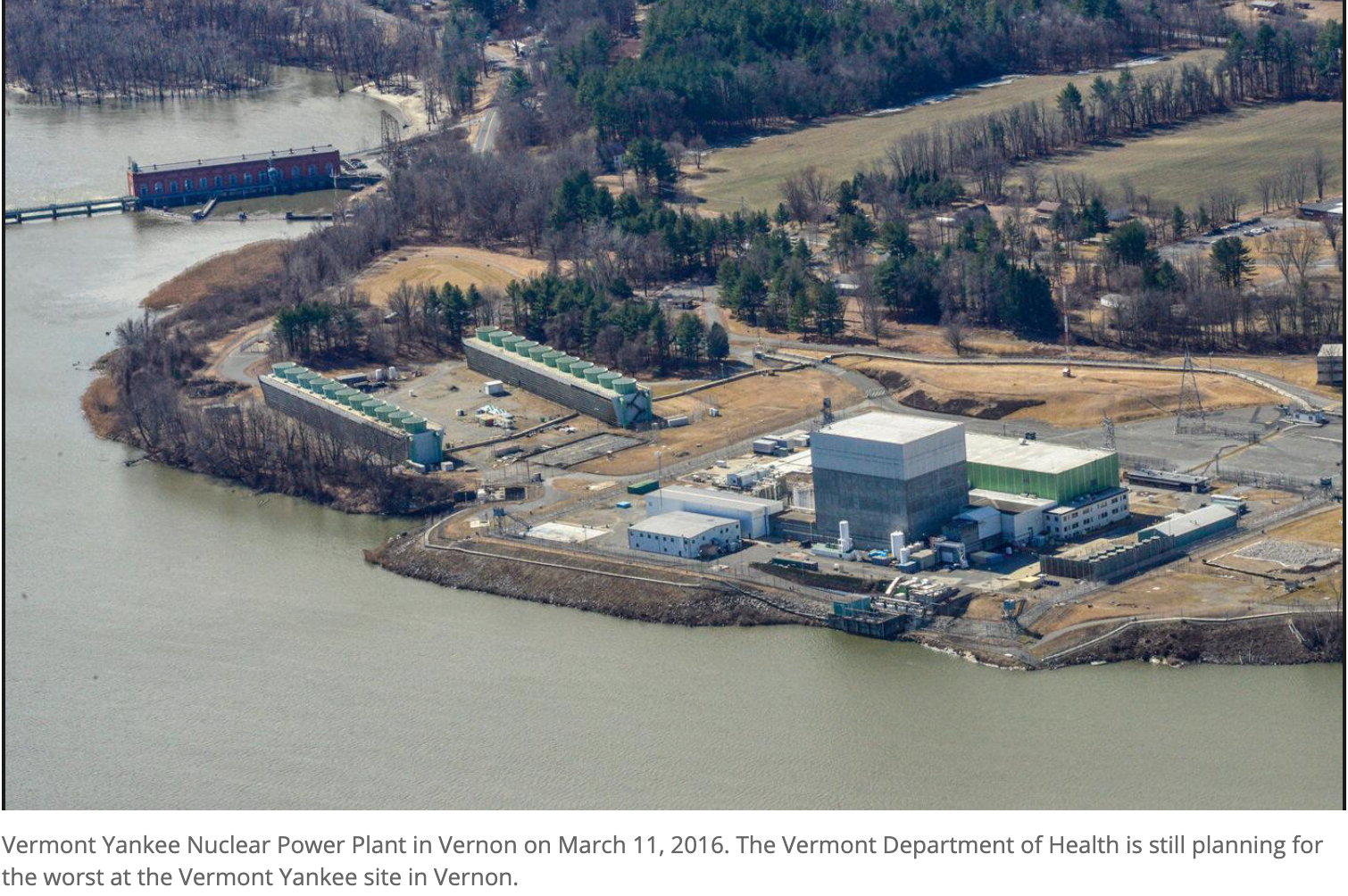
VERNON — The Vermont Department of Health is still planning for the worst at the Vermont Yankee site in Vernon.
But the worst, thanks to the active decommissioning of the Vermont Yankee site currently underway, is not as bad as it could have been six years ago, when Vermont Yankee shut down and its nuclear fuel was moved out of the reactor core and put into storage in giant steel and concrete casks.
“The Health Department’s Radiological and Nuclear Emergency Response Plan originally had a heavy emphasis on releases from Vermont Yankee, which could impact large areas and populations while it operated. Even with the shutdown of Vermont Yankee, we continue to maintain many of our resources for radiological emergency response,” said William Irwin, the state’s radiological health chief.
Texas bans storage of highly radioactive waste, but a West Texas facility may get a license from the feds anyway
The new law may soon be in conflict with federal regulators. A decision from the Nuclear Regulatory Commission on one company’s license could come as early as Monday.
BY ERIN DOUGLAS
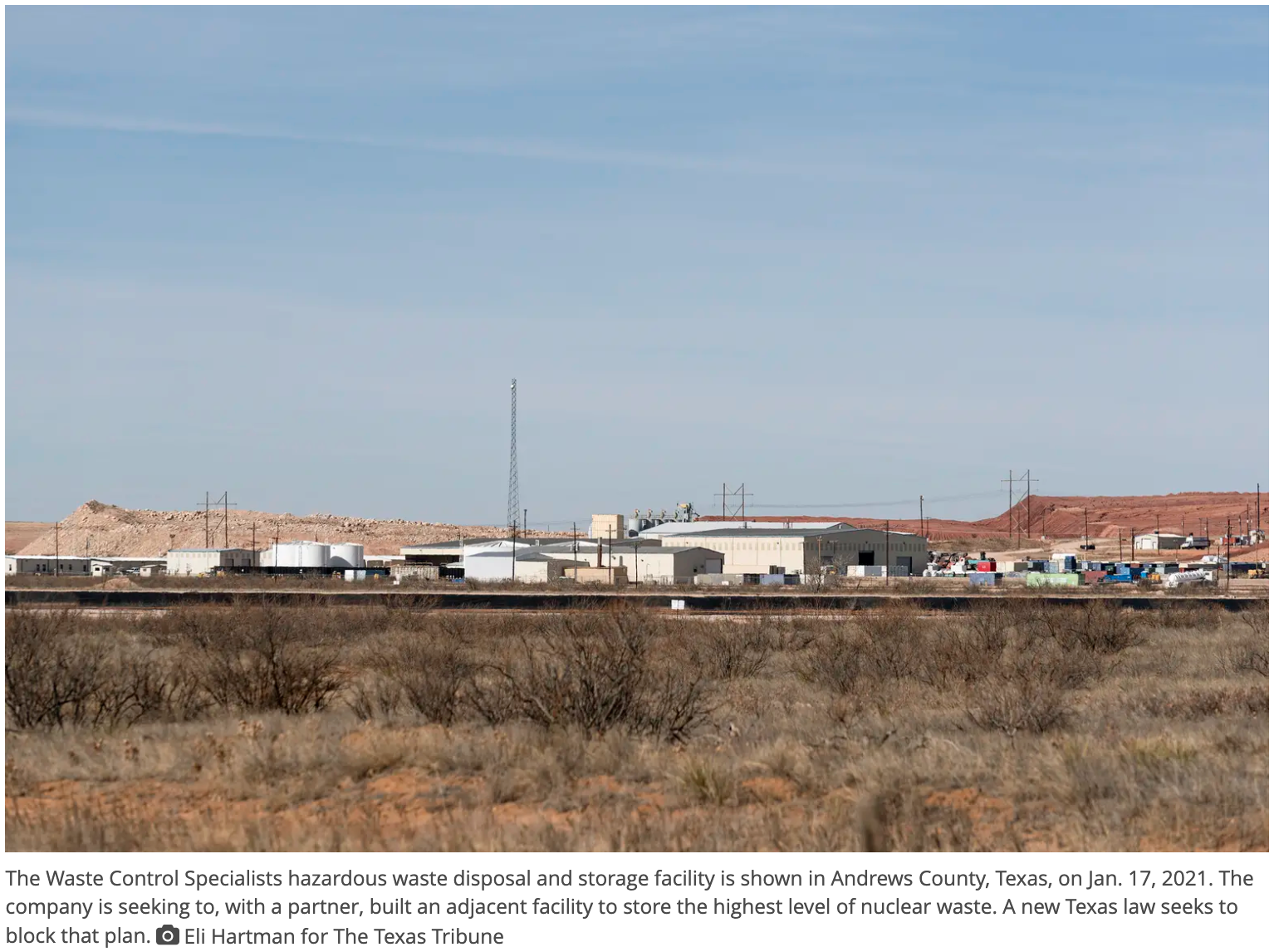
Gov. Greg Abbott on Thursday night signed a bill into law that attempts to block a plan to store highly radioactive nuclear waste at a site in West Texas.
House Bill 7 effectively bans highly radioactive materials from coming to Texas, targeting one company’s plan to build such a facility near the New Mexico border in Andrews County.
But, the new state law may soon be in conflict with federal regulators. The Nuclear Regulatory Commission is advancing the company’s application for a license to allow the high-level nuclear waste to Texas, and a decision from the federal agency could come as early as Monday, a spokesperson with the commission said.
For years, environmental and consumer advocates have protested a proposal by a West Texas company, Waste Control Specialists, to build with a partner an interim storage site for high-level nuclear waste, which is mostly spent fuel rods from nuclear power plants. Waste Control Specialists has been disposing of the nation’s low-level nuclear waste, including tools, building materials and protective clothing exposed to radioactivity, for a decade in Andrews County.
Continue reading
Lawmakers set for battle over next-gen nuclear missile
“For the W87-1, whose plutonium cores, or pits, are to be produced in part by the Savannah River Plutonium Processing Facility in South Carolina, at stake are jobs and billions of federal dollars to upgrade buildings or construct new factories. It’s all intertwined with shaky plans launched by the Trump administration to have Savannah River and Los Alamos National Laboratory in New Mexico produce a combined 80 pits per year by 2030.”
Joe Gould defensenews.com September 9, 2021
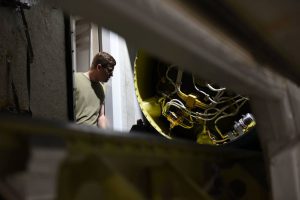
WASHINGTON ― Nuclear modernization opponents and defenders are gearing up to fight again over the next-generation intercontinental ballistic missile and other efforts.
Rep. John Garamendi, D-Calif., and a skeptic of nuclear spending on the House Armed Services Committee, confirmed he plans to offer nuclear-themed amendments when the annual defense bill receives House floor consideration later this month. One aims to pause the Air Force’s nascent Ground Based Strategic Deterrent in favor of maintaining the missile it would replace, the Minuteman III; another would zero out funds for the GBSD’s warhead, the W87-1.
“The bottom line is that we could pause the entire GBSD program and push forward into the future a $100 billion expense,” Garamendi, who chairs the House Armed Services readiness subcommittee, told Defense News.
With the Biden administration’s Nuclear Posture Review due early next year, Garamendi said the amendments are part of his “strategy to raise the issues, to gather the data, test the arguments against the opposition … and create an occasional success.”
More nuclear waste may be heading to WIPP on US 285
[WIPP is the world’s only operating underground nuclear waste dump. It is limited to nuclear weapons waste, but the federal government is trying to expand WIPP and break its promises and social contract with New Mexicans.
Help Us STOP FOREVER WIPP-Waste Isolation Pilot Plant. The nuclear waste dump is permitted to operate until 2024, but the Federal government wants to expand the amount and types of waste allowed with NO end date.
We need your help to protect New Mexico!]
“At a recent Santa Fe County Town Hall, activist Cindy Weehler of 285 ALL said the U.S. Department of Energy made it clear that it’s going to expand its nuclear waste program, she said. She said she’s concerned about the new type of radioactive waste that would be traveling through the county, which would be diluted plutonium, instead of contaminated items.”
BY ISABELLA ALVES / JOURNAL NORTH abqjournal.com Copyright © 2021 Albuquerque Journal
Spanning the length of the state, U.S. Highway 285 is a major thoroughfare for truck transports and other traffic. This busy highway, nicknamed “Death Highway” due to the number of fatal accidents on it, may get busier.
Concerned citizens in Santa Fe County recently called out the U.S. Department of Energy’s Waste Isolation Pilot Plant for expanding its mission in a permit renewal application to include more nuclear waste being shipped along the 285 corridor.
Part of Highway 285 goes along the southern edge of the city of Santa Fe, and local activists are calling on local and federal leaders to halt this increase in nuclear waste transportation.
The permit application is requesting to add two nuclear waste storage panels to WIPP that would increase the waste volume in these areas.
Montco offering potassium iodide tablets in the event of a nuclear emergency
Radioactive iodine, a contaminant that could be released in the event of a nuclear accident, can increase the risk of thyroid cancer. Potassium iodide (KI) can help protect the thyroid gland against radioactive iodine.
By Maria Pulcinella whyy.org September 8, 2021
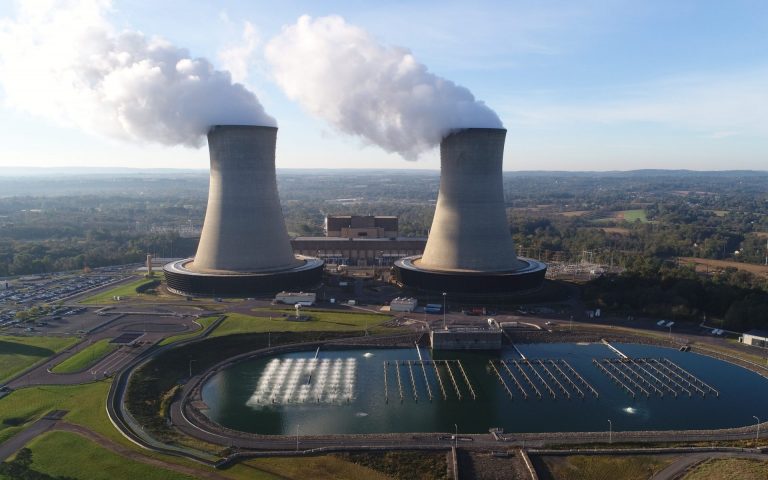
If you live, work, or attend school within a 10-mile radius of the Limerick nuclear power plant, local health officials have a freebie for you — albeit not a sexy one.
Montgomery County’s Office of Public Health will be handing out potassium iodide tablets to those in close proximity to the Limerick Generating Station.
The distribution is part of a statewide emergency preparedness effort — the Limerick site is one of Pennsylvania’s four active nuclear power plants.
General Assembly President calls for halt to nuclear tests
The President of the UN General Assembly, Volkan Bozkir, on Wednesday called for an end to nuclear tests, as ambassadors gathered to commemorate the International Day against Nuclear Tests, observed annually on 29 August.
UN News news.un.org September 8, 2021
Despite recent developments in advancing nuclear disarmament, more remains to be done, said Mr. Bozkir, urging countries which have yet to sign or ratify the Comprehensive Nuclear-Test-Ban Treaty (CTBT) to do so without delay.
Today we mark the International Day against Nuclear Tests, an opportunity to remember the victims of nuclear testing, honor the survivors and examine the legacy impacts of nuclear weapons, including that of nuclear waste. My full remarks here: pic.twitter.com/1onIGt3TJ5
— UN GA President (@UN_PGA) September 8, 2021
“More than 2,000 nuclear tests have been conducted since the advent of nuclear weapons. While the rate of testing has declined, they have not stopped,” he said.
“These tests have long lasting health and environmental consequences. They devastate the communities they impact. They displace families from their homelands.”
Progress on disarmament
Underlining the General Assembly’s commitment to nuclear disarmament, Mr. Bozkir welcomed progress achieved over the past year amid the challenges of the COVID-19 pandemic.
US attorney details illegal acts in construction projects, sealing the fate of the “nuclear renaissance”
“The indictment reveals important new information about how Benjamin and Westinghouse conspired to hide crucial information about reactor completion dates from the owners…It states that the defendant made “false and misleading statements” and “knowingly devised a scheme” to continue the project based on misrepresentations.”
By Tom Clements | thebulletin.org
VC Summer nuclear site in South Carolina, with operating unit 1 in the background and abandoned twin unit Westinghouse AP1000 nuclear reactor construction in the foreground; Tim Mousseau ©2018. Used with permission to the Bulletin of Atomic ScientistsThe ill-fated construction of new nuclear reactors in South Carolina—one of two such troubled Westinghouse reactor construction projects in the United States—was abruptly terminated on July 31, 2017, but the effort to determine legal accountability for the project’s colossal failure is only now hitting its stride.
The South Carolina legislature conducted hearings about the project’s collapse. But it has fallen to the United States Attorney for South Carolina to outline internal decisions that led to project abandonment—via court filings, plea agreements, and indictments. These filings are proving to be the best documentation so far of criminal behavior related to projects that were part of a much-hyped “nuclear renaissance” that began in the early-2000s but has since petered out in the United States.
On August 18, 2021, a second Westinghouse official was charged in a federal grand jury indictment filed with the court in Columbia, South Carolina. The charges outline “the scheme” to cover up key details about the problem-plagued project to construct two 1,100 megawatt (MW) Westinghouse AP1000 light-water reactors at the VC Summer site north of Columbia.
The project was initiated in May 2008 and gained final approval in February 2009.
According to the 18-page indictment, former Senior Vice President of New Plants and Major Projects Jeffrey Benjamin “had first-line responsibility for Westinghouse’s nuclear reactors worldwide.” He was charged, according to a news release, “with sixteen felony counts including conspiracy, wire fraud, securities fraud, and causing a publicly-traded company to keep a false record.” On August 30, the US attorney’s office announced that Benjamin would be arraigned on August 31.
In order for SCANA, parent of utility South Carolina Electric and Gas, to gain a federal production tax credit of $1.4 billion, essential to the financial viability of the project, both units had to be finished by December 31, 2020.
Benjamin and Westinghouse knew that the dates would never be met, but SCANA doggedly stuck with them given production-tax-credit pressure.The indictment reveals important new information about how Benjamin and Westinghouse conspired to hide crucial information about reactor completion dates from the owners, the publicly held utility SCANA, now defunct, and its junior partner, the state-owned South Carolina Public Service Authority (known as Santee Cooper). It states that the defendant made “false and misleading statements” and “knowingly devised a scheme” to continue the project based on misrepresentations via Westinghouse to the owners, state regulators, the Securities and Exchange Commission, investors, and ratepayers. Nervous SCANA officials played along with the inept cover-up efforts and passed on false and inaccurate information to regulators.
Benjamin, the fourth official to be charged, faces 20 years in prison and a $5 million fine. Issuance of the indictment suggests he intends to face trial rather than plead guilty—a risky proposition given the waste of $9 billion on construction of a project that delivered nothing to consumers (and potential jury members) but a series of nine rate hikes. While those hikes were eventually eliminated and further rate hikes were avoided, a small nuclear construction charge in current bills stands as an enduring reminder of the debacle.
On May 21, 2021, Carl Churchman, Westinghouse Electric Corporation vice president and project director, was indicted on the felony charge of making false statements to the FBI about the status of the project. He pleaded guilty on June 10.
In February, Kevin Marsh, former SCANA CEO, also entered a guilty plea in federal court for conspiracy to commit felony fraud. And Stephen Byrne, former SCANA chief operating officer and executive vice president, pleaded guilty in July 2020 to conspiracy to commit mail and wire fraud. Both gave false testimony numerous times to regulators.
The August 18, 2021 news release from the South Carolina US Attorney’s Office made clear that the investigation continues: “`This indictment with its attendant allegations and charges is another step toward justice for all those responsible for the VC Summer nuclear plant fiasco,’ said FBI Special Agent in Charge Susan Ferensic.”The two SCANA officials and Westinghouse’s Churchman are subject to five-year prison sentences and stiff fines but will likely face reduced sentences in exchange for fully cooperating with investigators, something required in their plea agreements.
Both Westinghouse and SCANA were eventually forced into bankruptcy. Westinghouse was acquired by Brookfield Business Partners, and SCANA vanished after an easy takeover by Dominion Energy, approved in December 2018. The fate of the debt-strapped, state-owned partner Santee Cooper rages on in the South Carolina Legislature.
One entity that will likely never be held responsible for the disastrous project that it authorized is the South Carolina Public Service Commission. Members of this body unanimously voted in favor of anything SCANA requested during the entire course of the project and balked at providing oversight as it fell apart. All were replaced by the Legislature at the end of their terms with new members, who have been less accommodating to utility requests.
Public interest intervenors were prescient in their early assessments of the project. Friends of the Earth, which intervened before the Public Service Commission against the project in August 2008, noted SCANA’s disregard for energy efficiency and alternative forms of energy. That organization predicted that the project’s fate would be what the US Attorney’s Office affirmed in the August 18, 2021 indictment: “from the outset, the Project was characterized by cost overruns and significant delays.” Likewise, toward the end of the project in June 2017, just after Westinghouse declared bankruptcy, Friends of the Earth and the Sierra Club filed a formal complaint detailing why the project must be canceled. As money hemorrhaged, the owners made that earth-shaking decision a month later. And the mighty crash still reverberates.
In Georgia, construction of the other AP1000 project, located at Plant Vogtle, stumbles along to massive cost overruns and significant schedule delays. A main difference between the projects: Georgia Power has a large enough customer base to absorb the financial blow of its struggling project. With cost projections for the two Vogtle units nearing a stunning $30 billion, finishing dates presented to the Georgia Public Service Commission remain open to question.
The Carolina and Georgia reactor projects went forward under laws related to “construction work in progress” that allowed financing charges to be billed to the ratepayers from the start of construction, long before the reactors were online. Both the South Carolina law, the Baseload Review Act, and Georgia’s Nuclear Energy Financing Act have been repealed.
The fault for the shocking AP1000 misadventure falls squarely on the shoulders of Westinghouse and the involved utilities. They all fell victim to their own reactor-promotion propaganda but lacked the technical and management competence to pull off the projects as envisaged. With pursuit of large light-water reactors in the United States all but dead, the nuclear industry is now endlessly touting an array of “small modular reactors” and a dizzying menu of so-called “advanced reactors,” all of which exist only on paper. It’s unclear if there’s a path forward for this nuclear renaissance redux, and if there is, whether taxpayers will be put on the hook for financing some of it.
Germany Calls on Iran to Resume Nuclear Talks
Informal negotiations stalled after Iran’s new hardline president was elected in June. Tehran has caused an international outcry in recent months over the broadening scope of its nuclear program.
“US President Joe Biden has signaled his eagerness to resume direct talks, but Iranian officials have yet to do the same.”
The German Foreign Ministry on Wednesday said it “vehemently” urged Iran to restart negotiations aimed at reviving a defunct nuclear deal.
“We are ready to do so, but the time window won’t be open indefinitely,” a ministry spokesman said.
The French foreign ministry made a similar statement later on Wednesday.
In 2015, Iran, the United States, United Kingdom, Germany, France, Russia, China, plus EU representatives, worked out a deal to place curbs on Iran’s nuclear program. The Joint Comprehensive Plan of Action (JCPOA) sought to prevent Iran from making nuclear weapons by restricting the extent to which it could enrich uranium, install nuclear centrifuges, and stockpile radioactive material. In exchange, the other signatories agreed to drop certain sanctions against Tehran.
‘A combination of failures:’ why 3.6m pounds of nuclear waste is buried on a popular California beach
The San Onofre nuclear power plant shut down years ago – but residents and experts worry what will happen with the waste left behind
The defunct San Onofre nuclear power plant near San Clemente, California. Photograph: Lenny Ignelzi/APMore than 2 million visitors flock each year to California’s San Onofre state beach, a dreamy slice of coastline just north of San Diego. The beach is popular with surfers, lies across one of the largest Marine Corps bases in the Unites States and has a 10,000-year-old sacred Native American site nearby. It even landed a shout-out in the Beach Boys’ 1963 classic Surfin’ USA.
But for all the good vibes and stellar sunsets, beneath the surface hides a potential threat: 3.6m lb of nuclear waste from a group of nuclear reactors shut down nearly a decade ago. Decades of political gridlock have left it indefinitely stranded, susceptible to threats including corrosion, earthquakes and sea level rise.
The San Onofre reactors are among dozens across the United States phasing out, but experts say they best represent the uncertain future of nuclear energy.
“It’s a combination of failures, really,” said Gregory Jaczko, who chaired the US Nuclear Regulatory Commission (NRC), the top federal enforcer, between 2009 and 2012, of the situation at San Onofre.
‘Star Wars’ no longer fiction
ABQ at center of research for tomorrow’s weapons
“Albuquerque, New Mexico, is the epicenter of directed energy research in the United States…If the arms race for directed energy indeed takes off, much of the action could take place in Albuquerque.”
BY RYAN BOETEL / JOURNAL STAFF WRITER Copyright © 2021 Albuquerque Journal August 20, 2021 abqjournal.com
Force fields protecting us from drones and missiles.
Guns that shoot lasers instead of firing bullets.
Rock ’em Sock ’em Robots zapping at each other on the battlefield.
A new report by the Air Force Research Laboratory titled Directed Energy Futures 2060 describes the sorts of “directed energy” weapons that may come to exist in the next 40 years. And the expected technology – much of which may be researched and developed in Albuquerque – is like something out of a science fiction movie.
Officials from multiple Department of Defense entities, partners with the North Atlantic Treaty Organization and other experts came together to write the report, which says the world is at a “tipping point.”
MOX failed. But plutonium pit production is different, argues NNSA exec.
“Even with a potential surge in production at Los Alamos, there remains uncertainty about that capability, especially with their history of outages,” U.S. Rep. Joe Wilson
By Colin Demarest cdemarest@aikenstandard.com postandcourier.com August 21, 2021
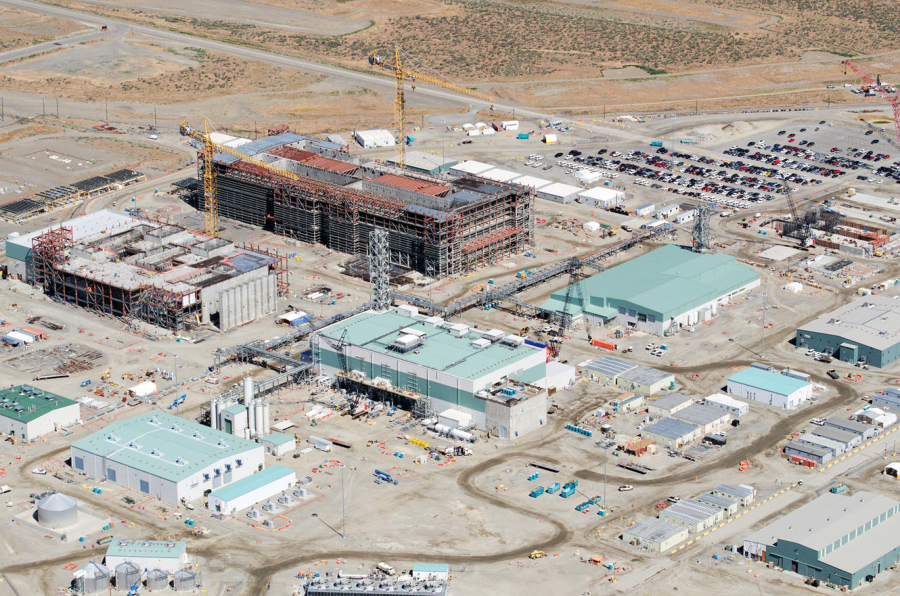
ALEXANDRIA, Va. — In late 2018, a behemoth fuel facility at the Savannah River Site was axed. Its cancellation, enabled by a court ruling and promises of saving billions of dollars, marooned more than a decade of work and vexed a clutch of South Carolina politicians.
What remained was a shell: a Mixed Oxide Fuel Fabrication Facility that was partially built and would eventually be secured and preserved, like an insect suspended in amber.
In the years that followed, the federal government began seriously pursuing a nuclear weapons mission – the crafting of warhead components known as plutonium pits — using the MOX skeleton as a springboard. That effort continues today, and at a clip some have likened to the Cold War or the Manhattan Project, the odyssey that birthed the nuclear age.
But where MOX failed, the Palmetto State pit factory will not, according Michael Thompson, a National Nuclear Security Administration executive. While bilateral friction and “higher-level policy choices” hamstrung the reactor fuel project, it’s a different matter when it comes to the plutonium cores and the Savannah River Plutonium Processing Facility, Thompson argued earlier this month.
Continue reading
We could all learn a lesson on disarmament from Archbishop Hunthausen
By Leonard Eiger nrconline.com
“I am grateful for having been invited to speak to you on disarmament because it forces me to a kind of personal disarmament. This is a subject I have thought about and prayed over for many years. I can recall vividly hearing the news of the atomic bombing of Hiroshima in 1945. I was deeply shocked. I could not then put into words the shock I felt from the news that a city of hundreds of thousands of people had been devastated by a single bomb. Hiroshima challenged my faith as a Christian in a way I am only now beginning to understand. That awful event and its successor at Nagasaki sank into my soul, as they have in fact sunk into the souls of all of us, whether we recognize it or not.”
Those are the opening lines of the “Faith and Disarmament” speech Seattle Archbishop Raymond Hunthausen delivered on June 12, 1981. Hunthausen had become active in resistance to the U.S. stockpiling of nuclear weapons and the new Trident submarine-based nuclear weapons system, which included the Bangor Trident submarine base in Puget Sound just 20 miles west of Seattle.
In that 1981 speech, Hunthausen referred to the Trident submarines based there as “the Auschwitz of Puget Sound.” In context, it was both a profound and prophetic statement of fact.
As Hunthausen said, “Trident is the Auschwitz of Puget Sound because of the massive cooperation required in our area — the enormous sinful complicity that is necessary — for the eventual incineration of millions of our brother and sister human beings.”
Nuclear News Archives – 2020
Nuclear Watch New Mexico’s Critique of Some NNSA Answers to Questions on LANL’s Planned Tritium Releases
November 4, 2020
The Los Alamos National Laboratory (LANL) proposes to vent up to 114,000 curies of radioactive tritium gas to the open atmosphere while claiming that it poses no public health and safety risks. Public outcry and congressional pressure prompted the National Nuclear Security Administration (NNSA) to host a public information virtual meeting on this issue on October 20. Due to the overwhelming turnout of some 150 interested citizens and ear-splitting technical difficulties NNSA is holding another public virtual meeting at 5:00 pm Thursday November 5.
Interested citizens can join the discussion at https://www.lanl.gov/environment/flanged-tritiumwaste-containers.shtml
If you wish to speak or ask questions you should pre-register at the same site.
Nuclear Watch New Mexico Comments on U.S. Nuclear Regulatory Commission’s Interim Storage Partners/Waste Control Specialists Consolidated Interim Storage Facility Draft Environmental Impact Statement
RE: Docket ID NRC-2016-0231/Report Number NUREG-2239, the U.S. Nuclear Regulatory Commission’s Interim Storage Partners/Waste Control Specialists Consolidated Interim Storage Facility Draft Environmental Impact Statement
Dear U.S. Nuclear Regulatory Commission (NRC) Commissioners and Staff,
We respectfully submit these comments in response to the Draft Environmental Impact Statement (Docket ID NRC-2016-0231) regarding Interim Storage Partner’s (ISP) application for a license to build and operate a “Consolidated Interim Storage Facility for Spent Nuclear Fuel in Andrews County, Texas” (NUREG-2239), which plans to bring at least 40,000 metric tons of spent fuel, high-level radioactive waste, from nuclear reactors around the country to west Texas. Please know that we do not consent to our region becoming a national radioactive high-level waste dumping ground or to transporting up to thousands of canisters of radioactive waste through thousands of communities. We should not have to risk the contamination of our land, aquifers, air, plants, wildlife, and livestock. We do not consent to endangering present and future generations.
Read/Download full comments HERE
Release Of Radioactive Tritium A Bad Idea
 BY DR. VIRGINIA NECOCHEA & CHARLES DE SAILLAN
BY DR. VIRGINIA NECOCHEA & CHARLES DE SAILLAN
Tritium is a radioactive isotope of hydrogen. It emits beta radiation, which can be very dangerous if inhaled. Like other forms of ionizing radiation, tritium can cause cancer, genetic mutations and birth defects, and assorted other adverse health effects.
So it is not surprising that many people were dismayed when they learned that the U.S. Department of Energy (DOE) and its contractor at Los Alamos National Laboratory plan to release 114,000 curies of tritium gas into the atmosphere at Technical Area 54 and, possibly, at Technical Area 16. DOE has been storing this waste tritium in four steel canisters at TA-54 at the Laboratory for more than a decade. Over time, pressure has built up in the canisters, which DOE plans to relieve by venting the tritium gas into the atmosphere.
DOE Issues Controversial Decision to Pursue a Plutonium Bomb Plant (PBP) at Savannah River Site (SRS); Inadequate Environmental Review and Lack of Justification for Production of 50 or More “Pits” per Year to Modernize Entire Nuclear Weapons Stockpile Open to Legal Challenge
November 5, 2020
The U.S. Department of Energy (DOE) today issued a formal decision that it will pursue a massive Plutonium Bomb Plant (PBP) at the DOE’s Savannah River Site (SRS) in South Carolina, in order to produce plutonium “pits,” or cores, for nuclear warheads. The provocative decision, which adds fuel to concerns about a new nuclear arms race with Russia and China, drew immediate opposition from public interest groups near DOE sites in South Carolina, New Mexico and California.
The issuance by DOE’s National Nuclear Security Administration (NNSA) of the “Record of Decision” (ROD) on the Environmental Impact Statement (EIS) on pit production at SRS, issued in late September, officially affirms the “preferred alternative” that DOE intends to produce a minimum of 50 plutonium “pits” per year by 2030 at SRS. Also on November 5, NNSA issued an “Amended Record of Decision” (AROD) to its 2008 nation-wide Complex Transformation Programmatic Environmental Impact Statement that incorporated its SRS pit-production decision.
Subcontractor sues WIPP for $32 million in canceled work
Critical Applications’ ventilation project was tied to a radiation leak in 2014 that often is recalled as the “kitty litter” incident.
BY: SCOTT WYLAND | santafenewmexican.com
A subcontractor is suing the company that operates the Waste Isolation Pilot Plant in Southern New Mexico, claiming $32 million for what it says was gross mismanagement of a major construction project at the nuclear waste disposal site.
In a federal lawsuit, Texas-based Critical Applications Alliance LLC, which was hired to build a ventilation system at WIPP, says Nuclear Waste Partnership was such a disorganized project manager that it caused repeated delays and cost overruns, resulting in multiple breaches of contract.
The subcontractor also complains WIPP managers abruptly canceled its $135 million contract in August with no explanation and without paying millions owed.
Political strategist & lobbyist each plead guilty in federal public corruption racketeering conspiracy involving more than $60 million
United States Attorney David M. DeVillers
Southern District of Ohio
FOR IMMEDIATE RELEASE THURSDAY, OCT. 29, 2020
CINCINNATI – A longtime campaign and political strategist for Ohio House Representative Larry Householder and a lobbyist hired by an energy company to funnel money to Householder’s enterprise each pleaded guilty in federal court today.
Jeffrey Longstreth, 44, and Juan Cespedes, 41, of Columbus, each pleaded guilty to participating in a racketeering conspiracy involving more than $60 million paid to a 501(c)(4) entity to pass and uphold a billion-dollar nuclear plant bailout.
U.S. to Launch Minuteman III Missile Test Just Five Days After 50th Country Ratified Treaty on the Prohibition of Nuclear Weapons
“While most of the world’s countries are evolving to a view that nuclear weapons are unacceptable under all circumstances, the U.S. is testing a nuclear missile built to fight the Cold War; one which is designed to cause the indiscriminate slaughter of hundreds of thousands of people.”
By: Sandy Jones | wagingpeace.org
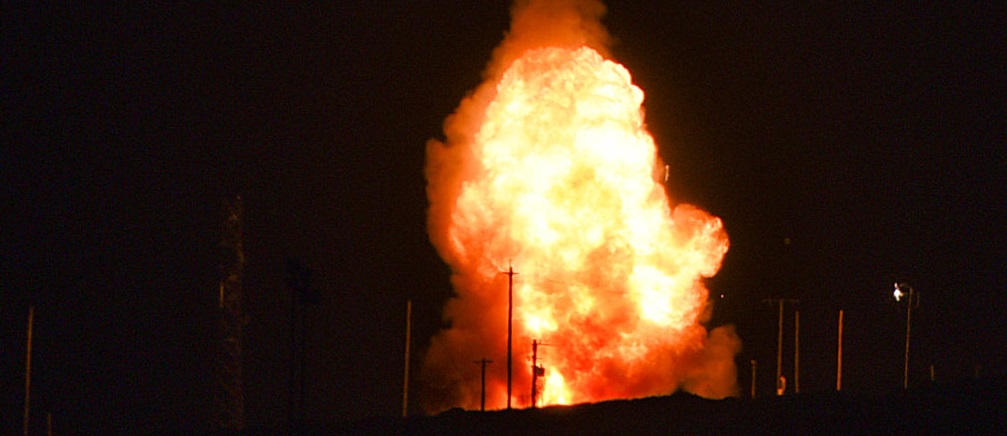
SANTA BARBARA, CA– Early tomorrow morning, between 12:01 a.m. and 6:01 a.m., the United States will launch an unarmed Minuteman III intercontinental ballistic missile from Vandenberg Air Force Base. While the Air Force maintains that missile tests are planned many months in advance, the timing of this test is questionable, at best.
This test will take place just five days after Honduras became the 50th country to ratify the Treaty on the Prohibition of Nuclear Weapons (TPNW). With the 50th ratification, the treaty will enter into force on January 22, 2021. The treaty prohibits the possession, testing, use, or threat of use of nuclear weapons.
Column: Yes, Santa Susana is a ‘landmark’ — as a historic environmental disaster
The Santa Susana Field Laboratory site is “one of the most toxic sites in the United States by any kind of definition,” Jared Blumenfeld, head of the California Environmental Protection Agency, told me. “It demands a full cleanup.”
BY: MICHAEL HILTZIK | latimes.com

One thing is certainly true about NASA’s curious effort to place 2,850 acres above the Simi Valley on the National Register of Historic Places: The parcel is certainly a landmark.
Among the points in dispute is what makes it so.
To several local Native American tribes, including the Santa Ynez Band of Chumash Indians, the Ventura County site’s cave drawings and rock shelters bespeak a cultural heritage dating back centuries.
The time has come for us to make sure that we hold the polluters accountable for their legacy….We will make sure the site gets cleaned up and we will exercise our legal authority in pursuit of that. – CALEPA SECRETARY JARED BLUMENFELD
To environmentalists and the site’s neighbors, it’s historic for the extent of its contamination by chemical and nuclear research performed there during the Cold War.
‘It just goes into a black hole’ The Trump administration is burying dozens of studies detailing the promise of renewable energy, impeding a transition away from fossil fuels
“The disposal of contaminated water at the Fukushima Daiichi plant has been a longstanding problem for Japan as it proceeds with an decades-long decommissioning project. Nearly 1.2 million tonnes of contaminated water are currently stored in huge tanks at the facility.”
BY: Peter Fairley | grist.org This story was produced in collaboration with InvestigateWest, a nonprofit newsroom in Seattle with a focus on the environment, public health, and government accountability
It was a scorching August day at the Hoover Dam as three Trump administration officials gathered for a little celebration honoring pollution-free hydroelectricity. Inside the dam’s Spillway House Visitor Center, air conditioning thankfully kept people comfortable as the president’s appointees heaped praise on hydropower. A U.S. Department of Interior news release about the event calls hydroelectric dams such as Hoover —where the Colorado River slips between Arizona and Nevada — a “unique resource critical to America’s future, which supports the integration of other renewables like wind and solar onto the grid.”
But what went unsaid at the grip-and-grin was that one of those high-ranking officials, Dan Simmons of the U.S. Department of Energy doesn’t appear to fully support renewables. In fact, he has presided over his agency’s systematic squelching of dozens of government studies detailing its promise.
One pivotal research project, for example, quantifies hydropower’s unique potential to enhance solar and wind energy, storing up power in the form of water held back behind dams for moments when the wind isn’t blowing and the sun isn’t shining. By the time of the Hoover Dam ceremony, Simmons’ office at the Energy Department had been sitting on that particular study for more than a year.
A Turning Point in the Struggle Against the Bomb: the Nuclear Ban Treaty Ready to Go Into Effect
“The TPNW arrives at a time when the risks of nuclear war are rising and as the world’s major nuclear armed states are building up their nuclear weapons capabilities. It enters into force at the same time that other key agreements limiting nuclear weapons are being discarded or threatened, and as the major nuclear-armed states are failing to meet their NPT nuclear-disarmament obligations…The entry into force of the TPNW is a much-needed wake-up call that has the potential to stimulate further action on disarmament and take us closer to a world without nuclear weapons.”
BY: Daryl G. Kimball | justsecurity.org
The Treaty on the Prohibition of Nuclear Weapons (TPNW) marks a turning point in the long history of the effort to reduce nuclear risks and to eventually eliminate the 13,000 nuclear weapons that remain today, 90 percent of which are held by the United States and Russia. On Oct. 24, Honduras became the 50th country to ratify the treaty, triggering its entry into force 90 days later, on Jan. 22, 2021.
That date will mark the first time since the invention of the atomic bomb that nuclear weapons development, production, possession, use, threat of use, and stationing of another country’s nuclear weapons on a state party’s national territory are all expressly prohibited in a global treaty. The TPNW’s entry into force will arrive almost exactly 75 years after the United Nations General Assembly’s (UNGA’s) adoption, on Jan. 24, 1946, of its very first resolution, Resolution 1 (I), which was to establish a commission to ensure “the elimination from national armaments of atomic weapons and all other major weapons adaptable to mass destruction.”
Japan rejects nuclear ban treaty; survivors to keep pushing
“Atomic bomb survivors, who have long worked to achieve the treaty, renewed their call for Japan to become a signatory. Terumi Tanaka, a survivor of the Aug. 9, 1945, Nagasaki bombing who has long campaigned for a nuclear weapons ban, said he has not given up hope.”
BY: Mari Yamaguchi The Associated Press | apnews.com
TOKYO – Japan said Monday it will not sign a U.N. treaty that bans nuclear weapons and does not welcome its entry into force next year, rejecting the wishes of atomic bomb survivors in Japan who are urging the government to join and work for a nuclear-free world.
The United Nations confirmed Saturday that 50 countries have ratified the Treaty on the Prohibition of Nuclear Weapons, paving the way for its entry into force in 90 days.
The announcement was hailed by anti-nuclear activists, but the treaty has been strongly opposed by the United States and other major nuclear powers.
Deregulation of Rad Waste Disposal Plows Ahead
Decommissioned Reactors OK-ed for Landfills in Big Gift to Nuclear Industry
By: Jeff Ruch & Kirsten Stade | peer.org
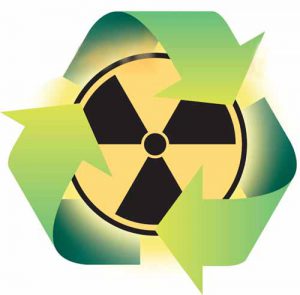 Washington, DC —The Nuclear Regulatory Commission is finalizing a year-long drive to functionally deregulate disposal of massive amounts of radioactive waste. NRC’s plan would allow commercial nuclear reactors to dump virtually all their radioactive waste, except spent fuel, in local garbage landfills, which are designed for household trash not rad-waste, according to comments filed today by Public Employees for Environmental Responsibility (PEER).
Washington, DC —The Nuclear Regulatory Commission is finalizing a year-long drive to functionally deregulate disposal of massive amounts of radioactive waste. NRC’s plan would allow commercial nuclear reactors to dump virtually all their radioactive waste, except spent fuel, in local garbage landfills, which are designed for household trash not rad-waste, according to comments filed today by Public Employees for Environmental Responsibility (PEER).
Today marks the end of public comments for an NRC “interpretative rulemaking” that would, in effect, abrogate longstanding requirements that virtually all such waste must be disposed of in licensed radioactive waste sites meeting detailed safety standards and subject to NRC inspection and enforcement. Instead, NRC would grant generic exemptions for unlicensed waste handlers.
NRC declares its “intent” that these newly exempt disposal sites would be limited to “very low-level radioactive wastes” – a term undefined by statute – which NRC considers to be “below 25 millirem per year.” Yet, NRC’s definition would allow public exposure to the equivalent to more than 900 chest X-rays over a lifetime, create a cancer risk twenty times higher than the Environmental Protection Agency’s acceptable risk range, thousands of times the risk goal for Superfund sites, or enough radiation to cause every 500th person exposed to get cancer.
The Poisonous Legacy of Portsmouth’s Gaseous Diffusion Plant
The plant was erected in Pike County, Ohio during the cold war to enrich uranium. Then people started getting sick. Now, they’re stuck cleaning up the mess.
By: Kevin Williams | beltmag.com
Vina Colley, a slight woman with a bob of thick blond hair, climbs into her white Ford Explorer. Her thirteen-year-old Maltese, Hercules jumps onto her lap, wedging comfortably between her legs and the steering wheel, and stays put as she navigates the steep ridges and plunging hollows of Pike County, Ohio. Colley is seventy-four, and, for nearly forty years, she’s been fighting the Portsmouth Gaseous Diffusion Plant, known locally as “The A-Plant” or PORTS. Her home library holds scores of totes filled with neatly labeled documents, a paper trail that exposes what she sees as Portsmouth’s darkest and most egregious secrets.
Nuclear weapons have always been inhumane and unacceptable, soon they will be illegal – Tilman Ruff
“The radioactive incineration unleashed by nuclear war involving even less than 1% of the global nuclear arsenal targeted on cities in one part of the world would be followed by a worldwide nuclear ice age and nuclear famine, putting billions of people’s lives in jeopardy.”
On Saturday 24 October 2020, Honduras brought the number of nations ratifying the United Nations Treaty on the Prohibition of Nuclear Weapons (‘TPNW’) to 50. This milestone means that after 90 days have elapsed, on 22 January 2021, the treaty will enter into legal force, becoming international law and binding on the states that have ratified it, and all those which ratify in future. The treaty will, however, stigmatise nuclear weapons for all states, whether or not they join the treaty.
It is fitting that 24 October also marked the 75th anniversary of the founding of the UN, ‘determined to save succeeding generations from the scourge of war’. The very first resolution of the UN General Assembly, on 24 January 1946, established a commission to develop a plan for the elimination of atomic weapons.
This is a historic achievement and an enormous win for humanity and planetary health. Outlawing nuclear weapons is an essential step towards eliminating them, which is the only reliable way to prevent their use.
Reports: Japan to Release Fukushima’s Contaminated Water Into Sea
“The disposal of contaminated water at the Fukushima Daiichi plant has been a longstanding problem for Japan as it proceeds with an decades-long decommissioning project. Nearly 1.2 million tonnes of contaminated water are currently stored in huge tanks at the facility.”
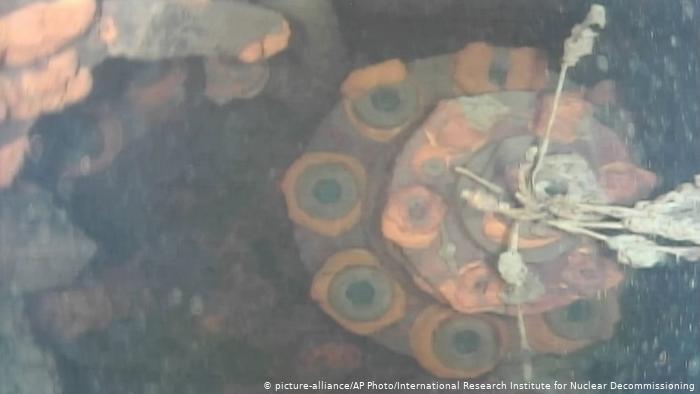
BY: Yuka Obayashi and Kaori Kaneko, Reuters | readersupportednews.com
Nearly a decade after the Fukushima nuclear disaster, Japan’s government has decided to release over one million tonnes of contaminated water into the sea, media reports said on Friday, with a formal announcement expected to be made later this month.
The decision is expected to rankle neighbouring countries like South Korea, which has already stepped up radiation tests of food from Japan, and further devastate the fishing industry in Fukushima that has battled against such a move for years.
Is Change Coming? Smartly Reshaping and Strengthening America’s Nuclear Deterrent
“Adjusting U.S. nuclear weapons plans is notoriously difficult, as nearly every president has experienced. Yet it is urgent to halt and reverse the trend of increasing nuclear capabilities that lower the threshold for nuclear war and increase miscalculation risks.”
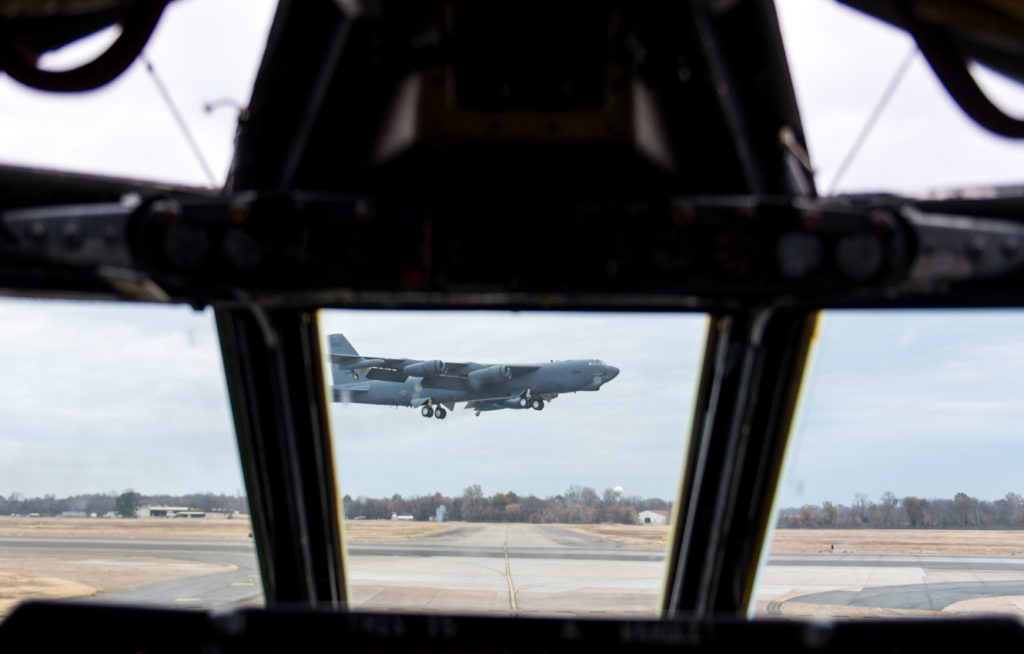
BY: CHRISTINE PARTHEMORE AND ANDY WEBER | warontherocks.com
How might America’s nuclear weapons plans change in the years ahead? Buoyed by the revelation of President Donald Trump describing a potential secret new nuclear weapon system to Bob Woodward, continuing U.S.-Russian dialogue on nuclear weapons, and the upcoming November elections, experts are speculating about what the next four years may mean for U.S. nuclear policy.
Former Vice President Joe Biden has indicated that, if elected, he would seek a posture aligned with his stated belief “that the sole purpose of the U.S. nuclear arsenal should be deterring — and, if necessary retaliating against — a nuclear attack.” This would be a pivot from Trump’s 2018 Nuclear Posture Review, which elevated the role of nuclear weapons in U.S. defense planning by, among other things, describing America’s nuclear forces as a hedge against large-scale conventional attacks and strategic cyber attacks. The declaratory shift — along with elevation of so-called low-yield nuclear options that are considered more usable, and support for more dual conventional and nuclear systems that could be indistinguishable in the absence of verification measures — increased concern that the Trump administration viewed nuclear weapons as acceptable for warfighting, not just deterrence.
Trump Thought He Had a Nuclear Deal With Putin. Not So Fast, Russia Said.
Trump administration officials want to broaden the New START accord and warn that the price of a new deal will rise after the election. Joe Biden supports a straight five-year extension of the deal.
BY: David E. Sanger and Andrew E. Kramer | nytimes.com
President Trump had a pre-election plan to show he had gotten something out of his mysteriously friendly relationship with President Vladimir V. Putin of Russia.
In the weeks before the election, the two men would announce that they had reached an agreement in principle to extend New START, the last remaining major arms control agreement between the two countries. It expires on Feb. 5, two weeks after the next presidential inauguration.
Mr. Trump has long refused to sign off on a clean five-year extension of the agreement, a step both leaders could take without Senate approval. He has described the Obama-era treaty as deeply flawed — the same thing he said about the North American Free Trade Agreement and the Iran nuclear accord — because it did not cover all of Russia’s nuclear arms, or any of China’s.
The Biggest Radioactive Spill in US History Never Ended
How the US poisoned Navajo Nation.
BY: Ranjani Chakraborty and Melissa Hirsch | vox.com
For decades, Navajo Nation was a primary source for the United States’ uranium stockpile during the nuclear arms race. It was home to more than 700 uranium mines, which provided jobs to Navajo residents. But the mining industry came with impending peril. Cases of lung cancer and other diseases began cropping up in a community that had previously had few of them. Land, air, and water was poisoned. And on July 16, 1979, the mining led to the biggest radioactive spill in US history.
Scoping Comments on the LLNL SWEIS
October 21, 2020
Ms. Fana Gebeyehu-Houston
NEPA Document Manager
National Nuclear Security Administration
Lawrence Livermore National Laboratory
P.O. Box 808, L-293, Livermore, CA 94551-0808
By Email to:LLNLSWEIS@nnsa.doe.gov
Re: Scoping Comments on the LLNL SWEIS
Dear NEPA Document Manager:
I appreciate this opportunity to submit comments on the scope of the National Nuclear Security Administration’s (NNSA) Site-Wide Environmental Impact Statement (SWEIS) for the continued operation of the Lawrence Livermore National Laboratory (LLNL) Main Site in Livermore, CA and Site 300 high explosives testing range near Tracy, CA.
Nuclear Watch New Mexico is a nonprofit watchdog organization based in Santa Fe, New Mexico. We seek to promote safety and environmental protection at nuclear facilities; mission diversification away from nuclear weapons programs; greater accountability and cleanup in the nation-wide nuclear weapons complex; and consistent U.S. leadership toward a world free of nuclear weapons.
Pursuant to the National Environmental Policy Act the purpose of scoping is: “early identification of concerns, potential impacts, relevant effects of past actions and possible alternative actions.” Therefore, I ask that the analyses I am requesting be fully undertaken – and my questions fully answered – in the draft SWEIS.
First, I am skeptical of the timing of the initiation of this new SWEIS for LLNL during the COVID-19 pandemic and just before the November 3 election. As a prerequisite, the
National Nuclear Security Administration (NNSA) should have already begun a nationwide programmatic environmental impact statement (PEIS) on expanded plutonium pit
production which would then inform the LLNL SWEIS of the Livermore Lab’s role in that national effort, which is not insignificant. Following that pit production PEIS, both a
LLNL and Los Alamos National Laboratory SWEIS should proceed in parallel. It is particularly striking that NNSA is claiming NEPA compliance while relying on an
outdated Complex Transformation Supplemental PEIS and LANL SWEIS, both completed in 2008, and refusing to prepare new or supplemental ones.
How Kodak Exposed The Atomic Bomb
Simulation of a Nuclear Blast in a Major City
WIPP gets millions in COVID-19 relief funding, operations contract extended for one year
“Are WIPP workers getting infected at the site and taking it back into the communities?” Don Hancock said. “WIPP is clearly not always a safe place, but we don’t know if WIPP is a place where workers get infected or if infected workers brought it to WIPP.”
BY: ADRIANE HEDDEN | currentargus.com
In August and September, the Waste Isolation Pilot Plant received about $3.8 million per month of federal COVID-19 funding as the U.S. Department of Energy elected to renew the facility’s primary contractor for one year despite an option to keep Nuclear Waste Partnership (NWP) at the helm of the nuclear waste repository until 2022.
NWP spokesman Donavan Mager said the site received $3.816 million in August and $3.803 in September and that the funding was designated to “support operations” although he did not elaborate on how, specifically, the public money was to be spent.
Per the latest reports from WIPP, 39 workers had contracted COVID-19 as the pandemic appeared to pose a resurgence in New Mexico in recent weeks.
Delegates Want Open Meeting on Release of Radioactive Vapors at LANL
The public will get a chance to comment and learn more about Los Alamos National Laboratory’s plans to release radioactive vapors into the atmosphere from several barrels of tritium-tainted waste.
BY: SCOTT WYLAND | santafenewmexican.com
The federal agency that oversees the lab scheduled the meeting for Oct. 20 after three New Mexico delegates — U.S. Sens. Tom Udall and Martin Heinrich and U.S. Rep. Ben Ray Luján — wrote a letter calling for more transparency and public participation.
An open forum on the release of vapors from Cold War waste is especially important for Pueblo people and others who live near the site, the delegates said in the letter to the National Nuclear Security Administration.
“We strongly believe that protecting public health and safety must always be the highest priority at Los Alamos,” they wrote in the Oct. 1 letter. “Safety is particularly important when there is a possibility of a release to the environment involving radioactive or hazardous materials.”
The agency has said ventilating the containers is necessary to relieve built-up radioactive hydrogen in their headspace, so they can be safely handled and shipped to a commercial storage site.
Continue reading
Indigenous Peoples’ Day 2020




Today, on Indigenous People’s Day 2020, we join our friends and speakers from indigenous rights and environmental groups from throughout the US in condemning nuclear colonialism. From uranium mining, milling, and processing, to atomic power and nuclear weapons, to radioactive waste – the resulting environmental injustices have disproportionately impacted Native Americans & other indigenous peoples.
 Sarah Fields, Uranium Watch and Sierra Club Nuclear-Free CampaignLas Vegas, NV — Indigenous rights and environmental advocates from throughout the US condemned nuclear colonialism on what is recognized as “Columbus Day” Tuesday, October 11, 2016. Native Community Action Council held a press conference in front of the Thomas and Mac Moot Court at the Boyd Law School on the campus of UNLV for participants in the Native American Forum on Nuclear Issues at UNLV.
Sarah Fields, Uranium Watch and Sierra Club Nuclear-Free CampaignLas Vegas, NV — Indigenous rights and environmental advocates from throughout the US condemned nuclear colonialism on what is recognized as “Columbus Day” Tuesday, October 11, 2016. Native Community Action Council held a press conference in front of the Thomas and Mac Moot Court at the Boyd Law School on the campus of UNLV for participants in the Native American Forum on Nuclear Issues at UNLV.
LANL’s Waste Storage Poses Dangers, Report Says
Defense Nuclear Facilities Safety Board (DNFSB) Report demonstrates beyond doubt that a FULL programmatic environmental impact statement on expanded plutonium pit production is needed, as well as new site-wide EIS for the Los Alamos Lab.
The 760 rem estimate is equal to 380,000 chest X-rays, said Dan Hirsch, retired director of programs on environment and nuclear policy at the University of California, Santa Cruz. “This is vastly above what’s permissible for workers’ exposure,” Hirsch said, adding that far lower doses can cause cancer.
BY: SCOTT WYLAND | santafenewmexican.com
Los Alamos National Laboratory is storing hundreds, maybe thousands, of barrels of radioactive waste mixed with incompatible chemicals that have the potential to cause an explosion , putting workers and the public at risk, a government watchdog said in a report.
LANL personnel have failed to analyze chemicals present in hundreds of containers of transuranic nuclear waste, making it possible for an incompatible chemical to be mixed in and cause a container to burst, the Defense Nuclear Facilities Safety Board said in a September report.
Such an explosion would release radiation in doses lethal to workers and hazardous to the public, the safety board said. And yet the radiation levels that would be released have not been sufficiently estimated, it said.
Some of LANL’s facilities store radioactive waste without any engineered controls or safeguards beyond the containers, the board wrote in a cover letter addressed to the U.S. Department of Energy.
25-Year Study of Nuclear vs Renewables Says One Is Clearly Better at Cutting Emissions
Nuclear power is often promoted as one of the best ways to reduce our reliance on fossil fuels to generate the electricity we need, but new research suggests that going all-in on renewables such as wind and solar might be a better approach to seriously reducing the levels of carbon dioxide in the atmosphere.
BY: DAVID NIELD| sciencealert.com
Based on an analysis of 123 countries over a quarter of a century, the adoption of nuclear power did not achieve the significant reduction in national carbon emissions that renewables did – and in some developing nations, nuclear programmes actually pushed carbon emissions higher.
The study also finds that nuclear power and renewable power don’t mix well when they’re tried together: they tend to crowd each other out, locking in energy infrastructure that’s specific to their mode of power production.
Given nuclear isn’t exactly zero carbon, it risks setting nations on a path of relatively higher emissions than if they went straight to renewables.
Virtual Public Information Session on FTWC venting at Los Alamos National Laboratory – 5 p.m. on Tuesday, Oct. 20
The public information session will be hosted via Webex; people who wish to attend can join by following this link (meeting password GckhzZ5nv33), or call in by phone at 415-527-5035, access code 199 995 9074 if people do not have internet access.
Media Advisory
CONTACT: Peter Hyde, pahyde@lanl.gov
LOS ALAMOS, N.M., Oct. 8, 2020—The National Nuclear Security Administration is hosting a virtual public information session at 5 p.m. on Tuesday, Oct. 20, to inform the public about the process of venting Flanged Tritium Waste Containers (FTWCs) that are located at Los Alamos National Laboratory.
Flanged Tritium Waste Containers are pressure vessels specifically designed to contain waste metal that has been exposed to tritium. As the tritium ages and separates into helium and hydrogen, those gases can create pressure inside the container. This is expected and accounted for in the design.
To reduce the amount of waste stored on site, Los Alamos National Laboratory will ship the containers off-site to a licensed storage facility. In order to ship the containers, the pressurized gases inside the containers must be vented to meet regulatory requirements of the U.S. Department of Transportation (DOT).
Citizens’ Hearing Held at New Mexico Capitol about Increased Plutonium Pit Production at LANL
The Department of Energy (DOE) has approved its plans to increase plutonium pit production at Los Alamos National Laboratory (LANL) by 50 percent as a way to comply with what is described in the 2018 Nuclear Posture Review as a need for “an effective, responsive, and resilient nuclear weapons infrastructure” that can “adapt flexibly to shifting requirements.”
The Pentagon has stated it needs annual production of 80 plutonium pits, the triggers for nuclear weapons. The DOE has approved its Supplement Analyses for four possible ways to execute this upgrade.
Continue reading
NASA’s clean-up plan for tainted Santa Susana Field Lab near Simi outrages activists
“NASA’s absurd excuse for cleaning up so much less contamination than it promised is that it has discovered there is much more contamination at the site than it had previously realized,” — cleanup activist Dan Hirsch, president of the Committee to Bridge the Gap
BY: Mike Harris | Ventura County Star vcstar.com
NASA has decided to clean up contaminated soil at its portion of the Santa Susana Field Laboratory site to a less stringent standard than it agreed to in a 2010 legally binding agreement with the state.
The federal agency announced its decision last week, outraging cleanup activists and some local officials.
The activists say NASA’s planned cleanup, outlined in a formal Record of Decision, would leave 84% of its contaminated acres not remediated at the site outside Simi Valley.
That would violate a 2010 legally binding agreement — formally called an Administrative Order on Consent — NASA signed with the California Department of Toxic Substances Control to clean up its acres “to background,” the most exacting standard.
WIPP Resumes Nuclear Waste Shipments from California National Laboratory
Nuclear waste shipments to the Waste Isolation Pilot Plant near Carlsbad from Lawrence Livermore National Laboratory (LLNL) near San Francisco, California resumed this month after a 10-year pause.
BY: ADRIANE HEDDEN | currentargus.com
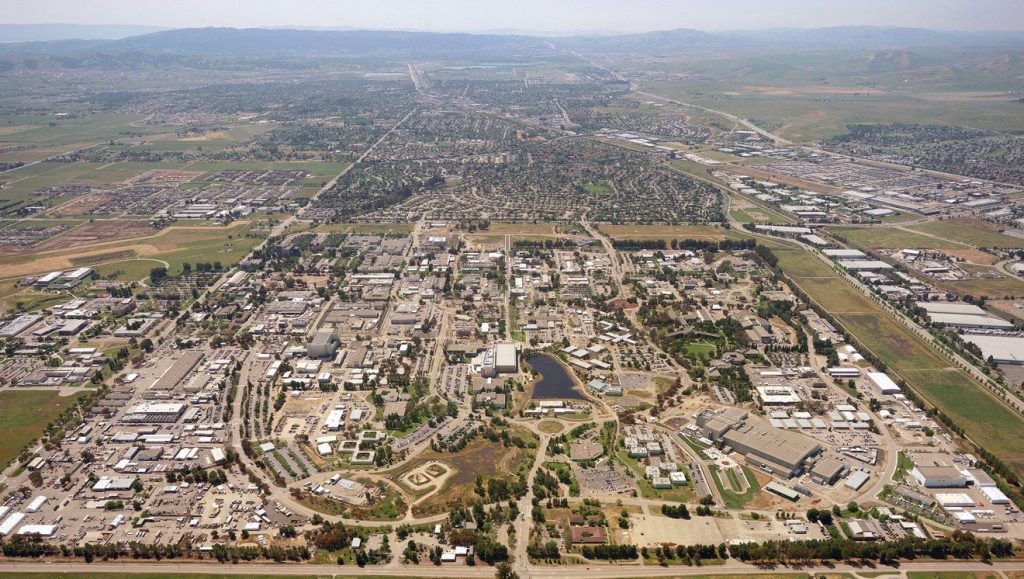
The waste was received at WIPP and will be permanently disposed of in the underground repository about 2,000 feet beneath the surface.
The resumption of shipments from LLNL was the result of a multi-year project and collaboration between the Department of Energy’s Carlsbad Field Office (CBFO), WIPP contractor Nuclear Waste Partnership, National Nuclear Security Administration (NNSA) and the NNSA’s Livermore Field Office, read a DOE news release.
LLNL is primarily a research laboratory that generates transuranic (TRU) waste during its research and engineering operations related to nuclear weapons, plutonium and other technological aspects of the DOE’s nuclear complex.
Texas Gov. Greg Abbott joins opposition to nuclear waste project in New Mexico
“The proposed sites in Texas and New Mexico do not provide the deep geologic isolation required for permanent storage in order to minimize the risks of accidents, terrorism or sabotage which could disrupt the country’s energy supply with catastrophic effects on the American economy,” Abbott wrote to the president.
BY: ADRIANE HEDDEN | currentargus.com
Republican Texas Gov. Greg Abbott was the latest public official to oppose a proposed nuclear storage facility to be built near Carlsbad and Hobbs, along with another in West Texas.
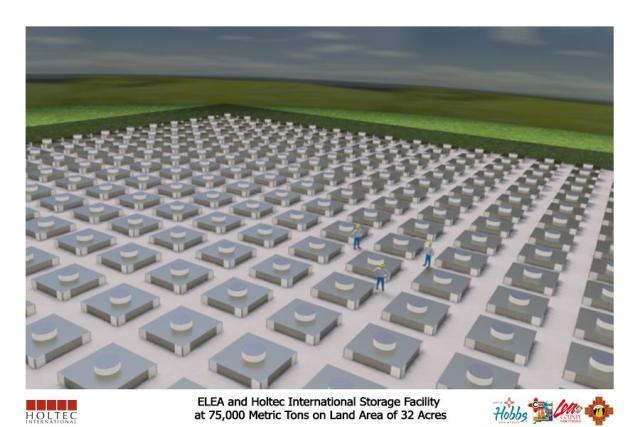
In a Sept. 30 letter to President Donald Trump, Abbott wrote that he worried locating high-level nuclear waste facilities in the Permian Basin region could put the U.S.’s most active oil and gas field at risk.
Holtec International proposed building a consolidated interims storage facility (CISF) to hold spent nuclear fuel rods temporarily in southeast New Mexico while a permanent repository — as required by federal law — was developed.
Activists Decry Feds’ Plans to Ramp Up Nuclear Work at LANL
The federal government should not turn Los Alamos National Laboratory into a hub for making nuclear bomb cores and instead should spend the money to assist the state with education, health care, poverty and climate change impacts, a group of activists and concerned residents said Wednesday at the state Capitol.
BY: SCOTT WYLAND | santafenewmexican.com
The nonprofit Los Alamos Study Group, which supports nuclear disarmament, set up a sound system outside the deserted Roundhouse so critics could express their ire about plans for LANL to produce 30 warhead triggers a year by 2026 without a sitewide environmental study.
The comments, recorded as if the event were a public hearing, will be sent to New Mexico’s congressional delegates, including Sens. Martin Heinrich and Tom Udall, who support LANL reviving and expanding plutonium pit production, saying it will boost the regional economy and strengthen national security.
World’s Biggest Wind and Solar Producer Now Worth More than ExxonMobil
“The shift is as significant as the one the world has seen in the auto industry, with electric vehicle maker Tesla overtaking the biggest car companies in the world in the last year, to the point where it is now valued at more than the next five biggest global car makers combined, despite producing just a fraction of the number of cars.”
BY: GILES PARKINSON | reneweconomy.com
In yet another sign of the pace of the global energy transition – and the massive switch taking place in the investment community – the market value of company that describes itself as the world’s biggest producer of wind and solar power, US utility NextEra, has overtaken that of what used to be the world’s most valuable company, oil major ExxonMobil.
The flip occurred last last week, when NextEra overtook ExxonMobil to become the largest energy company in the US by market value. As Forbes reported, an investment in NextEra a decade ago would have delivered to return of 600 per cent, while an investment in ExxonMobil would have returned minus 25 per cent.
Nuclear Disarmament tops UN agenda
3 Oct 2020 – The United Nations General Assembly holds a high-level meeting to commemorate the International Day for the Total Elimination of Nuclear Weapons. Because of the COVID-19 pandemic, many leaders speak by pre-recorded video to call for a nuclear-weapon-free world.
U.N. Nuclear Ban Treaty Likely to Enter Into Force Early Next Year
“The only way to completely eliminate nuclear risk is to completely eliminate nuclear weapons” and that the nuclear ban treaty “remains the cornerstone of the nuclear disarmament and nonproliferation regime,” Guterres said at a meeting of the General Assembly on Friday.
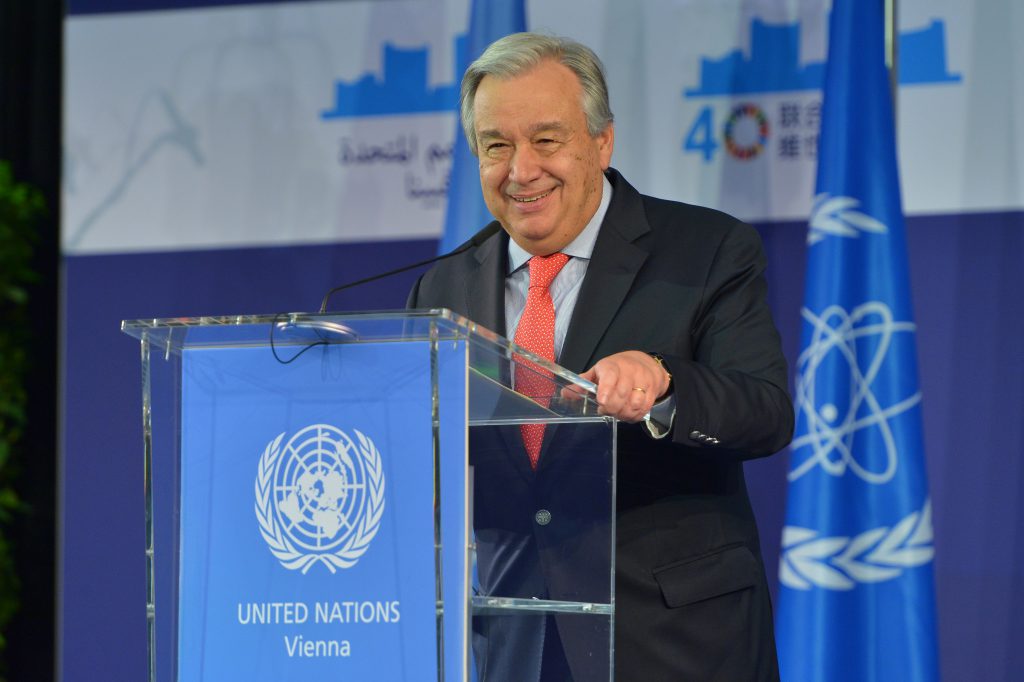
NEW YORK/UNITED NATIONS – A U.N.-adopted nuclear ban treaty is likely to enter into force early next year as the number of signatories is anticipated to reach the needed threshold of 50 soon, possibly later this month, a diplomatic source said Friday.
According to the source and the International Campaign to Abolish Nuclear Weapons (ICAN), 46 countries and regions have completed ratification procedures.
The Treaty on the Prohibition of Nuclear Weapons, adopted in 2017, will enter into force 90 days after it has been ratified by at least 50 countries and regions.
At least four additional countries have already notified the United Nations of their intention to ratify the treaty, the source and the nonprofit organization said, without revealing the names of any such signatories.
Nuclear Ban Pact Should Not Erode Validity of NPT: Confab Chief
Noting that the current international security environment “is not very positive,” [Gustavo Zlauvinen, President-designate of the 2020 Review Conference for the Nuclear Nonproliferation Treaty (NPT)] said a lack of progress on nuclear disarmament will likely “play a big role, unfortunately” at the forthcoming NPT review conference.
By: KYODO NEWS | kyodonews.com
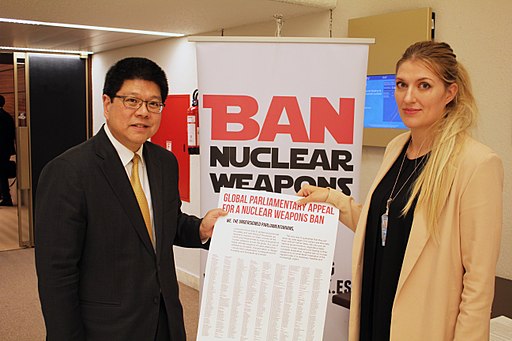
Questioning the effectiveness of a U.N.-adopted nuclear ban treaty, which involves no nuclear powers, the president-designate of an upcoming nonproliferation conference has stressed that the pact should not be allowed to undermine the legitimacy of the Nuclear Non-Proliferation Treaty.
“You can’t have nuclear disarmament without the nuclear weapon states in that system. And that’s why, for the time being, the only treaty that has been accepted by at least five nuclear weapon states, that includes obligations on nuclear disarmament, is the NPT,” Gustavo Zlauvinen said in a recent exclusive interview with Kyodo News.
There is a “huge difference” between the NPT and the pact, Zlauvinen said, adding that it is necessary to make distinctions between the two treaties and “try not to erode the validity and the legitimacy of the NPT.”
He also noted that some members of the NPT are opposed to any reference to the nuclear ban pact at the review conference to be convened early next year and indicated that a wide gap between nuclear power states and those pushing for the nuclear ban treaty could be an “issue of contention” at the NPT gathering.
State Public Land Commissioner Speaks Out Against Nuclear Waste Facility
SANTA FE, N.M. (KRQE) – The state Public Lands Commissioner is speaking out against a proposed nuclear waste storage facility in Lea County. In comments submitted to the National Regulatory Commission, Commissioner Stephanie Garcia Richard says that Holtec International ignored concerns about storing nuclear waste in a highly active oil field.
BY: KRQE Staff | krqe.com
Read Garcia Richard’s full comment and submission to U.S. Nuclear Regulatory Commission
Commissioner Garcia Richard’s released the following statement in a news release Monday regarding the public comment:
I remain vehemently opposed to this proposal for reasons stated since I took office in January 2019. Holtec has misrepresented themselves and this project through every step of the process, including recently raising the intended number of nuclear canisters from 500 to 10,000. They have misrepresented their purported control of the site while also lying about their ability to restrict oil and gas operations in the area.
Holtec has ignored numerous safety concerns regarding the transportation of high-level nuclear waste through New Mexico communities, as well as failing to address questions about storing such waste in the middle of a highly active oil field. As Commissioner of Public Lands, I have a constitutional obligation to protect state trust land for future generations. This project comes with far too much risk and little to no reward.
Activists Push Congress to Revive Probe Into Links Between Nuclear Plants and Cancer
“Nuclear Regulatory Commission killed study in 2015 after spending five years and $1.5 million on the effort”
BY: TERI SFORZA | ocregister.com
Scientists and activists were stunned back in 2015 when the Nuclear Regulatory Commission pulled the plug on what was designed to be the best study of cancer near nuclear power plants ever done.
The pilot study’s price tag was $8 million — a pittance in the NRC’s $1 billion budget — and five years of work had already gone into it. But it was killed because officials were convinced it would be too costly and couldn’t link reactors to disease, a Southern California News Group investigation found.
Last week, a petition with some 1,200 signatures demanding that the study resume went to members of Congress representing Southern and Central California.
Texas Governor Urges Trump To Oppose Nuclear Waste Plans
“It’s an unusual thing for environmentalists and oil companies to be on the same page, and we are on this issue,” says an Austin-based environmental advocate.
BY: Travis Bubenik, Courthouse News; | texasstandard.com

A view of an existing site in West Texas where a company wants to store highly radioactive waste from the nation’s nuclear power plants, one of two such proposals the Texas governor now says he opposes.
From Courthouse News Service:
Texas Governor Greg Abbott has come out against two rival plans to ship highly radioactive waste from the nation’s nuclear power plants to sites on the Texas-New Mexico border, saying either plan would be unsafe and would threaten the region’s sprawling Permian Basin oilfield.
“A stable oil and gas industry is essential to the economy, and crucial to the security of our great nation,” Abbott, a Republican, wrote in a letter to President Donald Trump on Wednesday. “Allowing the interim storage of spent nuclear fuel and high-level nuclear waste at sites near the largest producing oilfield in the world will compromise the safety of the region.”
The nuclear waste plans have for years drawn the ire of advocacy groups who worry about a range of possible environmental and safety threats, but oil and gas interests have become increasingly involved in the fight as well.
A coalition of oil companies and West Texas landowners called Protect the Basin was launched in 2018 to oppose the plans and has more recently stepped up its outreach. One of the coalition members, a ranching and oil company tied to one of the nation’s richest families, has been involved in fighting the issue all the way up to the D.C. Circuit.
Two’s a crowd: Nuclear and renewables don’t mix
“If countries want to lower emissions as substantially, rapidly and cost-effectively as possible, they should prioritize support for renewables, rather than nuclear power.”
BY: University of Sussex | techxplore.com
That’s the finding of new analysis of 123 countries over 25 years by the University of Sussex Business School and the ISM International School of Management which reveals that nuclear energy programs around the world tend not to deliver sufficient carbon emission reductions and so should not be considered an effective low carbon energy source.
Researchers found that unlike renewables, countries around the world with larger scale national nuclear attachments do not tend to show significantly lower carbon emissions—and in poorer countries nuclear programs actually tend to associate with relatively higher emissions.
U.S., Russia Move Toward Outline of Nuclear Deal, Administration Says
“Trump administration official’s comments suggest the two sides might be able to come to terms on broad principles”
BY: MICHAEL R. GORDON | wsj.com
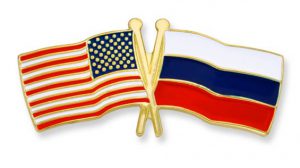 U.S. and Russian negotiators made progress Monday on a new framework accord that would freeze each side’s nuclear arsenal and outline the parameters for a detailed treaty that would be negotiated next year, a senior Trump administration official said.
U.S. and Russian negotiators made progress Monday on a new framework accord that would freeze each side’s nuclear arsenal and outline the parameters for a detailed treaty that would be negotiated next year, a senior Trump administration official said.
The accord, if it comes together in the coming month, would give each side something it has sought. President Trump would have a demonstration that his diplomacy toward Moscow has borne fruit, arriving before the November election. Russia would get an extension of the New START…
The Day Nuclear War Almost Broke Out
“In the nearly sixty years since the Cuban missile crisis, the story of near-catastrophe has only grown more complicated. What lessons can we draw from such a close call?”
“…what almost no one knew until four decades later—was that one of B-59’s torpedoes was carrying what the Soviets called “special ammunition.” The “special” part was a fifteen-kiloton nuclear warhead. Had Savitsky’s orders been carried out, chances are good that the Americans would have responded in kind, and a full-scale nuclear war would have broken out. There should, it seems, be a useful lesson to be learned from that frantic afternoon. But what, in God’s name, is it?”
BY: ELIZABETH KOLBERT | newyorker.com
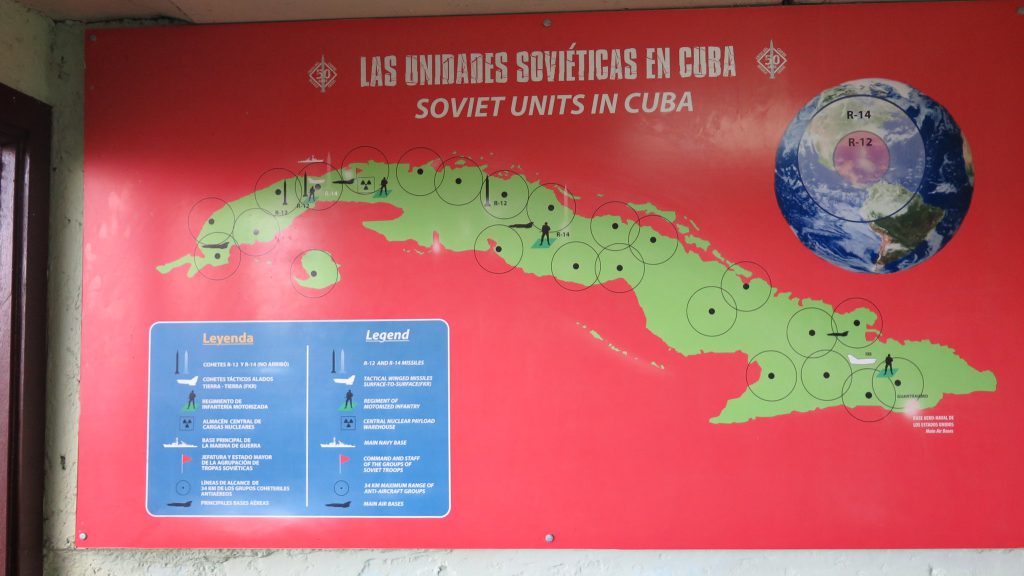
On October 27, 1962, a day that’s been described as the “most dangerous” in human history, a Soviet submarine designated B-59 was churning through the Sargasso Sea when suddenly it was rocked by a series of explosions. “It felt like you were sitting in a metal barrel, which somebody is constantly blasting with a sledgehammer,” Vadim Orlov, a communications specialist on board the sub, later recalled. “The situation was quite unusual, if not to say shocking, for the crew.”
Four weeks earlier, B-59 had been dispatched from the U.S.S.R. with three other so-called F-class subs as part of Operation Anadyr, Nikita Khrushchev’s top-secret effort to install ballistic missiles in Cuba. (The Anadyr is a river that flows into the Bering Sea; the code name was intended to make even soldiers participating in the operation believe they were headed somewhere cold.) Pretty much from the outset of the voyage, things had not gone well.
“For the sailors, this Cuban missile crisis started even before its beginning,” Ryurik Ketov, the captain of another Cuba-bound sub, once observed. The Atlantic that October was turbulent, and the pitching sea made it tough for the boats to maintain their desired speed.
“You have to hold on to something even in your sleep, or else you’ll fall off,” a crew member complained. Communications, too, were difficult. Once past Iceland, the subs had trouble contacting Moscow; for a while, according to Ketov, the only voices audible over the radio “were those of Murmansk fishermen.”
US, Russia to hold latest nuclear arms talks in Finland
“The Finnish president’s office says the United States and Russia will hold a round of nuclear arms control talks in Finland’s capital, Helsinki, on Monday to follow up on negotiations in Austria this summer”
By: Associated Press | abcnews.com
HELSINKI — The United States and Russia will hold a round of nuclear arms control talks in the Finland’s capital, Helsinki, on Monday to follow up on negotiations in Austria this summer, the Finnish president’s office said.
“The round of discussions on strategic stability and nuclear weapons between the United States and Russia, which began in Vienna in the summer, will continue in Helsinki on Monday,” the office of the Finnish President Sauli Niinisto said in a brief statement late Sunday.
The office said nuclear arms negotiators from Washington and Moscow met a previous time in Finland in 2017.
“Finland welcomes the negotiators, this time (U.S.) Ambassador (Marshall) Billingslea and (Russian) Deputy Foreign Minister (Sergei) Ryabkov,” the statement said, adding that Niinisto would meet both representatives after the talks.
Revival of Renewables Sought in Debate Over Nuclear Bailout
“Most of the effects of the law at the heart of a $60 million Statehouse bribery scandal are set to take effect Jan. 1. The law generally creates or expands consumer-fueled subsidies for legacy nuclear and coal-fired power plants in Ohio and offsets those costs by rolling back and eliminating existing surcharges designed to create markets for renewable sources like wind and solar and reduce energy consumption overall.”
By: Jim Provance | limaohio.com
COLUMBUS — EDP Renewables North America, the world’s fourth-largest wind developer, invested more than $700 million into projects in Paulding and Hardin counties when Ohio first rolled out the red carpet.
But more recent signals from the state — including last year’s passage of the $1 billion bailout of two nuclear plants — have convinced the company to look elsewhere for its future investments.
“HB 6 created a false dichotomy — that Ohio must sacrifice a clean-energy future at the expense of its energy past,” Erin Bowser, EDP’s director of project management, on Wednesday told a House of Representatives select committee now considering repealing House Bill 6.
Nuclear Power: A Gargantuan Threat
“But if we are truly to have a world free of the horrific threat of nuclear arms, the goal needs to be more. A world free of the other side of the nuclear coin – nuclear power –is also necessary. Radical? Yes, but consider the even more radical alternative: a world where many nations will be able to have nuclear weapons because they have nuclear technology. And the world continuing to try using carrots and sticks to try to stop nuclear proliferation — juggling on the road to nuclear catastrophe.”
By: KARL GROSSMAN | independentaustralia.net

At the start of 2020, Bulletin of the Atomic Scientists moved its Doomsday Clock to 100 seconds to midnight — the closest to midnight, doomsday, since the clock started in 1947.
There are two gargantuan threats — the climate crisis and nuclear weapons/nuclear power.
The only realistic way to secure a future for the world without nuclear war is for the entire planet to become a nuclear-free zone — no nuclear weapons, no nuclear power. A nuclear-free Earth.
How did India get an atomic bomb in 1974? Canada supplied a reactor and the U.S. Atomic Energy Commission provided heavy water for it under the U.S. so-called “Atoms for Peace” program. From the reactor, India got the plutonium for its first nuclear weapon.
Any nation with a nuclear facility can use plutonium produced in it to construct nuclear arms.
Nuclear News Archives – 2019
Iran launches more advanced machines to speed up nuclear enrichment: official
Tehran has rejected the Trump administration’s demand that a a new deal imposing stricter limits on its nuclear capacity as well as curbs on its ballistic missile programme and on its regional behaviour.
ARTICLE BY PARISA HAFEZI | reuters.com
DUBAI (Reuters) – Iran said on Monday it had launched a new batch of advanced centrifuges to accelerate uranium enrichment, further reducing compliance with the 2015 nuclear deal following the withdrawal of its arch-foe the United States. Iran has gradually shed commitments made under the deal with world powers since being hit with renewed U.S. sanctions that have crippled its oil exports. Germany said on Monday Iran’s announced roll-out of modernised centrifuges jeopardises the accord and called on Tehran to return to it.
Responding to Washington’s “maximum pressure” campaign, Iran has bypassed the restrictions of the deal step-by-step – including by breaching both its cap on stockpiled enriched uranium and on the level of enrichment.
Tehran, however, has left room for diplomacy by saying that talks are possible if Washington lifts all the sanctions and itself returns to the nuclear deal.
“If they (Washington) return to their commitments, we also will go back to our commitments,” Salehi said, adding that “Iran is ready to fully implement the deal if its rights are respected”.
What Does Science Say About the Need for Nuclear? Not Necessary.
ARTICLE BY JESSICA MCDONALD | factcheck.org
Ryan Jones, an expert in electricity systems and a co-founder of Evolved Energy Research, a consulting company that models low-carbon transitions, agreed. “Anyone who says that nuclear is 100% necessary on a technical basis, I would claim, just hasn’t looked at the alternatives in enough detail,” he said in an email.
Most experts FactCheck.org contacted, including those who think nuclear power should remain an option, said that from a technical perspective, nuclear is not needed to decarbonize the grid.
The Air Force Has Stopped Using 8-Inch Floppy Disks for Missile Command
The US nuclear forces’ Dr. Strangelove-era messaging system finally got rid of its floppy disks
BY: VALERIE INSINNA | c4isrnet.com
OFFUTT AIR FORCE BASE, Neb. — In 2014, “60 Minutes” made famous the 8-inch floppy disks used by one antiquated Air Force computer system that, in a crisis, could receive an order from the president to launch nuclear missiles from silos across the United States.

But no more. At long last, that system, the Strategic Automated Command and Control System or SACCS, has dumped the floppy disk, moving to a “highly secure solid state digital storage solution” this past June, said Lt. Col. Jason Rossi, commander of the Air Force’s 595th Strategic Communications Squadron.
The communication system which keeps the president in touch with the nuclear triad during a crisis will now be the responsibility of the head of U.S. Strategic Command.
Russia test-fires missile from new nuclear-powered submarine
Russia has successfully test-fired an intercontinental ballistic missile from its latest nuclear-powered submarine, the country’s defence ministry says.
BY: JONATHAN MARCUS | bbc.com
Footage captured overnight shows the release of the so-called Bulava missile from an underwater position in the White Sea, the ministry said.
It was fired from Russia’s new Prince Vladimir submarine and was reported to have travelled thousands of kilometres.
The submarine is expected to be operational by the end of the year.
Completed in the early hours of Thursday, the Bulava missile launch – the first of its kind from the Prince Vladimir – was one of many weapons tests expected to take place in the coming weeks.
Senate Dems likely to block defense spending in border wall dispute
ARTICLE BY JOE GOULD | defensenews.com
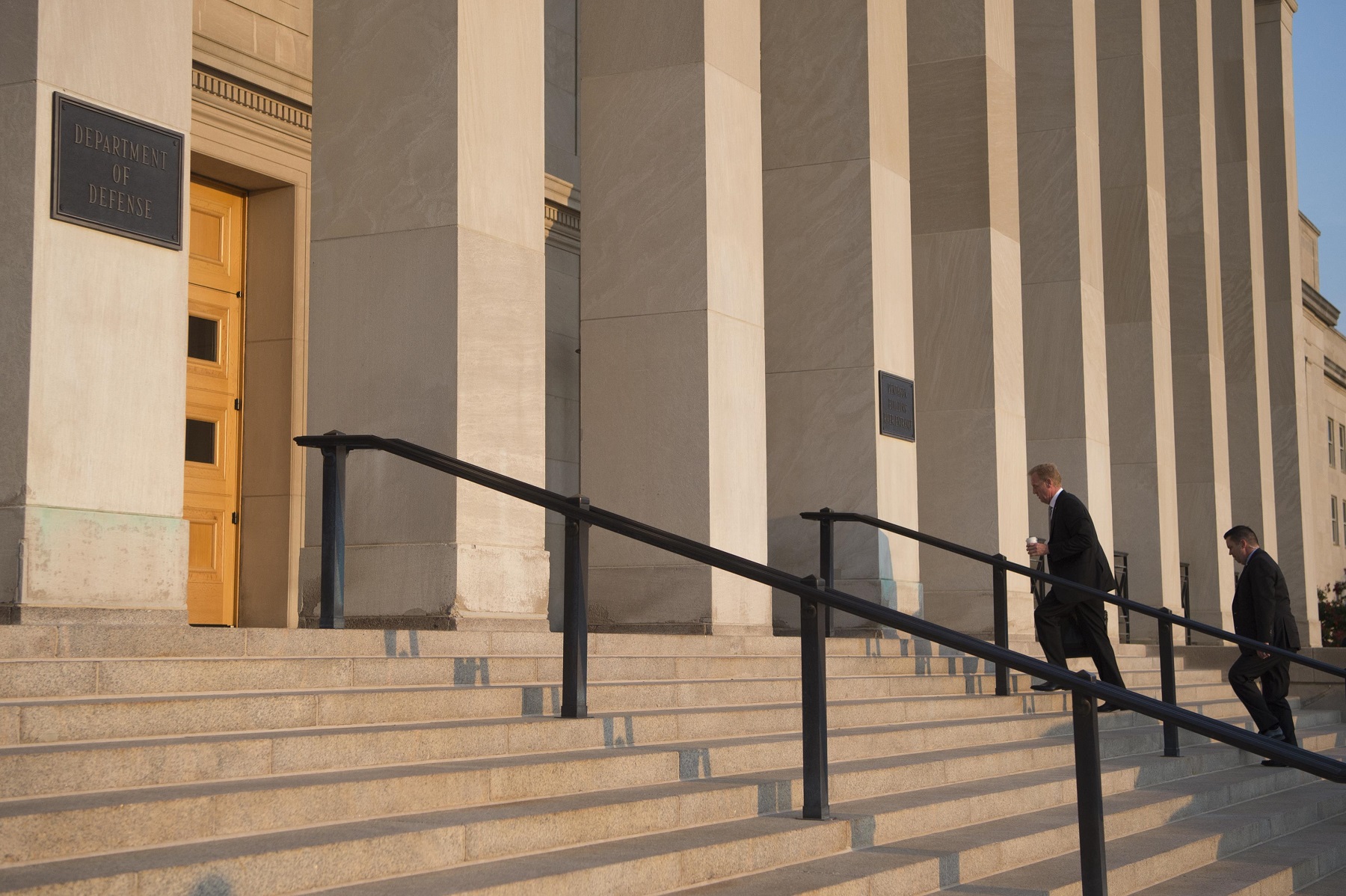
WASHINGTON ― Key Senate Democrats signaled Monday their caucus is likely to filibuster a proposed 2020 defense spending bill, which Senate Republican leaders plan to offer for a vote this week.In a Senate floor speech Monday, Majority Leader Mitch McConnell, R-Ky., dared Democrats to hold up the bill, accusing them of blocking a troop pay raise “for the sake of picking a fight with the White House,” even after the raid that killed Islamic State leader Abu Bakr al-Baghdadi.
October 29 This week on Press the Button: Chairman Adam Smith of the House Armed Services Committee. His remarks on the future of U.S. nuclear policy at the National Press Club last week made the news when he said that it was very unlikely major policy provisions would survive conference, particularly on the new, more usable nuclear weapon.
Hear his comments directly in a special edition of Press the Button called “The Chairman’s Choice.”
Geoff Wilson of Council for a Livable World discusses this surprise development with Michelle Dover and Mary Kaszynski of Ploughshares Fund on Early Warning.
Listen, Subscribe and Share on iTunes · Spotify · SoundCloud · YouTube · Google Play · Sticher
Also available on ploughshares.org/pressthebutton
The most radioactive state
Who will be the ultimate bearer of the nation’s nuclear waste?
In Mashable’s series Wasted, reporters dig into the myriad ways we’re trashing our planet. Because it’s time to sober up.
WRITTEN BY MARK KAUFMAN | .Jun 26, 2021 mashable.com
Of all the states in the union, and to the certain dismay of many local residents, New Mexico presently has the potential to become the future bearer of more and more of the nation’s nuclear excesses.
Though New Mexico will resist, and may prevail. “Folks in New Mexico are not going to take it,” said Albuquerque resident Don Hancock, who is the director of the Nuclear Waste Safety program at the Southwest Research and Information Center, an advocacy group focused on environmental and social justice. “We’ll stop this.”
“New Mexicans should not have to tolerate this risk.”
A SKINNY NDAA
Top Armed Services leaders in both houses of Congress are considering passing a slimmed-down National Defense Authorization Act that defers controversial measures for the sake of getting something passed, our colleague Connor O’Brien writes.
“It’s amounted to a backup plan,” House Armed Services Chairman Adam Smith (D-Wash.) told POLITICO, referring to the “skinny NDAA.” “It’s amounted to, we’re going to keep working on the bill itself, try to get resolved the top drawer issue of the [border] wall and we’ll have this as a backup discussion if necessary. I don’t have a problem with that.”
CHECKING TRUMP: More than 40 advocacy groups are out with a letter calling on lawmakers to oppose a final defense bill that doesn’t include the “core progressive priorities” aimed at constraining the Trump administration in the House-passed bill. That includes provisions to limit Trump’s Iran war powers, end U.S. support to the Saudi-UAE coalition in Yemen, bar new detainees at Guantanamo Bay, protect transgender troops and block deployment of new low-yield nuclear warheads.
October 22 Congressman Gerry Connolly (D-VA) gives us an insider view of the impeachment crisis and its impact on US foreign policy. Connolly serves on the Foreign Affairs and the Oversight Committees, both charged with the impeachment inquiry.
Early Warning features Joe Cirincione and Elizabeth Beavers discussing the Turkish president’s recent comments on nuclear weapons, and why we should keep the Open Skies Treaty. Joe Cirincione answers a question from Alec in Louisiana.
Listen, Subscribe and Share on iTunes · Spotify · SoundCloud · YouTube · Google Play · Sticher
Also available on ploughshares.org/pressthebutton
 Calling the National Nuclear Security Administration's latest Record of Decision (Federal Register, October 4, 2019) for the Continued Operation of the Y-12 National Security Complex , "an obvious attempt by the government to deliberately circumvent this Court's ruling," the Oak Ridge Environmental Peace Alliance, Nuclear Watch New Mexico, the Natural Resources Defense Council and four individual co-plaintiffs today filed a Motion to Enforce the judgment handed down in federal court in September by Chief United States District Judge Pamela Reeves.
Calling the National Nuclear Security Administration's latest Record of Decision (Federal Register, October 4, 2019) for the Continued Operation of the Y-12 National Security Complex , "an obvious attempt by the government to deliberately circumvent this Court's ruling," the Oak Ridge Environmental Peace Alliance, Nuclear Watch New Mexico, the Natural Resources Defense Council and four individual co-plaintiffs today filed a Motion to Enforce the judgment handed down in federal court in September by Chief United States District Judge Pamela Reeves.
"Within hours of the Judge's September ruling, NNSA told reporters that it would keep right on doing what it was doing, including building the UPF bomb plant. Then they published the new Record of Decision which is a direct challenge to the Court—it says they have decided they will comply with the Court's order at some uncertain date in the future, and in the meantime, it's business as usual. We went to court in the first place, because 'business as usual' was violating the law." — OREPA coordinator Ralph Hutchison
Erdogan’s Ambitions Go Beyond Syria. He Says He Wants Nuclear Weapons.
“There are approximately 50 US nuclear weapons, stored on Turkish soil. The United States had never openly acknowledged its existence, until Wednesday, when Trump did exactly that. When asked about the safety of these weapons, stored in a bunker controlled by the Americans at Incirlik Air Base, Mr. Trump said, “We have confidence and we have a large air base there, a very powerful air base.” But not everyone is so confident, because the air base belongs to the Turkish government. If relations with Turkey deteriorate, US access to that base is not guaranteed.”
ARTICLE BY DAVID E. SANGER & WILLIAM J. BROAD | nytimes.com
President Recep Tayyip Erdogan of Turkey addressing legislators from his party this month in Ankara, Turkey. Credit: Burhan Ozbilici/Associated PressErdogan is playing before an anti-American domestic audience with his nuclear rhetoric, but he is very unlikely to look for nuclear weapons,,quot; said Jessica C. Varnum, an expert in Turkey at the James Martin Center for Nonproliferation Studies in Middlebury in Monterey, California, “There would be huge economic and reputational costs for Turkey, which would damage the pockets of Erdogan voters.”
A Cheaper Nuclear Sponge
“With today’s technology, land-based [ballistic] missiles are an embarrassment,” the late, great strategist Thomas Schelling wrote in 1987. The weapons, he added, “seem to give the entire deterrent a bad name.”
ARTICLE BY STEVE FETTER & KINGSTON REIF | warontherocks.com
Schelling was right: Intercontinental ballistic missiles (ICBMs) are by far the least valuable leg of the so-called nuclear triad, which also consists of submarine-launched ballistic missiles, and air-delivered cruise missiles and gravity bombs.
So long as U.S. adversaries possess nuclear weapons, we believe the United States should maintain a safe, secure, and effective nuclear arsenal to deter nuclear attacks against itself and its allies. But the Trump administration’s approach to sustaining and upgrading the arsenal is unnecessary, unsustainable, and unsafe. Nowhere is this more evident than with respect to its plan to build a new ICBM.
Instead of proceeding with current plans to build an entirely new ICBM system at a cost that is likely to exceed $100 billion, the Pentagon could save scores of billions — without sacrificing U.S. security — by continuing to rely on a smaller number of existing Minuteman III missiles.
Trump administration talking tough about another government shutdown for border wall funding
On Thursday, the Senate failed a veto override on Donald Trump’s emergency declaration, which is being used to purloin funds appropriated for other programs and use them for his border wall. That sets up yet another budget fight that will simmer along between the House, Senate, and White House for the next month. It also sets up another fight over a Trump government shutdown.
ARTICLE BY JOAN MCCARTER | dailykos.com
Before the August recess, all parties agreed to a continuing resolution to fund the government until the week before Thanksgiving, in anticipation that all the individual spending bills for all the departments would be passed and signed by then. What it really set up was another fight with Trump. “Trump is not interested in signing other domestic spending bills until there is agreement on the border wall,” a senior administration official told The Washington Post.
Feds give Navajo uranium contract to firm with sketchy past
A High Country News investigation finds the EPA awarded Tetra Tech a contract despite knowing its subsidiary had likely engaged in data manipulation, false reporting and profiteering.
ARTICLE BY SUSIE NIELSEN | hcn.org
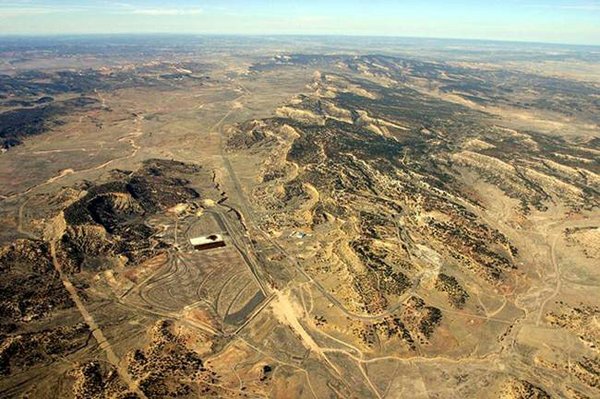
In September 2017, the Environmental Protection Agency received a troubling message from the Navy: Tetra Tech EC, the firm tasked with cleaning up the radioactive former naval shipyard Hunters Point in San Francisco, might have manipulated its data.
The past performance of Tetra Tech, even beyond its subsidiary at Hunters Point, has been marked by controversy. The parent company has been at the center of other lawsuits, including a consolidated case regarding its involvement in cleaning up after the North Bay Fires, a series of wildfires that devastated regions north of San Francisco in the fall of 2017.
“The Navajo Nation project is a bull’s-eye radioactive project with dangerous radioactivity. For Tetra Tech to get that project at all — to be even allowed to bid on it — is shocking.” – David Anton, attorney for the Tetra Tech EC whistleblowers
In 2008, the EPA and five other federal agencies, in consultation with Navajo Nation, developed the first comprehensive plan to address the legacy of uranium contamination in and around the Navajo Nation. As of 2014, of the 43 highest-priority Navajo Nation mines as designated by the EPA, only one of them — the Skyline Mine — had been mostly cleaned up.
Energy Secretary Rick Perry To Resign
NPR ALL THINGS CONSIDERED JEFF BRADY | npr.org Updated at 6:30 p.m. ET
Secretary of Energy Rick Perry plans to leave his position at the end of the year, President Trump confirmed to reporters Thursday in Fort Worth, Texas. Trump praised Perry and said he already has a replacement in mind.
“Rick has done a fantastic job,” Trump said. ” But it was time.”
Trump said that Perry’s resignation didn’t come as a surprise and that he has considered leaving for six months because “he’s got some very big plans.”
Perry, 69, is one of Trump’s original Cabinet members and recently has emerged as a central figure in the impeachment inquiry of Trump.
Urgent: Move US Nuclear Weapons Out Of Turkey
BLOG BY HANS M. KRISTENSEN | fas.org
A US Navy aircraft flies over Incirlik airbase in Turkey.Should the U.S. Air Force withdraw the roughly 50 B61 nuclear bombs it stores at the Incirlik Air Base in Turkey? The question has come to a head after Turkey’s invasion of Syria, Erdogan’s increasingly authoritarian leadership and deepening discord with NATO, Trump’s inability to manage U.S. security interests in Europe and the Middle East, and war-torn Syria only a few hundred miles from the largest U.S. nuclear weapons storage site in Europe.
The US is rethinking the 50-plus nuclear weapons it keeps in Turkey
“The US is storing perhaps 50 air-dropped thermonuclear bombs at its Incirlik Airbase in southern Turkey, less than 100 miles from the Syrian border where this conflict is taking place.”
BY: TIM FERNHOLZ | qz.com
Turkish forces are pushing into northern Syria, replacing and sometimes even firing on the US troops retreating at Donald Trump’s orders.
The question of whether Turkey, a member of the North Atlantic Treaty Organization, is really a US ally was put to US defense secretary Mark Esper on Fox television this morning. “No, I think Turkey, the arc of their behavior over the past several years has been terrible,” he said.
The nuclear stockpile dates back to the Cold War, when the US sought to keep a sufficient supply of atomic weapons deployed in Europe to deter potential Soviet aggression. Belgium, the Netherlands, Germany, and Italy also host similar arsenals, and the US trains the participating nations in the use of the doomsday devices.
Turkey Troubles
October 15 Heather Hurlburt, director of the New Models of Policy Change project at New America’s Political Reform program, joins Michelle Dover for a discussion on US national security and foreign policy under President Donald Trump. She is the co-author of The Consensual Straitjacket: Four Decades of Women in Nuclear Security.
News analysis with Michelle Dover, John Carl Baker and Geoff Wilson of Council for a Livable World focuses on the Trump administration’s decision to withdraw US troops from the Turkey-Syria border. Joe Cirincione answers a question from Johnny from Massachusetts.
Listen, Subscribe and Share on iTunes · Spotify · SoundCloud · YouTube · Google Play · Sticher
Also available on ploughshares.org/pressthebutton
Even a limited nuclear war between India and Pakistan could induce nuclear winter, thereby potentially killing 100’s of millions beyond South Asia.
From study: “Rapidly expanding nuclear arsenals in Pakistan and India portend regional and global catastrophe”
What if We Nuke a City?
“The world has changed in the past few years with world leaders again explicitly and publicly threatening each other with nuclear weapons. Many experts think the danger of a nuclear strike is higher than it has been in decades.
Governments tell their citizens that it’s good that we have nuclear weapons, but bad when others have them; that it’s somehow necessary to threaten others with mass destruction to keep us safe. But does this make you feel you feel safe? It only takes a small group of people in power to go crazy or rouge, a small misstep or simple misunderstanding to release a catastrophe of unimaginable proportions.”
Kurzgesagt – In a Nutshell
Video Description: “Until we did the research. It turned out we were a bit oblivious off the real impact of nuclear weapons in the real world, on a real city. And especially, how helpless even the most developed nations on earth would be if an attack occurred today. So hopefully this video demonstrates how extremely non fun a real world nuclear attack would be, without being too gruesome.”
DOE Order 140.1: DNFSB Response, Oct. 11
Chair Hamilton responds, “Pursuant to our enabling legislation, we have directed our staff to attend all phases of the NES study process. Should you wish to prohibit our access to a particular study, we respectfully request written communication to the Board.”
[NES = the nuclear explosive safety (NES) elements of DOE O 452.1E, Nuclear Explosive and Weapon Surety Program]
Oct. 11, 2019
The Honorable James Richard Perry Secretary of Energy
U.S. Department of Energy
1000 Independence Avenue, SW Washington, DC 20585-1000
Dear Secretary Perry:
We have received NNSA’s response dated August 9, 2019, concerning Board access to all phases of the nuclear explosive safety study process. We respectfully disagree with the justification offered for continued exclusion of our staff from NES study deliberations. NNSA’s response notes deliberations as collaborative efforts where participants consider all sides of identified issues, requiring free and open communication. Our staff’s observation of this interaction provides them with an understanding of the bases of the safety decisions being taken.
Today is Indigenous People’s Day, a holiday to honor and celebrate Native American and Indigenous peoples.
Among the many injustices suffered by native communities in the centuries that have passed since Europeans arrived on North America’s shores and claimed it for their own is the dangerous and deadly exposure to the radioactive materials used to create nuclear weapons. The United States’ nuclear arsenal has taken an especially hard toll on the Navajo, who continue to live with the repercussions of nuclear mining even today.
BACKGROUND
EXCERPT FROM POST BY CASSANDRA VARAKA, POLICY DIRECTOR OF WAND |
The process of building nuclear weapons starts with mining. One of the main elements of a nuclear bomb is enriched uranium. Some of the world’s richest uranium deposits span across Arizona, New Mexico, and Utah — heavily overlapping with the Navajo Nation. These mines provided the uranium used in the Manhattan Project; the United States’ top-secret endeavor to build the first nuclear bombs. Between 1944 and 1986 mining companies blasted 4 million tons of uranium out of Navajo land. Until 1971, uranium from these mines was sold exclusively to the United States government. Many Navajo were employed in the uranium mines and exposed to unsafe conditions by the companies in employing them. The mining companies knew that mine workers were at heightened risk for developing lung cancer and other serious respiratory diseases in 15 or 20 years. Additionally, the mines operated in a way that contaminated the surrounding lands and water by leaving large piles of radioactive materials exposed.
Many Navajo continue to live in close proximity to contaminated uranium mines. Of the 523 abandoned mines, the Environmental Protection Agency has only successfully cleaned up nine. The legacy of these mines and the contamination they leached into the environment on the Navajo Nation has been devastating: the cancer rate on the reservation doubled from the early 1970’s to the late 1990’s, even as the cancer rate declined nationwide. Each and every day, minority populations like the Navajo continue to be unduly affected by the militaristic pursuits of our government. For the Navajo, that means generations of health problems in the name of our nuclear weapons. We owe it to them, and to all the marginalized communities harmed by our pursuit and maintenance of nuclear weapons, to highlight the price they have been forced to pay for our nuclear arsenal.
READ MORE
When Talking About the Climate Crisis, We Can’t Forget About Nuclear Weapons
Both are existential threats, but only one is getting the attention it deserves.
BY: MATT KORDA | thenation.com
The first atomic bomb test was conducted at Alamogordo, New Mexico, July 16, 1945. (AP / US Army)“The current attention gap between the climate crisis and nuclear weapons is bizarre, given their common existential stakes and challenges. Climate change and nuclear weapons have a symbiotic relationship: Each threat exacerbates the other. Climate change is setting the stage for conflict between nuclear-armed states, and a recent study suggests that even a regional nuclear war would cool the planet by 2 to 5 degrees Celsius and cause mass starvation for over a decade. Not to mention the fact that even during peacetime, decades of uranium mining, nuclear testing, and nuclear waste dumping have contaminated some of our planet’s ecosystems beyond repair, displacing entire communities—often communities of color—in the process.
The flip side of this symbiosis, however, means that climate change and nuclear weapons also share a common solution. A progressive nuclear policy should be based upon four core principles of the Green New Deal—international cooperation, reductions, transparency, and justice. Only by challenging the nuclear-industrial complex in its entirety—in a way akin to how the Green New Deal challenges the carbon economy in its entirety—can a progressive nuclear policy pull us back from the brink of atomic and environmental catastrophe. Progressive climate change policies should include demilitarization and disarmament provisions, and progressive nuclear policies should address the climate and humanitarian impacts of nuclear weapons. Similarly, nuclear activists and climate change activists are natural allies in the fight against existential risk, and both causes would benefit from a more robust partnership.
To that end, the significant attention imbalance between climate change and nuclear weapons must be urgently corrected; keeping them siloed reinforces an incomplete narrative about the nature of these existential threats.
US, critics split on whether tech made nuke shipments safer
“There’s enough high-level nuclear waste awaiting disposal in the U.S. to fill a football field 65 feet (20 meters) deep. Few states want to house it within their borders.”
“The public defines ‘safe’ as zero risk…the technical community defines ‘safe’ as complying with regulatory standards.” – Robert Halstead, head of the Agency for Nuclear Projects, is currently fighting plutonium shipments to Nevada and spent nuclear fuel transfers to the proposed Yucca Mountain dump.
BY: SCOTT SONNER | phys.org
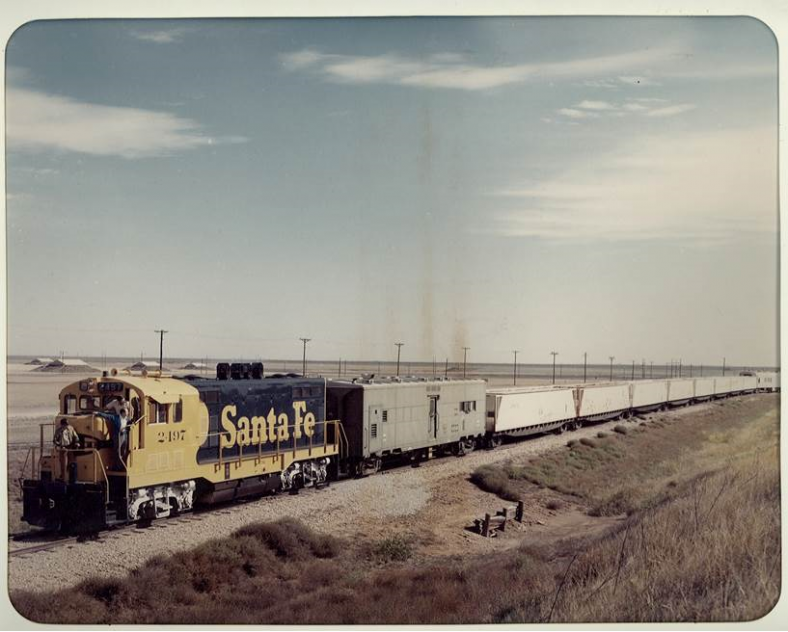
The plutonium core for the first atomic weapon detonated in 1945 was taken from Los Alamos National Laboratory to a test site in the New Mexico desert in the backseat of a U.S. Army sedan.
Officials put other bomb parts inside a metal container, packed it into a wooden crate and secured it in the steel bed of a truck under a tarp, the U.S. Energy Department’s National Nuclear Security Administration says in a historical account.
Grainy black-and-white photos show special agents and armed military police accompanying the shipment nearly 75 years ago.
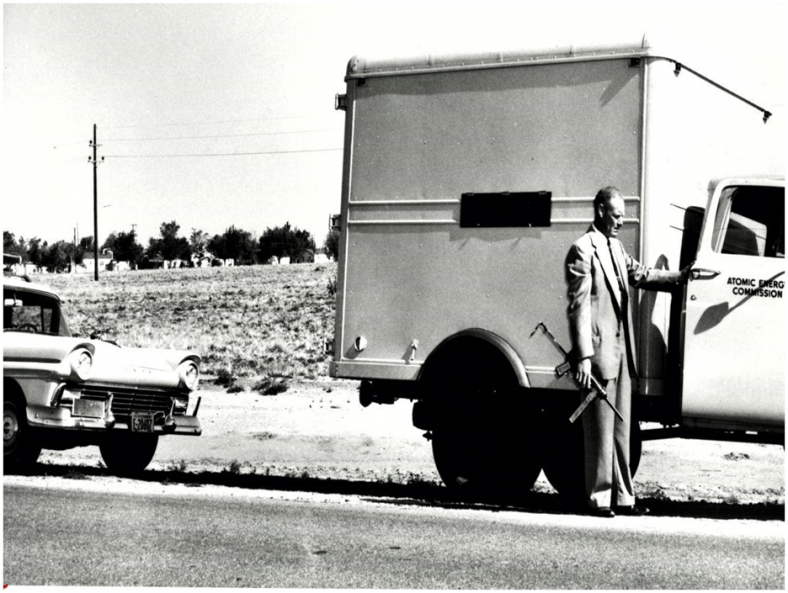
“Nuclear materials transportation has evolved since then,” the department posted online last year.
Today, radioactive shipments are hauled in double-walled steel containers inside specialized trailers that undergo extensive testing and are tracked by GPS and real-time apps.
But whether shipping technology has evolved enough to be deemed safe depends on whom you ask.
New research: Regional nuclear war will cause catastrophic global consequences
Two scientific studies modelling the effects of nuclear war released in the past few weeks have revealed some terrifying figures:
- 91.5 million deaths in a matter of hours, if nuclear conflict breaks out between the United States and Russia,
- 125 million deaths in case of a week-long conflict between India and Pakistan using 100 kilotonne nuclear warheads,
- A 30% reduction in surface sunlight due to the 36 teragrams of black carbon released into the atmosphere after the India-Pakistan conflict,
- Two billion people at risk of famine.
The two studies, Princeton’s Science and Global Security programme “Plan A” [ 1] and Science Advances’ Rapidly expanding nuclear arsenals in Pakistan and India portend regional and global catastrophe [ 2], show that there is no such thing as a contained nuclear conflict.
These are not farfetched scenarios. This new research comes out as tensions are increasing between India and Pakistan, and four of the nine nuclear-armed states have tested nuclear missiles in just the past two weeks. [3, 4] You can read more about this new research here.
The science is clear: we need to eliminate nuclear weapons, before they are used again.
Feds move to demolish 13 structures at toxic Santa Susana site without state oversight
BY: MIKE HARRIS | vcstar.com
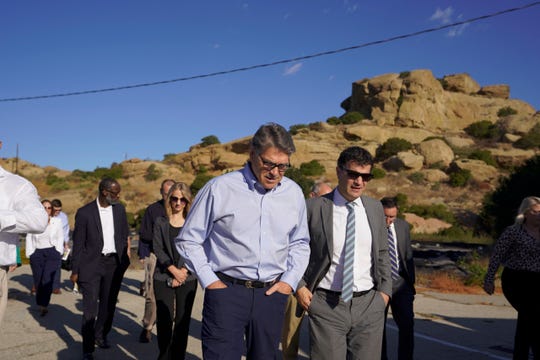
The U.S. Department of Energy announced this week it has decided to demolish and remove, without state oversight, 13 of 18 remaining structures from its portion of the contaminated Santa Susana Field Laboratory as part of the much-delayed cleanup of the site.
However, in a so-called record of decision it issued Monday, the federal agency said it recognizes that the demolition and removal of the other five structures must be “compliant” with state permits and state hazardous waste laws.
Expanding nuclear weapon production is reckless
“Placing a novel warhead design in the active nuclear weapons stockpile with a substantially untested pit is irresponsible. Rapidly increasing production at sites with spotty records compounds that error with added safety hazards. Increasing plutonium pit production to a rate of 80 or more annually is both reckless and unnecessary.”
BY: MARYLIA KELLEY & JOSEPH RODGERS | thehill.com
© Getty ImagesBehind closed doors, Congress is in the process of making a decision that will have a profound impact on nuclear risk levels and global security. Hanging in the balance is a decision to recklessly increase production of plutonium bomb cores or “pits.” The NDAA conference committee must not make that mistake.
Pits are the triggers for thermonuclear weapons. Currently, the United States does not manufacture plutonium pits on an industrial scale. In its fiscal 2020 budget request the National Nuclear Security Administration (NNSA) seeks authorization to produce at least 80 plutonium pits per year by 2030 at two facilities separated by some 1,500 miles. The Senate NDAA fully funds the request. The House instead authorizes 30 pits per year, all at the Los Alamos National Laboratory in NM. Los Alamos is presently authorized to produce 20 pits annually.
WIPP: New Mexico nuclear waste site’s five-year plan deemed ‘insufficient’ by state leaders
A group of governors from western states voiced “disappointment” in a recently released five-year strategic plan for ongoing operations at the Waste Isolation Pilot Plant, contending they weren’t adequately consulted on the future of the nuclear waste repository near Carlsbad.
BY: ADRIAN HEDDEN | carlsbadcurrentargus.com
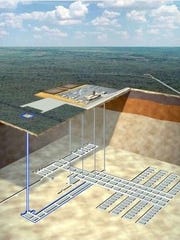
Don Hancock, director of the Nuclear Waste Program at the Southwest Research and Information Center said the plan was insufficient in that it did not detail plans and costs needed to keep WIPP open until 2050. He said the plan detailed projects intended to keep WIPP open beyond 2025, without adequately explaining the associated costs.
“It’s not a five-year plan,” Hancock said. “The centerpiece of the plan is WIPP being open until 2050. That’s 30-year plan. They’re saying WIPP’s timeline needs to be doubled. This should be saying how WIPP is transitioning from emplacement to closure, but it does the opposite.”
Hancock said the DOE must communicate with the public on either keeping WIPP, known as a pilot project, open indefinitely or developing other repositories to handle the low-level transuranic (TRU) waste disposed of at the site.
He said another alternative would be for the DOE to develop a plan to emplace the waste at the generator sites – multiple nuclear facilities across the country – themselves.
US official: Research finds uranium in Navajo women, babies
About a quarter of Navajo women and some infants who were part of a federally funded study on uranium exposure had high levels of the radioactive metal in their systems, decades after mining for Cold War weaponry ended on their reservation, a U.S. health official said. The early findings from the University of New Mexico study were shared Monday during a congressional field hearing in Albuquerque.
MARY HUDETZ, ASSOCIATED PRESS jhnewsandguide.com
Leslie Begay, left, speaks with U.S. Rep. Deb Haaland, D-New Mexico, Monday outside a congressional field hearing in Albuquerque, N.M., highlighting the atomic age’s impact on Native American communities. Begay, a former uranium miner on the Navajo Nation with lung problems, says there are lingering injustices and health problems on his reservation decades after mines closed. An Indian Health Service official cited federal research at the hearing that she says showed some Navajo women, males and babies who were part of the study had high levels of uranium in their systems.Dr. Loretta Christensen — the chief medical officer on the Navajo Nation for Indian Health Service, a partner in the research — said 781 women were screened during an initial phase of the study that ended last year. Among them, 26% had concentrations of uranium that exceeded levels found in the highest 5% of the U.S. population, and newborns with equally high concentrations continued to be exposed to uranium during their first year, she said. The research is continuing as authorities work to clear uranium mining sites across the Navajo Nation.
“It forces us to own up to the known detriments associated with a nuclear-forward society,” said U.S. Rep. Deb Haaland, who is an enrolled member of Laguna Pueblo, a tribe whose jurisdiction lies west of Albuquerque.
The hearing held in Albuquerque by U.S. Sen. Tom Udall, Haaland and U.S. Rep. Ben Ray Lujan, all Democrats from New Mexico, sought to underscore the atomic age’s impact on Native American communities. The three are pushing for legislation that would expand radiation compensation to residents in their state, including post-1971 uranium workers and residents who lived downwind from the Trinity Test site in southern New Mexico.
An evolving nuclear agenda spurs plutonium pit production at LANL
A ‘dirty, dirty process’
BY: KENDRA CHAMBERLAINE | nmpoliticalreport.com

Los Alamos has a starring role in a shift to U.S. nuclear policy that’s two presidential terms in the making. Nuclear watchdog groups in the state are concerned about the United States’ evolving nuclear agenda, which will see a sharp increase in plutonium pit production at Los Alamos National Laboratory (LANL).
LANL recently released its $13 billion expansion proposal to accommodate increased pit production at the site. The expansion is part of a wider push across the country to ramp up the nuclear warhead manufacturing machine, according to Greg Mello, executive director of the Los Alamos Study Group.
Plutonium pits are central to nuclear weaponry. They are the “radioactive cores of modern nuclear weapons,” said Jay Coghlan, executive director of Nuclear Watch New Mexico. He added that the pits themselves are weapons. “It was essentially a plutonium pit that destroyed Nagasaki on August 9, 1945,”
The ramp-up is years in the making, as successive presidential administrations have struggled to address how to modernize the U.S. nuclear stockpile. But nuclear watchdog groups worry an increase in pit production at LANL would have negative repercussions for the region. While LANL has touted the proposed economic benefits of its proposal for the area, activists argue the dangers outweigh the benefits.
Trump’s rumored pullout from Open Skies Treaty would idle Offutt jets
BY: STEVE LIEWER | OMAHA WORLD HERALD omaha.com
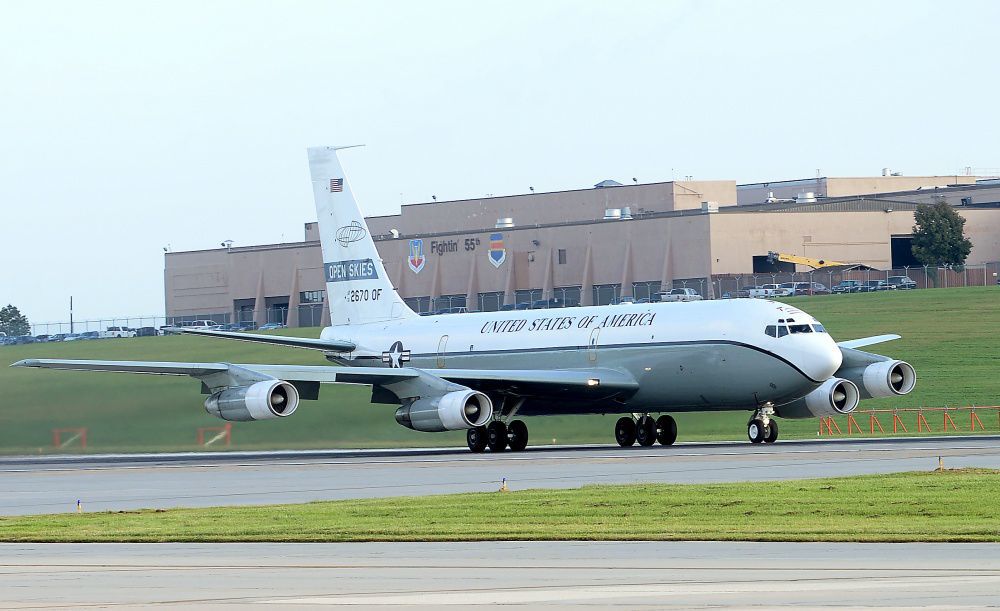
The Trump administration is believed to be preparing to pull out of the 34-nation Open Skies Treaty, a plan that would idle two Offutt-based OC-135B reconnaissance jets and their crews.
The treaty, proposed by President George H.W. Bush following the Cold War, allows member nations to fly supervised photo-reconnaissance flights over one another’s countries. This week, the U.S. and Germany are partnering on an Open Skies mission over Russia.
The planes are crewed and maintained at Offutt by the 45th Reconnaissance Squadron, which is part of the 55th Wing. Several dozen Offutt airmen are involved in the program.
The Nuclear Philanthropist
October 8 The MacArthur Foundation Director of the Nuclear Challenges Program Emma Belcher comes on Press the Button to discuss the role of philanthropy in fighting the two existential threats to humanity – nuclear weapons and climate change. On the Early Warning news segment, Erica Fein from Win Without War joins Tom Collina and Akshai Vikram from Ploughshares Fund to discuss the impeachment inquiry and how it’s affecting the debate over the defense budget.
Also, an answer to the question: Do nuclear weapons work in space?
Listen, Subscribe and Share on iTunes · Spotify · SoundCloud · YouTube · Google Play · Sticher
Also available on ploughshares.org/pressthebutton
There are about 26 nuclear weapons corporations earning nearly $100 billion per year amongst themselves. ‘They have vested financial interests in producing more and more nuclear weapons,’ says Dr Keith Suter (Australia), Economics Futurist and member of the Club of Rome, ‘and they exert intense political power on decision makers to protect these interests.‘
As the United Nations First Committee (Disarmament and International Security) starts its 2019 session in New York today, plans are progressing to publicise the colossal waste of money on nuclear weapons by physically ‘counting out’ the global nuclear weapons budget.
Over the next four weeks, governments meeting at the UN will debate and vote upon a number of nuclear disarmament resolutions. However, the impact of these resolutions is likely to be minimal as long as there continues to be strong financial interests in maintaining the nuclear arms race.
Count the Nuclear Weapons Money
The Count the Nuclear Weapons Money Action, which takes place during UN Disarmament Week (October 24-30), aims to raise media and public attention to this, and to publicise actions that indivduals and organisations can take to cut nuclear weapons budgets, end investments in nuclear weapons corporations, and shift these budgets and investments to better purposes.
The money counting will take place in a number of outside locations around Manhattan (as well as in New Jersey and Long Island) and at an interactive installation in an art gallery in the Chelsea neighborhood of Manhattan. Click here if you would like to join the counting.
Impeachment Slows All Hill Defense Biz; DoD Approps On Life Support
There’s not a lot of confidence out there about the prospects for a 2020 budget agreement. “A stripped down mini-NDAA may be all that could pass this year for defense,” says one long-time budget watcher.
BY COLIN CLARK | breakingdefense.com
WASHINGTON: As the House of Representatives gears up to impeach President Trump, it’s getting harder and harder for anyone involved in defense to get a hearing with leadership, and the chances for a defense appropriations bill appear to be getting smaller every day.
While the chances for a second year of regular order (actually passing spending and major policy bills) already seemed unlikely, impeachment is sucking the oxygen out of the room, leaving regular order gasping for air. President Trump’s decision to take $3.6 billion from military construction accounts to build the so-called wall along the border with Mexico probably killed the chances for a defense spending bill. Add impeachment and the experts say abandon hope, all ye who enter the Capitol.
We’re More at Risk of Nuclear War With Russia Than We Think
U.S. lawmakers on both sides of the aisle need to start addressing the danger.
BY: GEORGE BEEBE | politico.com

In the 1950s and 1960s, Americans genuinely and rightly feared the prospect of nuclear war with the Soviet Union. Schoolchildren regularly participated in air raid drills. Federal, state and local governments prepared for operations in the event of a nuclear emergency. More than a few worried citizens built backyard bomb shelters and stockpiled provisions.
Today, that old dread of disaster has all but disappeared, as have the systems that helped preclude it. But the actual threat of nuclear catastrophe is much greater than we realize. Diplomacy and a desire for global peace have given way to complacency and a false sense of security that nuclear escalation is outside the realm of possibility. That leaves us unprepared for—and highly vulnerable to—a nuclear attack from Russia.
The most recent sign of American complacency was the death, a few weeks ago, of the Intermediate-Range Nuclear Forces Treaty—a pivotal 1987 agreement that introduced intrusive on-site inspection provisions, destroyed an entire class of dangerous weaponry, and convinced both Washington and Moscow that the other wanted strategic stability more than strategic advantage.
Trump Claims Energy Secretary Rick Perry Is Behind Ukraine Call at Heart of Impeachment Inquiry: Report
President Trump told House Republicans that he made his now infamous phone call to Ukrainian President Volodymyr Zelensky at the urging of Energy Secretary Rick Perry — a call Trump claimed he didn’t even want to make.
BY ANNA KAPLAN | thedailybeast.com Oct. 5, 2019
President Trump has reportedly tried to pin the explosive Ukraine call at the center of an impeachment inquiry on Energy Secretary Rick Perry. Axios reports that the president claimed Perry had asked him to make the July phone call to Ukrainian President Volodymyr Zelensky that sparked a whistleblower complaint. Trump reportedly claimed that he did not even want to call Zelensky, but said Perry had wanted him to inquire about a liquified natural gas plant. Trump is currently facing an impeachment inquiry for allegedly using that phone call to pressure Zelensky to pursue an investigation into former vice president Joe Biden and his son’s ties to a major Ukrainian gas company.
Rapidly expanding nuclear arsenals in Pakistan and India portend regional and global catastrophe
The title of a new study by Toon et al, published this week in Science Advances, speaks volumes: “Rapidly Expanding nuclear arsenals in Pakistan and India portend regional and global catastrophe.”
advances.sciencemag.org | PSR’s press statement | usatoday.com | icanw.org

The study models the potential impacts of a regional nuclear conflict and found that, given the increased size and power of their respective nuclear arsenals, the effects of a nuclear conflict between India and Pakistan would have even more catastrophic impacts than previously thought.
Top Health Expert Warns of Drinking Water Risks in Piketon Radiation Case
“The source of the uranium and other poisonous substances found in the air and on school property — the Portsmouth Gaseous Diffusion Plant near Piketon, Ohio, which made material for nuclear bombs throughout the Cold War — is owned by the federal government. Simply put, the feds aren’t working very hard to investigate themselves.”
BY STUART H. SMITH | stuarthsmith.com
One thing that I’ve found to be a constant in more than 25 years of working cases around pollution from radiation: A good outside expert will often tell citizens the things that government or big business simply can’t or won’t.
IG: Embattled coalition should return up to $300K to DOE
ARTICLE BY: T.S. LAST | abqjournal.com
SANTA FE – The U.S. Department of Energy’s inspector general is recommending that the department seek reimbursement of up to $300,000 in DOE grant money that a coalition of local governments in northern New Mexico didn’t properly account for.
“The Regional Coalition is not the effective lobbying voice for clean up at Los Alamos that it claims to be because it condones DOE’s plan for cleanup on the cheap that will leave the vast majority of radioactive and toxic wastes permanently buried above our groundwater,” Jay Coghlan of Nuclear Watch New Mexico said in a statement Wednesday.
“The Coalition should pay the American taxpayer back whatever it improperly spent and be terminated. At a minimum, the City of Santa Fe should resign from this discredited Coalition right away.”
October 1 House Democrats launched an impeachment inquiry against President Donald Trump last week. What does this mean for nuclear policy and national security? Ro Khanna, US Representative from California’s 17th congressional district, joins Joe Cirincione for a special interview on the explosive allegations against the US president and the need to prevent a new war of choice during this time. Rep. Khanna, with Rep. Matt Gaetz (R-FL), introduced a bipartisan amendment to the annual National Defense Authorization Act to prevent federal funds from being used for any military force against Iran without congressional authorization. “In the Silo” provides an exclusive look at the August 6 protest in front of the Lawrence Livermore National Laboratory, featuring narration by Ploughshares Fund Development Associate Elissa Karim.
News summary with Mary Kaszynski, Joe Cirincione, and Abigail Stowe-Thurston of the Center for Arms Control and Non-Proliferation. Joe Cirincione answers a question from Susan in California.
Listen, Subscribe and Share on iTunes · Spotify · SoundCloud · YouTube · Google Play · Sticher
Also available on ploughshares.org/pressthebutton

BY THAD MOORE tmoore@postandcourier.com
About this series
This article is the second part in “Lethal Legacy,” The Post and Courier’s investigation into the nation’s plans for disposing of plutonium, the dangerous metal that triggers nuclear weapons. This installment probes the Department of Energy’s failed MOX project, an ambitious but doomed effort to clean up the legacy of the Cold War.
Part I: Why South Carolina is likely stuck with a stockpile of the nation’s most dangerous nuclear materials
Dogged by faulty assumptions and lacking political will, the federal government squandered billions of dollars and an opportunity to dispose of the nation’s most dangerous nuclear material by chasing a massive construction project in South Carolina that was doomed from the start.
The MOX saga reveals an unsettling reality of the nuclear era after the Cold War. The U.S. and the world’s other nuclear powers have proven they are capable of pulling the explosive potential out of atoms, but they have proven unable to dispose of a creation that will retain immense power and be a danger for eternity.
What is MOX? MOX, short for mixed-oxide, is a type of fuel for commercial nuclear reactors. It gets its name from the combination of two oxidized nuclear metals: plutonium and uranium.The U.S. government and Russia agreed to make MOX fuel with highly enriched plutonium, which they made for nuclear weapons during the Cold War. The idea was to make the plutonium less potent and generate electricity by reacting it in power plants; the project’s supporters described it as a way for the countries to turn their “swords into plowshares.”
Nuclear weapons: Explained in numbers
There are far fewer nuclear weapons now than at the height of the Cold War and the major nuclear powers have all signed up to the principle of disarmament. But there are other countries that possess nuclear weapons which have not signed up to any arms control treaties.
And with fears of a renewed nuclear arms race between the US, Russia and China, the topic is high on the agenda at this year’s UN General Assembly. Reality Check’s Jack Goodman takes a look at the facts and figures behind the world’s nuclear arsenals.
Motion graphics by Jacqueline Galvin. | 26 Sep 2019 © bbc.com
Is it time to ditch the NPT?
“Nuclear weapon states have used this treaty to argue that their nuclear weapons are legal and a sovereign right. As a result, the NPT became the cornerstone of a severely hypocritical nuclear order where a few states regard wielding their nuclear weapons as legitimate while proscribing this sovereign right to other states…nuclear weapon states have no intention to give up their nuclear weapons.”
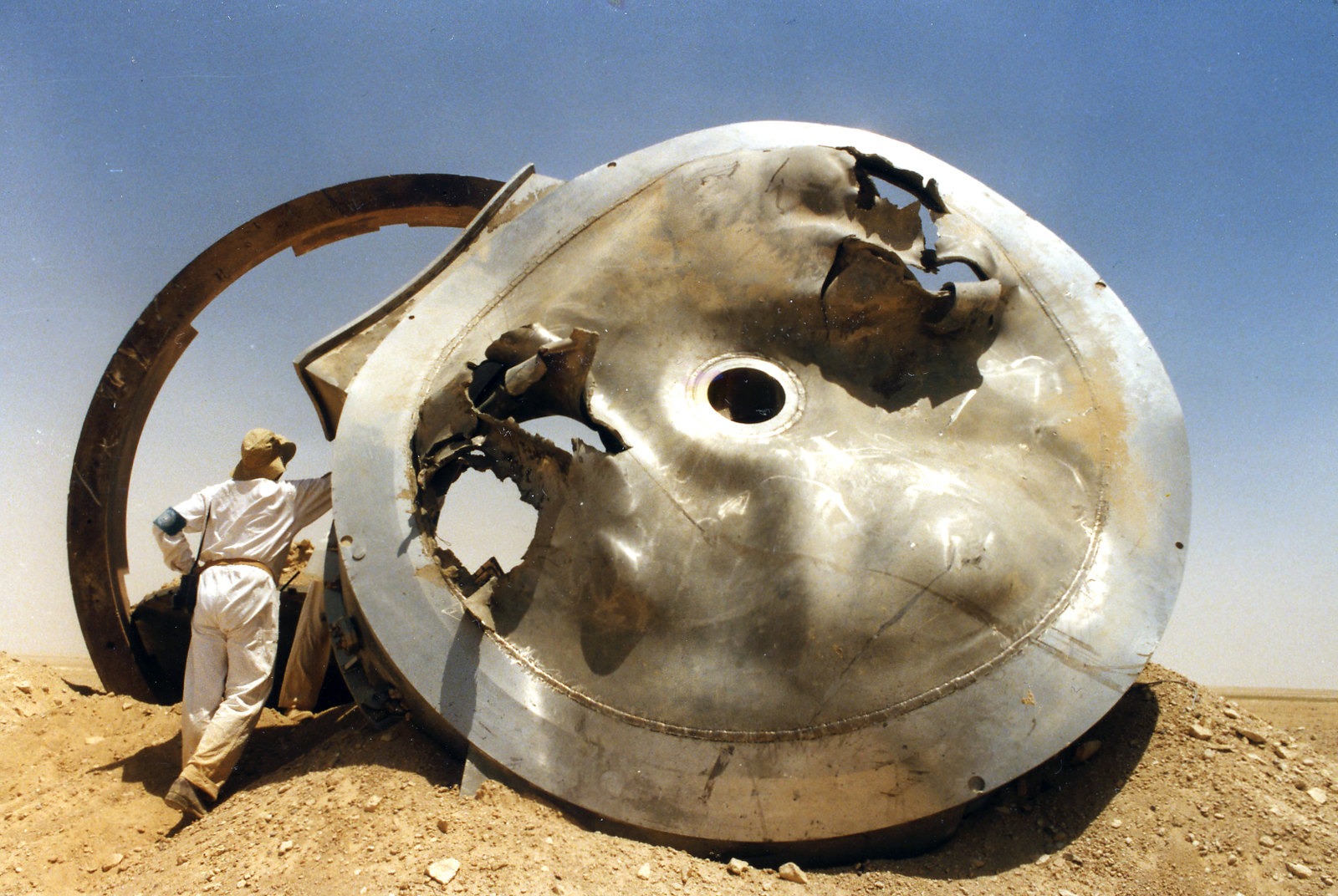
BY JOELIEN PRETORIU & TOM SAUER | thebulletin.org ![]()
In 2020, the participants in the 1970 Treaty on the Non-Proliferation of Nuclear Weapons (NPT) will congregate for the treaty’s 10th review conference. Which means that it may be a good time to re-examine the relevance of the NPT, and even consider the idea of dropping this treaty in its entirety, in favor of the new kid on the block: the 2017 Treaty on the Prohibition of Nuclear Weapons, also know as the Ban Treaty. At the risk of grossly oversimplifying, one treaty seeks to stop the further spread of nuclear weapons, while the other goes further and seeks to get rid of them entirely. This difference is reflected in their formal titles.
New Aerial Photos Released of Trifecta of U.S. Nuclear Construction Debacles
“We are pleased to facilitate distribution of the photos of the three failed nuclear projects in South Carolina and Georgia as close observation of them will reveal the status of the sites and where so much money has been needlessly wasted,” said Tom Clements, Director of Savannah River Site Watch (SRS Watch). “It is stunning to realize that perhaps $40 billion has been spent so far on the three sites, with the cost at all of them going up daily, money that should have been spent on projects of positive benefit to the public,” added Clements. “The photos commemorate the three largest, failed nuclear construction projects in the United States and will be of use when the proper investigations into the failed projects are conducted,” added Clements.
How a $5 part used to modernize nuclear warheads could cost $850 million to fix
World’s first nuclear smart bomb to become even more expensive..
BY AARON MEHTA | defensenews.com
WASHINGTON — Issues with commercial parts on two nuclear warhead modernization projects could cost up to $850 million to fix, but the agency in charge of America’s warheads believes it has a solution.
The issue, first revealed by Verdon during the Sept. 4 Defense News Conference, would put both warhead modernization programs at an 18- to 20-month delay of their first production units, although NNSA is hopeful there won’t be significant delays on the overall program timelines.
The parts in question are commercially available capacitors that, during stress testing, did not give NNSA confidence they could survive the 20-30 years needed for these designs. Verdon stressed that the parts were not at risk of failure under normal circumstances, but that the agency was acting out of an abundance of caution for the long-term life of the weapons.
That caution is pricey: the Original capacitors, Verdon said, ran about $5 per unit. The upgraded ones, built to a higher standard NNSA believes can survive the lifetime of the programs, come in at $75 per unit. All told, the B61-12 will cost an extra $600-700 million, and the W88 will cost about $120-$150 million because of the capacitor issue.
Federal Court Vacates former Y-12 Bomb Plant Ruling
ARTICLE FROM HUNGTINGTON NEWS huntingtonnews.net
“With this ruling,” said Ralph Hutchison, coordinator of the Oak Ridge Environmental Peace Alliance, “the NNSA no longer has any legal authority to continue construction of the Uranium Processing Facility bomb plant.” The decision may have ramifications for NNSA’s efforts to expand nuclear weapons production at other sites, too, including Los Alamos, NM and Savannah River, SC, where environmental scoping is underway for a new plutonium pit manufacturing facility.
Jay Coghlan, director of co-plaintiff Nuclear Watch New Mexico, said, “Uranium and plutonium components manufacturing are two sides of the same coin of expanding nuclear weapons production in an escalating arms race. The Department of Energy should take this court ruling against its Uranium Processing Facility as a warning that it must also comply with National Environmental Policy Act requirements while ill-advisably expanding the production of plutonium pits, the radioactive cores of nuclear weapons.”
The ruling also points out the crucial role the Defense Nuclear Facilities Safety Board plays in monitoring safety issues at Y-12 and across the nuclear weapons complex. Since last year, the Department of Energy has worked to reduce the Safety Board’s access to some nuclear facilities, even issuing a revised Order to limit the information available to the Board and the restricting who the Board can and cannot speak to directly.
12 States join the Nuclear Ban Treaty on International Day for the Total Elimination of Nuclear Weapons 2019
On the International Day for the Total Elimination of Nuclear Weapons, 12 states took another significant step towards achieving this goal by signing or ratifying the UN Treaty on the Prohibition of Nuclear Weapons, during a special High-Level Ceremony at the UN Headquarters in New York.
The five nations that ratified during the ceremony are:
- Bangladesh
- Kiribati
- Laos
- Maldives
- Trinidad & Tobago
These states are also joined by Ecuador, which became the 27th state to ratify the Treaty on September 25th, one day before the ceremony.
The following states signed on to the Treaty: Botswana, Dominica, Grenada, Lesotho, St Kitts and Nevis, Tanzania and Zambia, as well as the Maldives and Trinidad and Tobago (as the latter two states both signed and ratified the Treaty during the ceremony).
The treaty now has 79 signatories and 32 States Parties. By signing, a State commits to not take any action that would undermine the treaty’s object and purpose. Upon depositing its instrument of ratification, acceptance, approval or accession, a state becomes legally bound by the terms of the treaty. When the Treaty has 50 states Parties it will enter into force, making nuclear weapons illegal under international law.
The ceremony was hosted by long-time champions of the Treaty: Austria, Brazil, Costa Rica, Indonesia, Ireland, Mexico, New Zealand, Nigeria, South Africa and Thailand and enabled presidents and foreign ministers to take this important step while they were gathered at the UNGA.
Newly-elected President of the UN General Assembly, Mr Tijjani Muhammad-Bande of Nigeria, opened the ceremony, and spoke passionately in support of the Treaty’s importance in ending nuclear weapons. “We commend states that have joined TPNW and urge those who have not done so to do join in this most vital action,“ he said during his address to the UNGA Plenary event earlier in the day.
Beatrice Fihn, Executive Director of ICAN, celebrated the move by these 12 countries and the outspoken support for the Treaty around the world throughout the day. “Away from most cameras, we come together to do the actual work of nuclear disarmament. For the good of your people and the good of the world you propel the Treaty toward entry-into-force […] Today, in this room, I feel the scale tilting toward the Elimination of Nuclear Weapons. This day of action gives us all hope at a bleak time.”
After today, the treaty is almost two-thirds of the way to its entry into force, and this momentum is expected to continue. Several countries have confirmed to ICAN that their ratifications are imminent, and campaigners around the world will not stop until every country is on board.
Join the movement to end nuclear weapons
The full ceremony can be viewed here:
Nuclear power is not the answer in a time of climate change
Wild weather, fires, rising sea levels, earthquakes and warming water temperatures all increase the risk of nuclear accidents, while the lack of safe, long-term storage for radioactive waste remains a persistent danger.
BY HEIDI HUTNER & ERICA CIRINO | aeon.co

Proponents of nuclear power say that the reactors’ relative reliability and capacity make this a much clearer choice than other non-fossil-fuel sources of energy, such as wind and solar, which are sometimes brought offline by fluctuations in natural resource availability. Yet no one denies that older nuclear plants, with an aged infrastructure often surpassing expected lifetimes, are extremely inefficient and run a higher risk of disaster.
‘The primary source of nuclear power going forward will be the current nuclear fleet of old plants,’ said Joseph Lassiter, an energy expert and nuclear proponent who is retired from Harvard University. But ‘even where public support exists for [building new] nuclear plants, it remains to be seen if these new-build nuclear plants will make a significant contribution to fossil-emissions reductions given the cost and schedule overruns that have plagued the industry.’
Nuclear Abolition: The Road from Armageddon to Transformation
Nuclear weapons pose a grave threat to the future of civilization. As long as we allow these weapons to exist, we flirt with the catastrophe that they will be used, whether intentionally or accidentally.
ESSAY BY DAVID KRIEGER
Great Transition Initiative (August 2018), http://www.greattransition.org/publication/nuclear-abolition.
Meanwhile, nuclear weapons skew social priorities, create imbalances of power, and heighten geopolitical tension. Diplomacy has brought some noteworthy steps in curbing risks and proliferation, but progress has been uneven and tenuous. The ultimate aim of abolishing these weapons from the face of the earth—the “zero option”—faces formidable challenges of ignorance, apathy, and fatigue.
Yet, the total abolition of nuclear weapons is essential for a Great Transition to a future rooted in respect for life, global solidarity, and ecological resilience.
Judge voids UPF decision, requires more seismic hazard analysis
BY: JOHN HUOTARI oakridgetoday.com
A federal judge in Knoxville on Tuesday said a critical decision made in 2016 for enriched uranium operations at the Y-12 National Security Complex, including for the $6.5 billion Uranium Processing Facility, violated a national environmental law, and she ordered the decision vacated, or set aside.
The UPF is already under construction, and Wedenesday morning, the National Nuclear Security Administration, which oversees work at Y-12, said construction will continue.
The 104-page opinion and order was filed in U.S. District Court on Tuesday by Chief U.S. District Judge Pamela L. Reeves.
The lawsuit was initially filed in U.S. District Court in the District of Columbia, but it was later moved to the Eastern District of Tennessee. Besides OREPA, the plaintiffs included two other public interest organizations—Nuclear Watch of New Mexico and Natural Resources Defense Council of Washington, D.C.— and several individual plaintiffs.
Nuclear News Archives – 2018
Trump’s Defense Spending Is Out of Control, and Poised to Get Worse
BY MATT TAIBBI rollingstone.com
Using a time-honored trick, a bipartisan congressional panel argues we should boost the president’s record defense bill even more
A bipartisan commission has determined that President Trump’s recent record defense bill is insufficiently massive to keep America safe, and we should spend more, while cutting “entitlements.”
The National Defense Strategy Commission concluded the Department of Defense was too focused on “efficiency” and needed to accept “greater cost and risk” to search for “leap-ahead technologies” to help the U.S. maintain superiority.
Nuclear fallout: $15.5 billion in compensation and counting
BY JAMIE GREY & LEE ZURIK mysuncoast.com
November 12, 2018 at 1:00 PM EST – Updated November 12 at 10:54 AM
LOS ALAMOS, NEW MEXICO (InvestigateTV) – Clear, plastic water bottles, with the caps all slightly twisted open, fill a small refrigerator under Gilbert Mondragon’s kitchen counter. The lids all loosened by his 4- and 6-year old daughters because, at just 38, Mondragon suffers from limited mobility and strength. He blames his conditions on years of exposure to chemicals and radiation at the facility that produced the world’s first atomic bomb: Los Alamos National Laboratory. Mondragon is hardly alone in his thinking…
Continue reading
LANL Groundwater Discharge Permit Hearing Underway
BY TRIS DEROMA – lamonitor.com |
In opening testimony at a groundwater discharge permit hearing Wednesday, attorneys for a Los Alamos National Laboratory contractor said spraying the ground with water with remediated levels of chromium and RDX is environmentally safe. Chromium and RDX are known carcinogens. The chemicals are from contamination plumes found on the grounds of the laboratory in the 2000s.
Continue reading
NNMCAB Discusses Potential Impacts of DOE’s Possible Redefinition Of High-Level Radioactive Waste
BY MAIRE O’NEILL
The Northern New Mexico Citizens Advisory Board is asking Department of Energy (DOE) Environment Management and New Mexico Environment Department to address the potential impacts of the possible redefinition of high-level radioactive waste (HLW) for the board.
Donald Trump Welcomes In the Age of “Usable” Nuclear Weapons
BY James Carroll, TomDispatch – truthout.org |
New Mexico Environment Department Conducts Hearing On LANL Groundwater Discharge Permit In Los Alamos
BY MAIRE O’NEILL thelosalamosreporter.com
A public hearing being conducted by the New Mexico Environment to consider the ground water discharge permit for Los Alamos National Laboratory headed into its second day Thursday in the Los Alamos Magistrate Courtroom.
On Wednesday, public comment was heard throughout the day from members of the public, tribal representatives, public officials and watchdog groups such as Nuclear Watch New Mexico.
Colorado Wildlife Refuge Opens at Former Nuclear Weapons Plant Amid Controversy
BY PAM WRIGHT weather.com
FORMER COLORADO THERMONUCLEAR PARTS PLANT NOW A WILDLIFE REFUGE
The U.S. Fish and Wildlife Service opened the gates of Rocky Flats National Wildlife Refuge on Sept. 15 near a former Environmental Protection Agency superfund site which used to house a plant that manufactured plutonium triggers for nuclear bombs for nearly four decades, the Associated Press reports.
Mikhail Gorbachev: A New Nuclear Arms Race Has Begun
Illustration by Delcan & Company; Photograph by Dennis Cook, via Associated Press
BY MIKHAIL GORBACHEV nytimes.com
Mr. Gorbachev is the former president of the Soviet Union.
Over 30 years ago, President Ronald Reagan and I signed in Washington the United States-Soviet Treaty on the elimination of intermediate- and shorter-range missiles. For the first time in history, two classes of nuclear weapons were to be eliminated and destroyed.
This was a first step. It was followed in 1991 by the Strategic Arms Reduction Treaty, which the Soviet Union signed with President George H.W. Bush, our agreement on radical cuts in tactical nuclear arms, and the New Start Treaty, signed by the presidents of Russia and the United States in 2010.
There’s no such thing as a perfect nuclear arms deal. Trump doesn’t get that.
We have them to reduce the chances of catastrophe.
President Ronald Reagan and Soviet leader Mikhail Gorbachev at the Intermediate-range Nuclear Forces Treaty signing ceremony in the White House on Dec. 8, 1987. (Bob Daugherty/AP)BY ALEXANDRA BELL The Washington Post
When President Trump walked away from the 2015 Iran nuclear deal — the Joint Comprehensive Plan of Action or JCPOA — he called it “disastrous,” saying that at “the heart of the Iran deal was a giant fiction that a murderous regime desired only a peaceful nuclear energy program.”
He had long complained the agreement was “the worst deal ever negotiated,” and that he could get a better one. This week, the president found a new target in the 1987 Intermediate-range Nuclear Force Treaty or INF, an agreement that helped diffuse Cold War nuclear tensions on the European continent by obligating the United States and Russia to eliminate all land-based missiles with ranges between a few hundred and a few thousand miles. On the sidelines of a political rally, Trump said “Russia has violated the agreement,” and added “I don’t know why President Obama didn’t negotiate or pull out.”
If his point is that these agreements are less than ideal, he’s right. What he doesn’t seem to get is that there’s no such thing as a perfect nuclear deal. Continue reading
Terminating the INF Treaty Could Be Disastrous
BY DEREK JOHNSON cnn.com
Derek Johnson is the executive director of Global Zero, the international movement for a world without nuclear weapons.
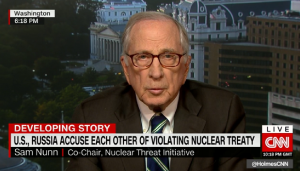
This was probably the first time most folks had ever heard of this Reagan-era arms control agreement that helped end the Cold War and kept Europe stable for a generation. Which may explain why the American public is not yet reacting to this disaster with the level of panic it deserves.
It’s tempting to think of treaties as little scraps of paper collecting dust on a historian’s bookshelf. Interesting, if you’re into that sort of thing, but largely irrelevant. The INF Treaty is something else entirely: This scrap of paper is a powerful leash, one of the few things restraining Russia and the United States (which together hold around 92% of the world’s nuclear weapons) from arms-racing us all into oblivion.


